

The Perfect 5 to 7 Days in Provence Itinerary
Last Updated on February 19, 2024
by Neota Langley
Disclaimer: This article contains affiliate links. That means if you click a link and make a purchase, we may make a small commission. As an Amazon Associate we earn from qualifying purchases. For more information, see our privacy policy.

Creating a 5 to 7 days in Provence itinerary may seem daunting but with so much on offer, it would be easy to miss out on some hidden gems. Provence is one of the most enchanting regions in France. Located in the country’s southeast, this picturesque region is known for its stunning landscapes, hilltop villages, and rich cultural heritage.
From the rolling hills of the Luberon to the dramatic coastlines of the Mediterranean, Provence is home to incredible natural beauty, history and charm and is a delightful region of Southern France.
Table of Contents
How Many Days in Provence?
While you can explore some of Provence’s towns and cities, such as Aix-en-Provence, in just 1-3 days, the best way to see this varied region is by taking 5-7 days to discover more of the natural beauty and hidden villages.
With 5 days in Provence, you can explore some of the region’s main attractions, tour the famous lavender fields and sample local cuisine in the charming towns.
If you have a little longer, spending 7 days in the area is the best way to get a natural feel for the area without feeling rushed. This way, you can enjoy the main attractions whilst taking your time to live the ‘joie de vivre’ in the Provençal sunshine.

Getting To & Around Provence
Getting to Provence is relatively easy, with a wide range of public transport options that serve the region’s towns and cities.
The main airports for accessing Provence are Marseille Provence Airport and Nice Côte d’Azur Airport. These are both major airports with a plethora of international flights available.
Several smaller airports serve Provence, including Avignon-Provence Airport, Nîmes-Alès-Camargue-Cévennes Airport, and Toulon-Hyères Airport. Depending on where you’re flying from, one of these airports may be a more convenient option.
The region’s buses and trains are efficient and affordable, connecting the major cities and towns. The high-speed TGV train is an excellent option for travelling between Provence and Paris or other parts of France. You can view train schedules here.
Once you have arrived in Provence, the best way to get around is by car and have a bit of a Provence road trip. If you need to hire a car, selecting a small vehicle is best, as the roads through the hills are narrow and winding. You can browse car hire options here.
Buses and smaller rail lines are available between connecting towns, but many villages and natural areas are only accessible by car, so public transport is not always a viable option.
However, that doesn’t mean hiring a car is a complete necessity. A wide range of full and half-day tours from the main towns allow you to hit the road and see the sights.

5 to 7-Day Provence Itinerary
Whether you are visiting Provence to explore the medieval towns and hilltop villages, see the iconic lavender fields or immerse yourself in the natural beauty of the surrounding national parks, this itinerary is your complete guide to making the most out of this spectacular region.
We have taken you on a journey of discovery from east to west, starting in Aix-en-Provence and ending in Avignon. Alternatively, depending on your preferred route, this itinerary can be followed backwards from west to east.
Whether you want to see Provence in 5 days or have an entire week to spend in this scenic region, there is something here for everyone. The summer is the best time to visit Provence, especially if you want to see the rolling hills covered in blankets of lavender.
Visit in the spring or autumn to avoid the crowds, but bear in mind, the main attractions are usually only open from April-October.
Day 1 – Aix-en-Provence
Aix-en-Provence is the perfect place to start on our journey through the region. Founded by the Romans in 123 BCE, Aix is incredibly charming, with bags of history and culture to discover alongside the beautiful natural surroundings. Although we will be based out of Aix-en-Provence for a few nights, it’s best to dedicate an entire day to this varied city.
The central hub of Aix is the Cours Mirabeau and the old town (Vieil Aix). Wander down the Cours Mirabeau to soak in this bustling town’s atmosphere.
This tree-lined avenue is home to some beautiful architecture, several iconic water fountains and classic Provencal cafes and bars where you can stop off for coffee, baked goods or regional wine. You can also take a walking tour of the Old Town.
The old town is just a stone’s throw from Cours Mirabeau. Wander through the cobbled streets in the morning (8 am-1 pm) to browse the local produce markets. From antiques to charcuterie, fresh fruits and vegetables to tablecloths and crafts.
Aix-en-Provence is recognised worldwide as the home of Paul Cezanne, a famous 20th-century post-impressionist artist. Here you can tour his last studio, Atelier de Cézanne, which is now a museum dedicated to Cezanne and his works.
Rising behind Aix, you can’t miss the towering Mont Sainte Victoire. An iconic landscape that inspired some of Cezanne’s most famous works. If you are an avid hiker, 250km of varied trails through the pine and eucalyptus forests surround the peak, or you can summit the mountain in around 2-3 hours.
This city is full of vibrant cafes, bars and restaurants. Try some of the regional cuisine in one of the many restaurants in the old town. Provencal cuisine blends classic French with other Mediterranean influences from Italy and Spain. You can also take a food tour to learn more about the city’s cuisine.
Choose between mouth-watering pizza and fresh pasta, delectable Spanish-style tapas, and traditional Niçoise dishes like the comforting ratatouille or the refreshing Niçoise salad. After dark, the city transforms, with late-night entertainment available in theatres, clubs and bars across the city.

Where to Stay in Aix-en-Provence
Hôtel Le Mozart – Mid-range visitors will love this 3-star hote in Aix. There are a number of comfy rooms to choose from, there’s a great breakfast on offer each morning and they have a great location for exploring the city and the Provence region as a whole.
Hôtel Cézanne – A design hotel in the centre of Provence, this is a lovely place to stay. There are several double and king rooms along with some suites to choose from. Breakfast is also available daily.
Aparthotel Adagio – Offering studio, one- and two-bedroom apartments, this is a great option for those after their own flat. They also have private parking, a good breakfast and a lovely garden to enjoy.
Not quite what you’re looking for? Click here to browse more Aix-en-Provence hotels!
Day 2 – Verdon & Lavender Fields
Day 2, and it’s time for a day trip from Aix. Weave up through the hills, sprawling vineyards and lavender fields in full bloom.
If you are looking for the perfect opportunity to photograph the iconic lavender fields, the area around the Valensole Plateau has the highest concentration of purple blooms with stunning backdrops of crumbling stone huts, gnarled trees and rolling hills.
Follow the D6 through the plateau, and you are guaranteed to stumble across some of the best photo locations. Keep an eye out for clusters of cars pulled over in laybys – it’s usually a sign that the perfect capture is a short walk away.
Stop off in Valensole for lunch, followed by a sample of some lavender gelato before continuing to the Verdon Gorge.
If you don’t have a car or want to discover the most famous lavender fields without hunting for them, several tours are available from Aix-en-Provence such as this half-day tour or this full-day tour .
The Verdon Gorge is a natural wonder known for its towering cliffs that fall into the turquoise waters of the Verdon River. It is the deepest gorge in France, and its stunning landscapes make it a popular destination for outdoor enthusiasts, hikers, and nature lovers.
Park your car beside the Pont du Galetas. Standing up on this tall bridge, you can catch a glimpse of the gorge, but the best way to explore the winding river is on the water. Vendors offer kayaks, paddleboards, and pedalos. Bear in mind during the summer months, the water can get low, so you may only be able to traverse part of the length.
Whilst the Verdon Gorge is not accessible via public transport, you can take a full-day tour from Aix. Spend the morning discovering the lavender fields, then enjoy an afternoon on the sparkling turquoise waters.

Day 3 – Calanques and Cassis
A trip to Provence would only be complete with a trip to the stunning Mediterranean coast. The Calanques National Park stretches for 20km along the rugged coastline, with plenty of hikes and secluded beaches to discover along the way.
Start your day in Cassis, a traditional fishing port town on the eastern edge of the Calanques. You can explore this quaint town on foot within an hour, so arrive early and stroll along the marina, coffee and croissant in hand, before heading out into the national park.
There are endless trails to explore with towering cliffs, crystal clear waters and hidden villages. Head out on the Calanques de Cassis trail to see the best bits of this varied landscape in a day hike.
Starting in Port Pin, the trail meanders along the coast, eventually reaching the Calanque d’En Vau. Famously known as one of the best beaches in France, you will be treated to idyllic white sands, turquoise waters and towering cliffs with deep caves.
Allow around 3 hours to complete this hike, with added time to enjoy a picnic and take a dip in the azure sea. You can also take an organised hike if you prefer to go with a guide.

Day 4 – Luberon Valley Villages
The Luberon Valley lies to the west of Aix-en-Provence on the way to our next destination, Avignon. However, this stunning valley with its hilltop villages is more than just a through road.
Made up of three mountain ranges, this ancient valley is surrounded by sprawling vineyards, lavender fields, historical sites and charming hilltop villages. Five of these villages have official’ Les Plus Beaux Villages de France’ status (most beautiful villages in France), and it’s not hard to see why.
You could easily spend more than one day exploring these hidden gems, but for this Provence itinerary, we will visit the top 3 villages in one day en route to Avignon.
Our first stop is the Bonnieux, with panoramic views across the valley. Wander through the cobbled streets to reach the church, offering some of the best views across Mount Ventoux and beyond.
Stop in on the various art galleries that line the streets, or, for the baking fanatics, Bonnieux is home to the fascinating Boulangerie Museum, housed in a 17th-century building. There is no doubt that this is one of the most charming villages in Provence.
Next is the ‘Orange Town’, Roussillon. Nestled in an ochre ridge, this charming town is built using the surrounding stone, giving it a remarkable orange tint. Wander through the picturesque streets to discover the local crafts, galleries and cafes.
If you want to get a closer look at the vibrant rock surrounding this town, the ochre trail hiking path is a great way to get up close and personal with the quarries towering orange cliffs and deep canyons. There are two options for this walk, one 50 minutes and the other just 30 minutes. Just don’t wear any white as the minerals tend to stain.
The final village on our whistle-stop Luberon Valley tour is Gordes. The crown jewel of Luberon, we’ve saved the best for last. The cobbled streets are often used as film sets as they ooze classic Provencal charm. Discover a fortified castle, top-end restaurants and wine terraces, the local produce market (Tuesdays) and a contemporary art museum.
Don’t miss the Sénanque Abbey, situated on the town’s outskirts. This 12th-century Abbey is still home to a community of Cistercian monks. Famous for its picture postcard setting, surrounded by blooms of purple lavender, it’s more than just a photo opportunity. Head into the Abbey to discover the ancient history and various lavender-based produce available in the shop.
We end the day in Avignon, the perfect base for exploring the western side of Provence. Head out to dinner in the town centre to get a feel for this charming settlement before we discover more in tomorrow’s itinerary.

Where to Stay in Avignon
Hotel Boquier – This cosy hotel is perfect for mid-range visitors to Avignon. Located in the centre of the city, they have a number of lovely rooms to choose from, on-site parking and a great breakfast available each morning.
Hotel De Cambis – Those looking for a little luxury during their Provence itinerary will love this plush hotel. Well-located for exploring Avignon, they have a range of wonderful rooms to choose from, daily breakfast and amenities like a restaurant, bar and room service to enjoy.
Chapelle du Miracle – For travellers after a private flat in Avignon, then these apartments are a good option. There are a number of flats to choose from, all fully furnished with everything you may need and they’re located in an excellent location for exploring the city.
Not quite what you’re looking for? Click here to browse more Avignon hotels!
Day 5 – Avignon
Surrounded by towering mediaeval ramparts, Avignon is steeped in history. The town centre of Avignon is a UNESCO World Heritage Site and it is an essential stop on any trip through Provence.
The city is best known for the Palais des Papes. This imposing Gothic palace served as the residence of several popes during the 14th century. Today, the Palais des Papes offers visitors daily tours providing a fascinating glimpse into the history and culture of the region.
Another iconic landmark in Avignon is the Pont d’Avignon, the remains of a picturesque bridge spanning the Rhône River.
Made famous by a catchy French song, ‘Sur le Pont d’Avignon’ (dancing on the Pont d’Avignon), only 4 of the original 22 arches remain. Washed away by the force of the Rhone, several attempts were made to rebuild the bridge, but it was abandoned in the 17th century.
Avignon is a foodie’s dream, with several Michelin-starred restaurants and high-quality budget-friendly options available. Showcasing the best of French cuisine, for a special treat, try La Mirande, holders of a regular Michelin star alongside a ‘green’ star for sustainability efforts.
For a more budget-friendly option, try EAT, a modest restaurant offering local cuisine just a short walk from the Pont d’Avignon.
If you only have 5 days in Provence, Avignon is the perfect place to round off your trip with several onward travel options available from the nearby high-speed TGV train station.

Day 6 – Arles & Camargue National Park
Day 6 begins in Arles , a historic city known for its Roman ruins and artistic heritage. Begin with a visit to the Amphitheatre, an ancient Roman arena that once held up to 20,000 spectators.
From there, you can head up to the nearby Roman Theatre, which features stunning views of the city and the surrounding countryside.
Vincent Van Gogh is arguably one of France’s most famous artists. He produced several of his most famous works while living in Arles. Here you will find a museum dedicated to his works, including a self-portrait and a Provencal landscape scene.
After spending the morning exploring Arles, make your way to the nearby Camargue National Park, a unique natural area known for its wildlife and beautiful natural marshlands. This region is home to one of the most ancient horse breeds, the Camargue pony and the iconic horned Camargue cows.
Spend the afternoon exploring the sandbanks, one of the only places in Europe you can see wild Flamingos. There are plenty of laybys and wildlife hides where you can stop and watch these pink birds resting on one leg.
You can explore the narrow roads by car, but the best way to fully immerse yourself in the wilderness is by bike. There are several hire locations on the edges of the National Park, and the roads often have dedicated cycle lanes. There are also some day tours from Avignon such as this half-day tour.

Day 7 – L’isle-sur-la-Sorgue
To round off the perfect one week in Provence, our last stop is the ‘Venice of Provence’, L’isle-sur-la-Sorgue. Located just 30 minutes from Avignon, this charming market town is technically an island in the middle of the River Sorgue, connected by scenic bridges lined with brightly coloured blooms.
L’isle-sur-la-Sorgue is often referred to as Europe’s antique capital. Along with the temporary brocants, there are plenty of antique and vintage stores down every alley. You could easily spend the entire day hunting for vintage treasures.
If you can, visit on a Sunday (which is market day) to experience one of Provence’s best markets, with over 300 vendors selling everything from local produce to antiques, pottery, and baked goods.
Just outside of L’isle-sur-la-Sorgue, on the road back towards Avignon, there is a little hidden gem worth a stop. The Grottes de Thouzon is a dramatic cave full of incredible stalactites and stalagmites. You can enter the cave on the 45-minute guided tour, where you will learn more about the geology and the accidental discovery of the cave.
If you are heading back towards Aix-en-Provence instead of Avignon , stop off at the Fontaine de Vaucluse. Here you will discover the source of the Sorgue, a mysterious natural spring.
No one knows exactly how deep this spring is, but during heavy rainfall, up to 200,000 litres of water rushes out every second making it one of the largest springs in the world.
You can rent a kayak from the village to paddle up the river or walk on one of the many trails that snake up through the woods.

Have More Time?
7 days is plenty of time to soak in the golden sunshine, fill your camera roll with photos of ancient buildings, lavender fields and hilltop villages and enjoy some of the South of France’s finest cuisine. However, if you have more time to enjoy this magnificent region, keep reading to find out what else you can see and do in the surrounding area of Provence.
Châteauneuf-du-Pape
Located just 20km north of Avignon, Châteauneuf-du-Pape is one of the most famous wine regions, known for its bold Grenache-based reds. Protected by AOC status, 3,000 acres of vineyards across the scenic valley produce this iconic wine.
Of course, the most popular activity in this area is a vineyard tour and wine tasting. There are several options available to discover the wine for yourself. You can opt for a self-guided tour or book a comprehensive, organised tour. If you want to visit just one shop, head to the central Vinadéa.
This wine shop offers free tastings with over 250 variations to choose from. Or, wander through the vineyards surrounding the village, stopping off at tastings along the way.
Pont Du Gard & Nimes
Provence is home to some of the best-preserved Roman ruins in the world. The Pont du Gard is a stunning Roman aqueduct just outside of Nîmes. Built over 2,000 years ago, it is one of the world’s most impressive and well-preserved examples of ancient Roman engineering.
The aqueduct was constructed in the 1st century CE to carry water over 50 kilometres from the Eure River to Nîmes. Today, Pont du Gard is a popular tourist destination. You can walk across the top of the aqueduct, which offers stunning views of the surrounding countryside, or take a guided tour to learn more about the history and engineering.
Inside the city of Nimes, there are plenty of Roman ruins to discover. One of the most famous landmarks in Nîmes is the Arena of Nîmes. This Roman amphitheatre was built in the first century CE. The arena’s exterior showcases a series of arches and columns, typical of Roman architecture. You would be forgiven for thinking you had teleported to Rome!
To learn more about Provence’s ancient Roman history, head across the street to the Maison Carrée. This temple is one of the best-preserved Roman buildings in the world and is now home to a museum showcasing the city’s history.
If city hopping is your thing, Marseille is the third-largest city in France. Located on the Mediterranean coast, this city is known for its rich history, beautiful architecture, and stunning coastal landscapes.
One of Marseille’s most iconic landmarks is the Basilique Notre-Dame de la Garde, a stunning Catholic basilica perched on a hill above the city. Other must-see sights include the Old Port, a bustling harbour that has been a centre of commerce and culture for centuries, and the historic Panier neighbourhood, known for its colourful streets and arts scene.
Marseille’s trade history has heavily influenced its vibrant food scene, an eclectic mix of traditional French cuisine and North African and Middle Eastern flavours. Marseille also is poised as a good jumping-off point if you want to explore the French Riviera .

Provence is a must-visit destination in the South of France. Whether you are a nature lover, wine enthusiast, city hopper, history buff or all of the above, this region has something for everyone. Visit Provence in 7 days to make the most of the sights and activities, but don’t worry if you only have 5 days to spend. You can easily adapt this itinerary to suit any schedule.
Are you planning to visit Provence? Have any questions bout this itinerary? Let us know in the comments!

Related Posts:

The Perfect Versailles Day Trip from Paris

The Perfect 1, 2 or 3 Days in Aix-en-Provence Itinerary

Is Paris Expensive? A Paris Trip Cost Guide

About Neota Langley
Neota is a writer for The World Was Here First. Born and bred in Cornwall, she can usually be found with hiking boots on, ready to embark on an adventure. For the last 6 years, she has travelled throughout Europe in her self-built campervan with her trusty canine companion, Ivy. She loves exploring France, the Nordics and spending time in Alpine destinations.
Your article on the perfect 7 day itinerary in Provence sounds magical and the perfect way to see a region. We plan on visiting in Dec ’23 with 2 kids (4 years and 9 years old). Would you still recommend it?
Leave a Comment Cancel reply
Flight search
- Adults Remove adult 1 Add adult
- Children Aged 2-11 Aged 2 to 11 Remove child 0 Add child
- Infants In seat Remove infant in seat 0 Add infant in seat
- Infants On lap Remove infant on lap 0 Add infant on lap
- Premium economy
Cheap flights from Aix-en-Provence to Rome
Good to know, when is the cheapest time to fly, popular airports near aix-en-provence.
- Marseille Provence Airport (MRS) Marseille 25 min 21 km
- Nice Côte d'Azur Airport (NCE) Nice 1 hr 50 min 142 km
- Lyon-Saint Exupéry Airport (LYS) Lyon 3 hr 2 min 245 km
- Montpellier-Méditerranée Airport (MPL) Montpellier 1 hr 43 min 120 km
Popular airports near Rome
- Leonardo da Vinci–Fiumicino Airport (FCO) Rome 48 min 22 km
- Giovan Battista Pastine International Airport (CIA) Rome 37 min 14 km
- Naples International Airport (NAP) Naples 2 hr 26 min 188 km
- Amerigo Vespucci Airport (FLR) Florence 3 hr 11 min 236 km
Frequently asked questions about flying from Aix-en-Provence to Rome
Search more flights, popular trips from aix-en-provence.
These suggestions are based on the cheapest fares to popular destinations in the next six months.
Prices include required taxes + fees for 1 adult. Optional charges and bag fees may apply.
- London RUB 2,999 Oct 10 — Oct 14 Nonstop 2 hr Ryanair
- Lisbon RUB 6,249 Dec 7 — Dec 9 Nonstop 2 hr 25 min Ryanair
- Barcelona RUB 4,801 Nov 22 — Nov 25 Nonstop 1 hr 10 min Volotea
- Venice RUB 5,802 Dec 5 — Dec 8 Nonstop 1 hr 25 min Volotea
Find flights from Aix-en-Provence to anywhere
More places to fly.
🙌 Awesome, you're subscribed!
Thanks for subscribing! Look out for your first newsletter in your inbox soon!
Get us in your inbox
Sign up to our newsletter for the latest and greatest from your city and beyond
By entering your email address you agree to our Terms of Use and Privacy Policy and consent to receive emails from Time Out about news, events, offers and partner promotions.
Awesome, you're subscribed!
The best things in life are free.
Sign up for our email to enjoy your city without spending a thing (as well as some options when you’re feeling flush).
Déjà vu! We already have this email. Try another?
Love the mag?
Our newsletter hand-delivers the best bits to your inbox. Sign up to unlock our digital magazines and also receive the latest news, events, offers and partner promotions.
- Things to do
- Restaurants
- Los Angeles

20 travel tips every first-time Rome visitor should follow
Whether you are a Roman novice or expert, these travel trips for Rome should be followed at all times

Don’t get us wrong, Rome is a very friendly place. But it’s not always the easiest to navigate. And unless you want to find yourself waiting for a coffee for three hours or queueing for the Vatican for three hours, there are some things you should know before you go.
And don’t panic. Our local writer Livia Hengel has the inside scoop on every rule, custom and hack for the big city. If you want to absolutely smash a weekend in Rome, read this list (and read it before you go. Trust us). Here is every travel tip you’ll need to do Rome as the Romans do.
RECOMMENDED: 📍 The best things to do in Rome 🍝 The best restaurants in Rome 🏛️ Unmissable attractions in Rome 🛍️ Where to go shopping in Rome 🏨 The best hotels in Rome
Livia Hengel is a writer based in Rome. At Time Out, all of our travel guides are written by local writers who know their cities inside out. For more about how we curate, see our editorial guidelines .
Been there, done that? Think again, my friend.
Travel tips for visiting Rome
1. don’t order a cappuccino after noon.

You may or may not have seen this one crop up on TikTok from time to time. But basically, don’t you dare order a cappuccino after noon. Cappuccinos are thought of as heavy drinks more suitable for breakfast, and paired with a cornetto. If you’re craving one in the afternoon, order a caffè macchiato instead.
2. …But gelato is acceptable any time, any season

Great news for gelato lovers. You can order one of these bad boys anywhere, anytime. Before lunch, after lunch, whatever you desire. The gelato world is your oyster in Rome, and their flavours change seasonally, so you’ll never get bored. Think ciccolato fondente (dark chocolate), pistacchio and mandorla (almonds). Delicious.
3. Buy Vatican tickets online to skip the line

Housing one of the world’s greatest collections, the Vatican Museums are one of Italy’s most popular attractions, visited by over 5 million people annually. Though you’ll inevitably face a crowd, you can skip the long lines by purchasing your museum tickets on the Vatican website. The extra Euros for booking online are well worth the time you’ll save by not waiting in line.
4. Free museums on first Sundays

Rome’s state-owned museums, galleries, archaeological sites, parks and gardens are free on the first Sunday of each month, so be sure to drop by and soak in some art if you’re in town these days. Lines quickly form outside the main attractions, so plan to show up early or visit a lesser-known destination (warning: you’ll still need to pay a fee to browse through special exhibitions).
5. Note museum closures

Many of Rome’s city and state-owned museums, like Galleria Borghese and Palazzo Barberini, are closed on Mondays, so plan your schedule accordingly. The Vatican Museums are closed on Sundays instead, so they’re very crowded on Saturdays and Mondays; if you can, try to visit Tuesday through Friday.
6. Order coffee at the bar

Have you guessed the Italians are quite particular about their coffee yet? Coffee etiquette actually makes up a fair few of the biggest culinary crimes you can commit in the capital. You might notice people in Rome tend to order an espresso and drink it standing up, before even leaving the bar. That’s the way things are done. Italians don’t order coffee from the table and have it brought to them, and in fact, that’ll likely slap you with service charge and almost double your bill. Do as the Romans do, and neck that espresso before you go anywhere.
7. Buy bus tickets ahead of time

Rome’s public transportation leaves much to be desired, but if you need to take a bus in the city centre, stock up on bus tickets ahead of time because you can’t buy them on the bus. You can buy tickets at any tabaccheria in the city, little convenient shops that are designated with a large T. Tickets are €1.50 each, or opt for a 24-hour, 48-hour or weekly ticket for a discounted price. Tickets are valid for all forms of public transportation in Rome (bus, metro, tram and local train).
8. Take your bus ticket straight to the beach

Speaking of public transportation, your €1.50 ticket is also valid on the local commuter trains in Rome, including a line that goes straight to the beach. You can catch a train at the Piramide Metro Station that will take you directly to Ostia Lido, Rome’s local beach. Although it’s not the most glamorous beach near Rome, Ostia is perfect for an inexpensive day trip, with some sunshine and fresh seafood.
9. Dress modestly in church

Rome has over 900 churches that house some of the city’s most beautiful works of art, so don’t miss stepping inside to marvel at their treasures, whether you’re devout or not. Just be sure to dress appropriately to enter these holy spaces: women’s shoulders should be covered, and skirts should hit at or below the knee, while men should wear pants or shorts that extend to the knees. Linen pants are a great option for the summer, and a scarf is a perfect last-minute cover-up if you’re wearing a tank top.
10. Watch your bags

Always be mindful of your bags on public transportation and around key tourist attractions. The city is safe, but petty crime is rampant, especially on crowded buses and metros. Thieves in Rome are stealthy, so always keep your bags zipped and held in front of you; wallets should ideally be tucked in your inner jacket pockets. Some thieves also snatch bags, so keep them in close reach at all times.
[image] [title]
Discover Time Out original video
- Press office
- Investor relations
- Work for Time Out
- Editorial guidelines
- Privacy notice
- Do not sell my information
- Cookie policy
- Accessibility statement
- Terms of use
- Modern slavery statement
- Manage cookies
- Advertising
- Time Out Market
Time Out products
- Time Out Worldwide
- Android app
- Search Please fill out this field.
- Manage Your Subscription
- Give a Gift Subscription
- Newsletters
- Sweepstakes
How to Plan an Unforgettable Trip to Rome, According to Local Experts
Whether your tastes swing towards art and architecture, high-end shopping and dining, or browsing markets and munching on street food, it’s an exciting time to visit Rome.
:max_bytes(150000):strip_icc():format(webp)/Lizprofilepicedited-d2f76e0cdf6a40508776c07f8d541acc.jpg)
Best Hotels and Resorts
Best things to do, best shopping, best nightlife, best restaurants, best time to visit, how to get there, how to get around.
Alexander Spatari/Getty Images
For me, the Eternal City is eternally fabulous. No matter how crowded it gets, how dysfunctional its current government is, or how many bad pizzas there are in ratio to good ones, Rome remains. It’s persisted and resisted for more than 2,775 years, and even at this ripe old age, Rome is still evolving.
It’s an exciting time to visit Rome, and even for people who live there, the flurry of post-pandemic activity in the travel sector has been dizzying. “Archaeological sites that have been fenced-off for years are now accessible to visitors, there’s a host of innovative new tour options, and I can barely keep up with the number of absolutely stunning luxury hotels that have opened ,” says Travel + Leisure contributor and Rome resident Laura Itzkowitz, who also writes about Rome in her newsletter, The New Roman Times . “It’s a delight to see so much investment in the city and so many new ways to experience it.”
No matter how you decide to see the city or whether your tastes swing towards art and architecture, high-end shopping and dining, or browsing markets and munching on street food, Rome gives you options. We asked Itzkowitz and some other Rome travel experts to weigh in on their favorite places and experiences to recommend in eternal Rome.
Top 5 Can’t Miss
- Swoon over the cityscape. Few things are as romantic as Rome at night from a vantage point like the Fontana dell'Acqua Paola or the Capitoline Hill.
- See marble turn to flesh. At the Galleria Borghese, Bernini’s lifelike sculptures are a gazillion times more impressive than what you remember from art history class.
- Do the Full Monty of Italian dining. Bring your appetite and go big, with antipasto, pasta, main course, and dessert at a homey trat like Da Enzo da 29.
- Get up early. At least once during your stay, request an early wake-up call to discover a deserted city. ArcheoRoma can lead the way.
- Shop at a market. If you don’t buy produce, trinkets, or street food at a real Roman market like Testaccio or Campo de’ Fiore, have you been to Rome?
Courtesy of Bettoja Hotels
Palazzo Vilòn
If there’s one thing our experts agree on, it’s that Palazzo Vilòn luxury apartment is the most sumptuous new address in Rome. Nicole Bono, luxury travel and events planner with Bono Events International says, “When they open the doors for you, your jaw will drop.” Gary Portuesi, a T+L Top Travel Advisor with Authentic Explorations , says that at Vilòn, “you get to live like a Roman aristocrat in an intimate palazzo in the best neighborhood.”
Singer Palace
“I'm in love with the Singer Palace these days,” says Bono of this 19th-century beauty in the former Singer sewing machine headquarters. “It's family-owned, and that is felt with every single detail in this property. You're truly cuddled from the moment you walk in the door till your last Spritz before you leave.”
Hotel de Russie, a Rocco Forte Hotel
T+L readers’ favorite hotel in Rome is also a hit with Portuesi, who raves about its “with its unique and secluded Mediterranean tiered secret garden walking distance from the Spanish Steps, Fontana di Trevi and Piazza del Popolo.” The hotel’s Stravinskij Bar remains one of Rome’s most elegant locales for a cocktail.
Hotel Mediterraneo
Every time I exit Termini Station, I sigh with comfort at the sight of this trusty four-star in a fascist-era Art Deco building. Stepping through the doors feels like stepping back in time, in a good way, with old-school service, a delightful lobby bar, and humongous suites, some with skyline views of Rome.
Christopher Larson/Travel + Leisure
Basilica di San Clemente
For a real sense of how Rome’s history is layered like a lasagna, head to this church near the Colosseum — or rather, underneath it. An atmospheric archaeological area beneath the not-too-shabby 12th-century church holds an even earlier Christian church, which lies on top of a pagan altar and an ancient Roman apartment building.
ArcheoRunning
If you’re a runner, join archaeologist, guide, and running enthusiast Isabella Calidonna on an early morning jogging tour through Rome's truly magical empty streets. (Trust me, it’s okay if you run slowly.) If you’re not a runner, don’t sweat it — she’ll be happy to do the same informative tour at a walking pace.
Via del Governo Vecchio
Spend a late afternoon vintage shopping on my favorite street in Rome , then stick around for an aperitivo, followed by pizza and gelato. If that trifecta of Roman drinking and eating isn’t enough, this splendid street near Piazza Navona has a buzzy but manageable bar-hopping scene.
Largo Argentina
Want to stand at the very site (or very near it, anyway) where Julius Caesar lost his life? Long visible only from street level and best known as a cat sanctuary among picturesque ruins, the archaeological area at Largo Argentina site is now open to the public, thanks to funding from Bulgari . The Curia of Pompeo, where Caesar got shivved, stands near the ruins of four ancient temples.
Galleria Borghese
Reserve your tickets in advance and prepare to be overwhelmed by the beauty here, both of the ornate salons of this noble palace turned art museum, and the amazing works inside, including Bernini’s spellbinding "Rape of Proserpine" and several Caravaggio paintings.
Testaccio Market
This sprawling covered market in the working-class Testaccio neighborhood offers an authentic slice of Roman daily life. Even if you’re not shopping for clothing, produce or fresh fish, stop for some of Rome’s best street food, especially a suppli at Food Box or a drippy panino at Modri e Vai.
Itzkowitz is a fan of this artisan jeweler in Monti and even had owner Antonio design a pair of custom earrings for her wedding. If you don’t have time for a made-to-order bauble, the shop has many original designs, many of which feature colorful gemstones.
Essenzialmente Laura
For a real only-in-Rome gift or souvenir, Portuesi refers friends and clients to the perfumery of Laura Bosetti Tonatto, who’s made custom scents for celebrities, royals, and aristocrats, including Queen Elizabeth II. “You can create your own perfect perfume or find the scent you love,” he says.
La Bottega del Marmoraro
It’s hard to imagine a store like this anywhere else — a tiny workshop on pretty Via Margutta where stone carver Sandro Fiorentino tinks away at marble plaques by hand. “I love to bring out-of-town visitors here,” says Itzkowitz. “Prices start at around 15 euros, which means you can find an affordable, handmade souvenir.”
Courtesy of Hassler Hotel
Fontana dell'Acqua Paola
Some of the best things in Rome are free, including the views from this monumental fountain high on the Janiculum hill. It’s one of T+L’s top underrated things to do in Rome . Fans of the Oscar-winning film “Rome, the Great Beauty” will recognize this majestic spot.
This classy bar offers great cocktails and light bites with a sublime view. “A table there in the stunning Piazza di Pietra,” says Bono, “with the incredible Roman columns all lit up is truly magical, and it feels like it's just there for you."
Hassler Hotel 7th Floor Terrace
The recipe for an unforgettable Roman evening: Start with panoramic city views from atop the Spanish Steps, stir in a specialty cocktail, garnish with some elevated aperitivo fare, and drink it all in at one of our favorite family-run hotels in Italy and one of the absolute best in Rome.
Da Enzo da 29
Despite its near-legendary status and the long lines for a table (Enzo doesn’t take reservations), Itzkowitz says a meal here is “worth the wait and lives up to the hype — every time.” She’s a fan of the handmade tonarelli cacio e pepe but says that the food here is consistently good across the menu.
Trattoria Da Cesare Al Pellegrino
This new-in-2023 sister property of a neighborhood favorite in residential Monteverde brings hearty, traditional Roman pasta and meat dishes to the centro storico. “Run, don't walk,” says Bono, “because this city location is super charming, and tourists haven't found it yet.”
Pro Loco Pinciano
Portuesi says you’ll feel like a local at this super-casual pizza and pasta joint just outside the city walls, where the emphasis is on ingredients and wines sourced from the surrounding region on Lazio. Charcuterie platters are delicious and abundant here.
L'Antica Pesa
Regularly named one of the best restaurants in Rome, this Trastevere culinary landmark is, per Portuesi, “a standard and consistent classic” and worth crossing the river for. Head here for a special dinner or when you’re ready to go big (before going home, maybe?) and order an appetizer, pasta (primo), meat, and dessert for the full Italian dining experience.
You’ve heard all the warnings about visiting in high summer, but if that’s the only time you have to visit, Itzkowitz says to do as the Romans do: rest in your cool hotel room in the afternoon and venture out again in the early evening. Bono agrees that summer can be...sticky but adds, “Those summer sunsets on a rooftop with an Aperol spritz certainly make for that 'Dolce Vita moment' we all crave.”
Portuesi recommends November, as it’s still relatively warm and the crowds have thinned out; January, when sale season starts; or April and October. “Tourists might still be there, but the colors of spring and autumn are amazing, and temperatures are on the warm side.” I love visiting in January or February when the crowds are much more manageable, and if you’re lucky, you can catch some lovely, crisp, sunny days.
Most visitors fly into Rome’s Leonardo da Vinci/Fiumicino Airport (FCO). From there, you can take a 30-minute non-stop train to Termini, the central station, and take a taxi, Metro, bus, or tram to your accommodation. A cab from FCO to anywhere inside the Aurelian Walls costs 50 euros. Ride-sharing services other than Uber Black are not available in Rome.
Rome’s historic center is primarily flat and highly walkable. Many visitors take the Metro to reach the Vatican Museums, then walk back into the city from there (or take a cab from St. Peter’s Square).
Buses and Metro, both run by ATAC , are also reliable ways to get around, though depending on the distance, walking may be faster. Note that taxis in Rome cannot be hailed on the street. Instead, they wait at taxi stands or ranks generally located near tourist areas.
I strongly recommend against renting a car in Rome, as traffic and parking are a mess and the centro is a maze of one-way streets, many of which are pedestrian-only. If you pick up a car in Rome for a more extended tour in Italy, make sure you have your route mapped out in advance — and nerves of steel.
Related Articles
- Skip to main content
- Skip to primary sidebar
- Skip to footer

Italy Travel Experts Tours and Vacations
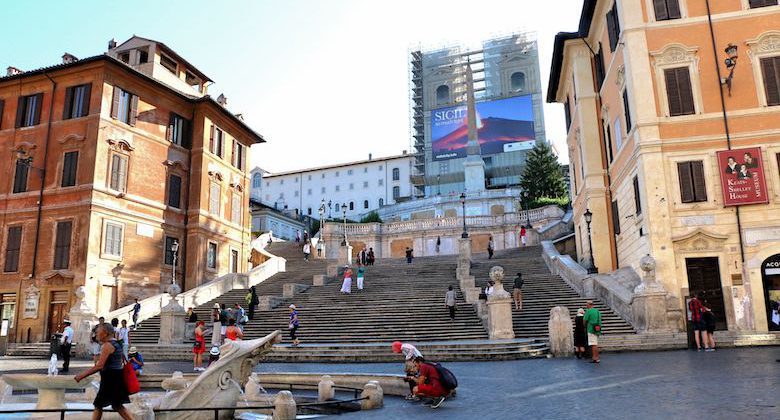
The Complete Guide To Planning Your Trip To Rome: Tips, Restaurants, and More
Sean Finelli Last Updated: August 29, 2023
Traveling to Rome for the first time? Nobody wants to pick a hotel in the wrong part of town or sit down at a bad restaurant. The good news is you’re reading this article, so you won’t have these problems! This guide will cover some of the Rome basics and links to a ton of great resources to make planning your trip to Rome easy and fun.
Pro Tip: Bookmark this post and other helpful articles, like where to stay in Rome in a trip folder on your browser so you can quickly find them when you need them. Rome is an expansive city worthy of a tour or two, explore our top-rated Rome tours and experiences . Also, check out our other resources on planning your trip to Rome .
How To Plan Your Trip To Rome: A Complete Guide
In this guide, you’ll find everything you need to know to plan a memorable vacation in the Eternal City, with plenty of additional resources to explore. From the logistics of where to stay and how to get around the city to the finer details of how to get your coffee, basic Italian phrases, and top things to do, we’ll help you prepare for your dream trip in Rome.
- Airports and Public Transport (Metro)
- Where To Stay
- Things To Do
- Food Culture
- Credit Cards, Tipping, and Communicating
When To Travel To Rome and What To Pack
Rome airports and public transport, rome airports.
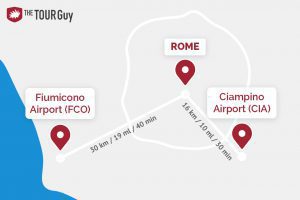
There are two main airports in Rome, Ciampino and Fiumicino, and they are both roughly the same distance from the city center.
Fiumicino (FCO)
In short, to get from Fiumicino Airport (FCO) to Rome’s city center, the train is the most popular means of transport, taxi is the most convenient, and the bus is the least popular.
By far, the most popular way to get from Fiumicino airport to the city center is by train. For €15, you can get the Fiumicino Express from FCO to Termini station (main station).
A taxi is the most convenient way to get to the center. There are regulated rates from the airport to the city center that fall between €45 – €50, depending on a few difficult-to-explain criteria, such as what type of license the taxi has. If you’re staying outside the historic center of Rome, you may also have to pay more or less. You can normally pay with a credit card in taxis but always ask.
Ciampino (CIA)
The bus is the most popular way to get from Ciampino Airport (CIA) to the city center. Buses tend to cost around €6 – €7, depending on the airport and the coach company. They run based on arrivals. Terravision has been around for a long time and is pretty cheap.
Taxi, again, is the most convenient. They cost between €35 – €45 depending on the same factors mentioned above, which are difficult to understand.

Rome Transportation Options
Rome has plenty of transportation options. How you decide to get around Rome on any given day on your trip will depend on your preferences, what you have planned to do, and where you’re going. We’ll go over all of them:
Walking in Rome
Rome is an extremely walkable city. If you’re in reasonably good shape and the weather isn’t overly hot, you can walk Rome’s historical center very well. However, the streets can sometimes be confusing. If you aren’t using a mobile map app, it could get tough.
The Colosseum is a 35-minute walk from the Piazza del Popolo and around a 60-minute walk from the Vatican Museums Entrance. However, it’s important to pick your battles. For example, you may not want to walk to the Vatican from the Colosseum, considering that you’ll be on your feet for at least three hours when visiting the Vatican Museums with a guided tour. Some of our top-rated Vatican tours last up to 5 hours to give visitors an enriched experience of the museums. In this case, it might be better to take the subway or even a taxi to conserve energy.
That said, be prepared to walk when you’re in Rome. If you aren’t already doing so, walk at least an hour each day to get your legs ready for your trip!
Rome Bus System
We have a great video on what you need to know to use the buses in Rome . It’s a little dated but fun to watch, and you’ll see exactly where to get bus tickets, how to ask for one, and how to conquer Rome’s bus system. There are three fundamentals that you need to know when using the buses:
- Buy a ticket before you get on and validate it when you’re on the bus.
- The bus signs are pretty confusing unless you know the city really well. So, download an app .
- The buses go literally everywhere. They’re a good option but get hot and crowded in the summer—just something to keep in mind.
Walking around Rome can get really tiring. Hopping on a bus for a kilometer or two can make all the difference. Save your energy for the highlights of your trip.
Rome Metro (Subway) System
The Roma metro system has two lines: the red A-line and the blue B-line. As a visitor, you’ll find yourself on the A-line the most. It goes from Termini past the Trevi Fountain, Spanish Steps, Piazza del Popolo, and most importantly, the Vatican.
The B-line will get you from Termini Station to the Colosseum and Circus Maximus. These are the most popular stops for visitors using the metro to get to Rome’s top attractions .
You can’t get to Trastevere by metro, but you can get close to Testaccio by getting off at Piramide. Both Trastevere and Testaccio are known for their lively nightlife and great food. Your hotel and most Airbnbs will have a metro map that you can keep handy.
Getting a Taxi in Rome
I use public transportation for short, direct rides to get from place to place. For example, going from the Vatican to the Spanish Steps or from Termini Station to the Colosseum. For anything complicated, I normally pony up and take a taxi. They’re relatively cheap if they don’t rip you off—which they will try to do.
A good workaround is to search for your destination in your phone’s map app, get directions from your current location, and hit go. Then, show that map to the taxi driver when they ask where you want to go. This way, they know you’re tracking. Otherwise, there’s really nothing you can do. Just don’t pre-negotiate the rate. There’s a meter in the vehicle that determines the cost.
Renting a Scooter in Rome
If I’m in Rome for more than a couple of days, I’ll rent a scooter. It’s a good option if you have scooter experience. If you don’t, I wouldn’t recommend it. It can be dangerous getting around an unknown city when you don’t even know how to drive the thing, let alone negotiate traffic and figure out where to go.
Where To Stay in Rome
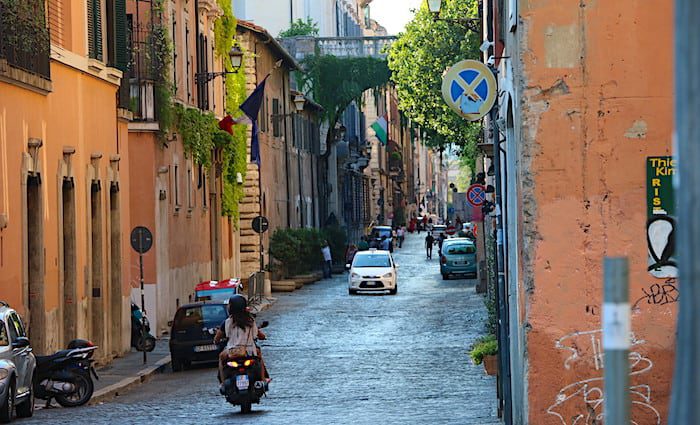
Rome is a large metropolitan city, but the area most visitors are interested in is the historical center or Centro Storico because it’s pretty condensed. You can walk from the Colosseum to the Vatican, almost on opposite sides of the historical center or “center” for short, in an hour.
The center is the place to be in Rome, and each neighborhood is really great. I prefer the northern sections like Piazza Navona and Spanish Steps. To me, they are classical Roman/Italian and super nice. Here are the best areas to consider with links to in-depth neighborhood guides:
- Spanish Steps
- Pantheon/Piazza Navona
- Prati (Vatican)
Again, I really like anything near the Spanish Steps, as I like being in the thick of it. It will come with a price tag, but savvy travelers find deals. Check out our in-depth guide on where to stay in Rome, covering the city’s best neighborhoods.
Top Things To Do in Rome
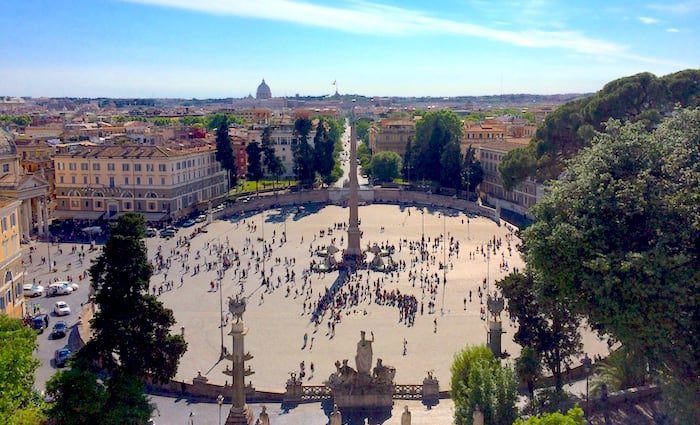
From visiting the Sistine Chapel to an underground apothecary run by priests, there are unlimited things to do in Rome. One of the best ways to see a city with this kind of history is to join local guides on fun tours with exclusive access and endless stories to tell. There are so many things to see and ways to see them. Check out all our Rome tours that include the top monuments and museums, plus incredible day trips.
This is a list of the top things to do while you’re in the Eternal City. Be sure to follow the links for more in-depth information on visiting each one of these monuments and museums.
Top Museums
Rome has over 60 incredible museums containing some of the world’s most important works of art. It may be difficult to decide which of them you’ll see. Check out our guide on the seven best museums to visit in Rome for details. Here’s a quick list:
- The Vatican Museums
- The Borghese Gallery
- The Capitoline Museum
- Palazzo Barberini
- Palazzo Altemps
- Palazzo Massimo alle Terme
- MAXXI Museum
Top Monuments
Rome is filled with historical monuments and attractions. Some of them you have likely heard. Others may be new to you. Here is a list of what you should see on your Rome trip. Check out this guide for the stories behind these top monuments and attractions in Rome .
- The Colosseum
- The Basilica of St. Peter
- The Catacombs of Domitilla
- The Roman Forum
- The Pantheon
- The Palatine Hill
- The Trevi Fountain
- Piazza Navona
- The Spanish Steps
- Belevedere of Gianicolo Hill
- The Tiber Island
- The Mouth of Truth
- Trajan’s Column
- Il Pincio and Piazza del Popolo
Must-See Gardens and Parks
If you love beautiful manicured gardens and green spaces, this is for you. There are a number of must-see gardens and parks in Rome . The Villa Borghese and Vatican Gardens are the more well-known among them, but you may also want to visit some of these:
- Villa Doria Pamphili
- Villa Borghese
- Park of the Acquedotti
- Giardino degli Aranci
- Vatican Gardens
- Villa Ada Savoia
- Villa Sciarra
Absolutely Free Things To Do
You may be surprised by the cool free things you can do in Rome . Some of the city’s most well-known sites are completely free to explore. Check out this list:
Food Culture in Rome
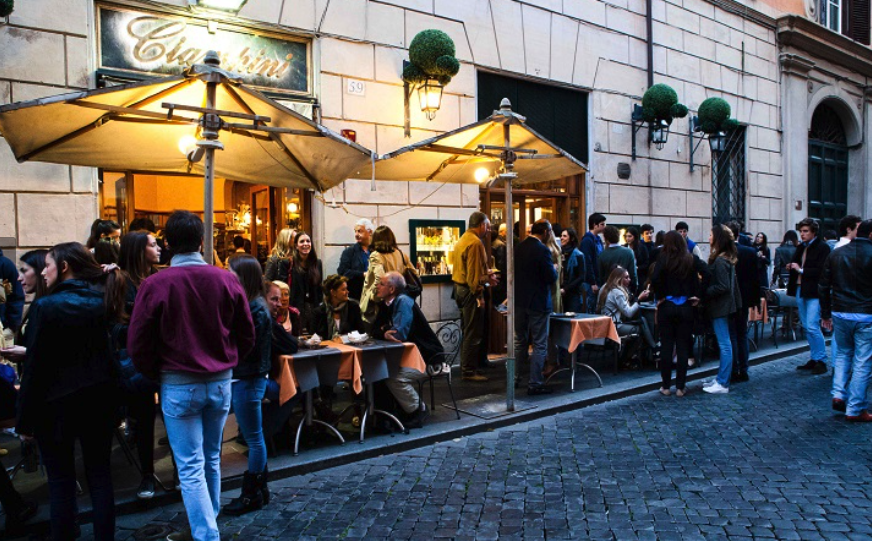
Where to start with Italian food? It’s often one of the top reasons why tourists come to Italy, and for good reason. Every region serves amazing, fresh, handmade delicacies.
A traditional Italian meal will go like this: antipasto (starter), primo (pasta), secondo (meat and vegetables), dolci (dessert), followed by coffee and liquors. Do Italians eat like this every day?
Fortunately for those of us who live here, no! But these are typically the headings that you’ll see on a menu, so it’s best to have an idea of what they mean. There’s a lot to cover in this section, here’s a breakdown:
- How to Find Local Restaurants
Types of Restaurants
Rome meal times.
- Coffee Culture
- Drinking Fountains
How To Find Local Restaurants in Rome
Rome is a very touristy city, but that doesn’t mean that there aren’t good places to eat in the city center. Check out our Rome restaurant master list that we regularly update . From there, you can navigate and see our restaurant recommendations near every major Roman attraction.
In general, avoid restaurants within sight of a tourist attraction, particularly if they have pictures of the food on the menu or people standing outside trying to hustle you in. Even in the most authentic restaurants, don’t expect particularly friendly service.
Some of the best food is often flung at you without so much as a “hello,” but it’s guaranteed to be worth it. Areas a little more off the beaten track are where you’re more likely to have an authentic experience. For example, the area of Testaccio is well-known for being a classic Roman foodie area, packed with local restaurants.
A really great way to experience a wide variety of Roman cuisine in good restaurants is to join a food tour. They’re a trendy and fun way to get to know the local food scene. Check out our top-rated Trastevere food tour in Rome .
In Italy, there are stereotypical classifications for almost anything, including restaurants. When you’re in Rome, you’ll notice restaurants don’t just have a name, like “Tony’s,” but also a classification, such as “Trattoria.” Each one means something specific, and it lets you know what kind of food and experience to expect. Unfortunately, very few visitors to Italy know the difference between an osteria and a trattoria . We’ll solve that for you right here.
Imagine waking up at 6:30 am, rolling over to your significant other, and saying, “Want to head to the bar?” This is what happens almost every morning to millions of Italians.
No, they are not alcoholics. You can get alcohol at an Italian Bar, but you normally don’t. It’s where you get breakfast. You’ll see the “Bar” sign all over Italy, and when you walk in, you’ll find espresso drinks, cornetto, and panini. You can also get freshly squeezed orange juice or vegetable juice. I highly recommend it!
Unlike the bar, you definitely shouldn’t wake up at 7 a.m. asking you’re significant other to go to the enoteca . This is where you go for an alcoholic drink like a glass of wine or a beer.
A good enoteca will serve tons of wine by the glass in many different price ranges. They’ll often also serve cured meat plates for a snack or even warm meals at times. I definitely recommend stopping by one of these on your travels in Italy and Rome.
Tavola Calda
One of my favorite types of places to eat lunch is a tavola calda . They are normally unassuming and serve many different types of dishes, from cooked vegetables to lasagna and pasta dishes. The dishes normally change from day to day based on what is in season and other factors.
For example, gnocchi in Rome is only served on Thursdays. If you see it on the menu seven days a week, you may be in a tourist trap. Authentic Roman restaurants only serve this dish on giovedí. You have been warned.
These are pretty cool little sandwich shops. Dotted all over Rome, they range in quality. Don’t refer to your sandwich as a “panini” unless you get more than one. The “i” makes it plural. Italian’s order a panino.
Check out 200 Gradi by the Vatican. It’s an awesome place. Campo dei Fiori also has an awesome drive-up stand open for lunch that serves porchetta.
Osterie are pretty cool if you can find one. They are basically super cheap and simple places to eat. A true osteria would have communal-style tables and serve very cheap meals. Back in the day, when Italy was extremely impoverished, they’d even allow you to bring your own food and just drink there. Imagine that today?
You can find restaurants with the title “Osteria” in Italy, but you shouldn’t bring your own food or normally expect to eat with strangers. There is a place in Florence, Da Mario , which says it is a trattoria, but it feels more like what a traditional osteria would have been like.
Expect a warm and cheap meal if you happen to go inside an osteria in Rome, and even more so in the Italian countryside. The menu will either be non-existent or small. In the countryside or in small towns, they can be really cool. The waiter may rock up to your table and say, “Today, we are serving pasta with clams. Would you like fettucini or spaghetti with that?” Enjoy!
The trattoria of Rome sits somewhere between osteria and ristorante . Almost all Italian restaurants are family-run, bu t trattories are quintessentially family-run. They are normally inexpensive but have a larger menu than an osteria.
Expect traditional regional cuisine at a trattoria. If you go to two different ones, you may find the exact same things on the menu. This is because they offer their family’s version of that regional dish.
This is basically the Italian equivalent of a more formal restaurant. They’ll have a menu with all the Italian courses, and you’ll be expected to eat each course. You should definitely find a top-rated ristorante in Rome and budget 3 hours for your meal. Really indulge in the food, wine, and desserts.
Pasticceria
This is an Italian bakery serving all types of delightful local treats. They are probably the best places to go for breakfast as they’ll make their cornettos fresh and supply them to all the bars.
You should be able to get a coffee here, too, but that isn’t a given. If you’re staying in an Airbnb or apartment rental, find a pasticceria close by and pick up a bunch of cornetti for your group. You’ll be everyone’s favorite person!
Rosticceria
You won’t find this is in Rome, but it’s worth mentioning. A rosticceria is a place you can go to find pre-cooked meals like roasted meats and high-quality products. If you do find one and you’re renting an apartment, consider doing take-out one night from a rosticceria.
Taverna or Rifugio
You’ll find restaurants in Rome with taverna in their names, but this is more a colorful play on words. Taverne are secluded restaurants in the Italian mountains where you could get a hearty meal, something to drink, and possibly a warm bed to sleep in.
Today, you can still find a few dotted in the landscape, but you’re more likely to find an agriturismo, which is more of a B&B. A taverna in Rome is most likely going to decorate its interior in a rustic countryside style and have hearty meals on its menu. It’s kind of like going to a seafood restaurant that’s decorated in a nautical theme but nowhere near an ocean.
One of the biggest cultural differences is that Romans tend to eat much later than basically everyone except the Spanish. In fact, many of the best restaurants won’t open until at least 7:30 p.m.
Lunch: 12:30 pm – 2:30 pm
Dinner: 7:30 pm – 11 pm
To avoid eating in an empty restaurant and to really make the most of your evenings in Rome, try and fit in with them and eat a bit later. Around 8 pm is a good time to sit down.
Coffee Culture in Rome
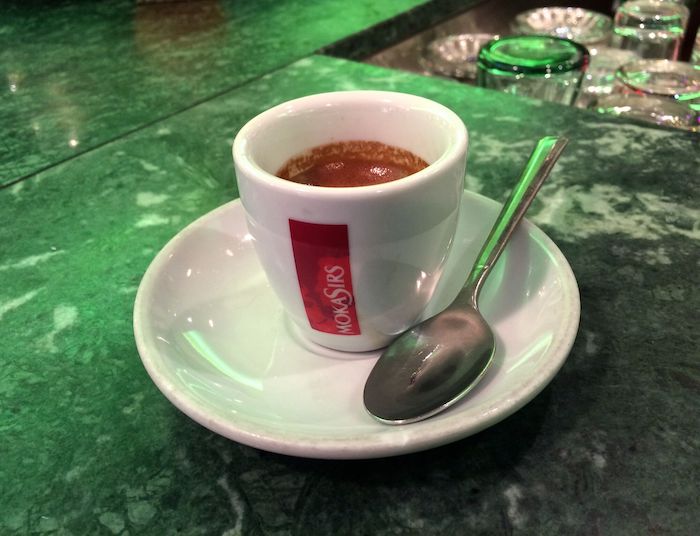
Italians take their coffee culture very seriously, and there are almost as many rules about coffee as there are for food. Here’s what you need to know to get your coffee fix in Rome:
Espresso “un Café”: A very small shot of coffee. Unless you’ve been to Italy, it’s never been this small.
Café Doppio: Double shot of espresso.
Café Macchiato: Basically a mini cappuccino. Imagine an espresso and foamed milk all in a tiny espresso cup. Normally, men order these in the morning.
Cappuccino: This is espresso and foamed milk in a small cup. It’s larger than a macchiato, but nowhere near that tall cappuccino you are used to. You won’t find a larger size.
Café Americano: Espresso with hot water. The name is from WWII, when American troops would ask Italians to put hot water in the espresso.
Latte: A cup of milk—don’t order this if you want caffeine.
Café Latte: Warm, non-foamy milk with espresso.
The Coffee Rules (Yes, there are rules)
- No cappuccino or milk-based espresso after 11 a.m. You can do it, obviously, but it’s not really the culture.
- No cappuccino or milk-based espresso with meals. Don’t do this.
- It is cheap when you stand up at the bar (€1 – €2), expensive when you sit down. Same for everyone, not just tourists.
Rome Water Fountains
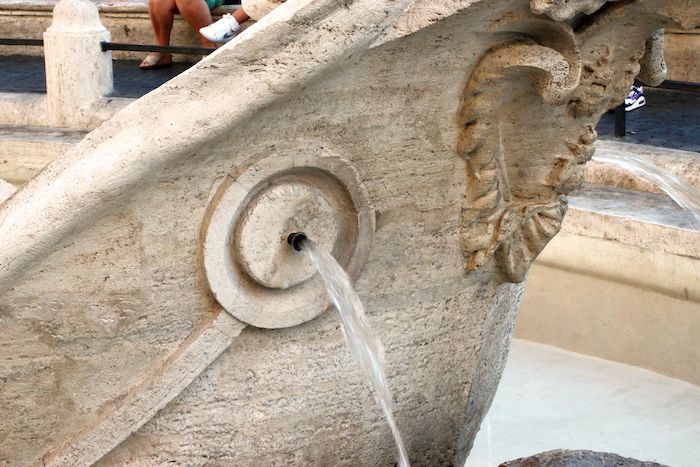
One of the best things to know about Rome is that there’s no need to buy plastic bottles of water when you get thirsty—there are tons of fountains dotted around the city, and Romans are very proud of them.
Bring a refillable water bottle, and fill it up whenever you see one. There’s also an app to help you find them called I Nasoni di Roma. If you’re going in the heat of summer, you’ll find this tip invaluable!
People are always surprised that you can drink from these fountains, which is crazy if you think about it. Their original purpose was to provide running water to each neighborhood since most houses didn’t have running water. Today, we forget that fact and are astonished by this basic concept due to our many creature comforts.
Credit Cards, Tipping, and Communicating in Rome
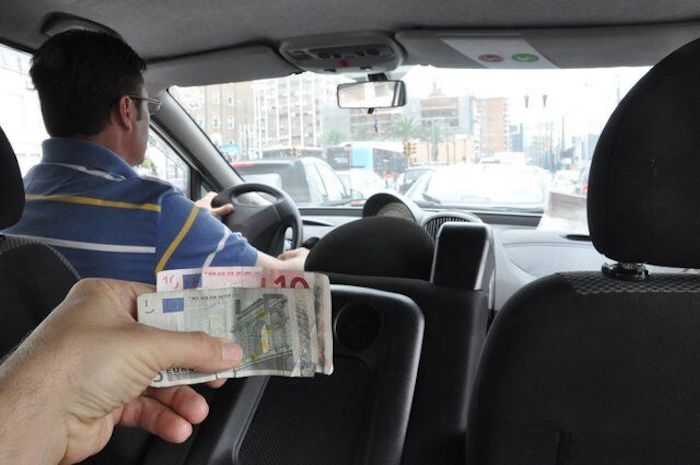
Cash or Credit?
The currency in Italy is the euro. An important thing to remember about Italy is that cash is still king. It’s necessary to carry a reasonable amount of cash around with you at all times to avoid getting stuck.
In general, most restaurants will allow you to pay on a card, as will large shops and tourist attractions. But for drinks, coffee, transport tickets, and small items, cards often aren’t accepted. There may even be a €10 minimum on card payments.
Rule of Thumb: If it’s less than €10, pay cash. It’s more than €10, and you can probably pay credit as long as there isn’t a “Solo Cash” sign on the door.
The Good News: The Italian word for credit card is carta di credito . Any Italian shop owner will understand when you ask, “Credit Card?” They’ll also know to respond, “Cash” if they don’t accept credit cards. So, there’s no need to stress.
Tipping isn’t really expected in Italy. I’ve tried to convince visitors that you just need to leave some extra change, a euro per person, regardless of check size, but it normally falls on deaf ears. To simplify things, I have created different levels of tipping to help people understand:
Don Corleone: Leave 20%, and when you go back, the restaurant staff will celebrate your return as if you were the Godfather. You may get some sneers from other restaurant goers who can’t get your waiter’s attention.
Super Nice : Leave 10%. It’s less than you are used to but far more than anyone in Italy would expect.
Roman : Leave a euro or two extra per person. The wait staff will be very happy.
Nothing at All : Leave nothing and nobody will say anything. Your food will not be poisoned upon returning.
Communicating in English or Italian
One of my favorite things to watch is travelers trying to string together Italian words into sentences from a guidebook. I have been that traveler in many countries. The worst part, though, is when you actually make sense, and the person responds, much to your bewilderment.
Let’s not romanticize the key phrases part of a guidebook here and keep it simple. The phrases below will make you look like a pro because you’ll get simple responses such as si (yes) or a finger pointing to the bathrooms. Remember that c’s have a hard “ch” sound, unlike Spanish.
How much does this cost? Quanto costa?
Check, please. Il conto per favore.
Do you take credit cards? Posso pagare con la carte?
Where is the bathroom? Dov’è il bagno? Or simply, “bagno?”
Water? Acqua?
Table for two, please. Tavolo per due, per favore.
Can you order for me? Fai te?
The last recommendation is by far my favorite. If your waiter is Roman, they will accept the challenge and bring some tasty food. A key phrase is certo (pronounced cherto), which means “of course”. Romans use this all the time, so you may hear it instead of si .
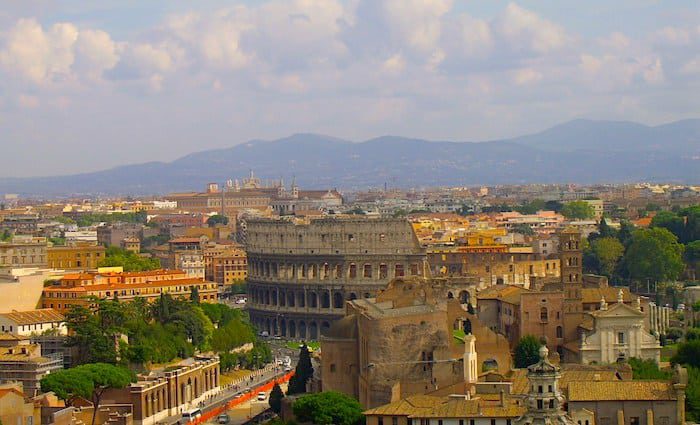
When To Travel
Part of the reason why people love Rome is the weather. It’s pretty much always nice, and bad weather is when it is too hot. That’s a good problem to have.
Temperature
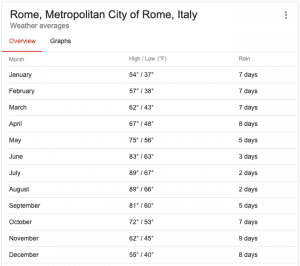
The average monthly temperature in Rome ranges from a low of 37 degrees Fahrenheit (F) to a high of 89 F. It snows once every 10 to 50 years, and people don’t know what to do when that happens—it’s the greatest.
To decide when you want to travel to Rome, you can use this equation to get a rough idea.
How much am I willing to spend / Am I ok with cooler weather = Daily budget
Cheapest Months:
- December (1st – 20th)
- Jan (7th – 31st)
- March (1st – 20th)
Mid-Range Months:
- March (21st – 31st)
- April (excluding 5 days on either side of Easter)
- October (although it can be higher in price early in the month)
Full-Price Months:
- Christmas to New Year
- Easter (5 days on either side)
What To Pack
Check out the infographic below on what to pack. While it’s very useful, the ideal amount to pack is one change of clothes and a mostly empty suitcase. Shopping in Italy is great, so the more space you can leave in your suitcase, the better.
You don’t need to pack an umbrella. As soon as it rains, hundreds of people will appear out of nowhere selling umbrellas. It’s magical. Also, you can’t wear heels in Rome. Let me clarify, you can wear flats and pack heels in your purse for when you are inside bars and restaurants. The cobblestones make wearing heels nearly impossible.
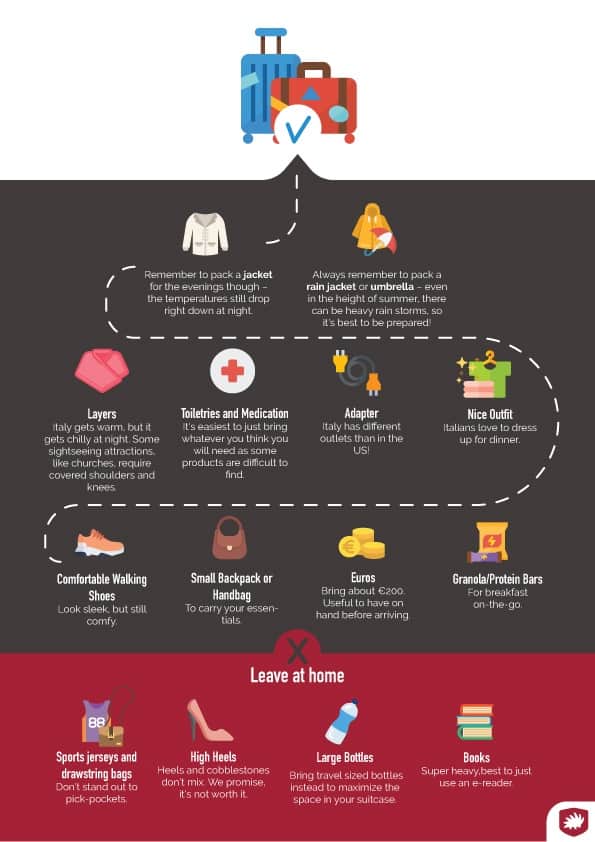
Rome has a rich cultural history and many iconic landmarks to explore. Plan where to stay in the magnificent Eternal City in the best neighborhoods.

Reader Interactions
Comments (12).
September 3, 2019
What a lovely description of Italy and Italians you have given to us! I love to read about the transport, food and most importantly the people. Awesome work done! Keep them coming!
September 4, 2019
Ciao Tanisha! What a lovely comment. We are so happy to provide you with helpful tips for your vacation!
October 24, 2019
A very informative article. Thank you so much for sharing these things.
October 28, 2019
Ciao! Thanks so much for reading our blog! It’s our mission to provide you with the most useful information possible for your trip.
November 19, 2019
Nice quality post. Thumbs Up from my side. Special thanks to theromanguy for sharing this valuable information. Once again appreciated!
January 6, 2020
Nice tips. I’d add the 48 euro fixed rate from the airport to the centre as the best option if there are at least 2 people. By the time you take the train then Metro or taxi from Termini it just about equals out.
January 21, 2020
Thanks for the tip, Gary!
May 15, 2020
Rome really such a beautiful city, wish more people will be able to experience it. Thanks for the insightful article.
June 9, 2020
It is nice you included few basic lines of Italian language everyone should know when visiting Italy or and other country. People are so friendlier to you if you can say “Hi” to them in their language.
July 21, 2020
Hey, thanks for sharing this, I enjoyed reading it looking forward to my next trip to Italy.
April 23, 2021
Admiring the time and energy you put into your blog and detailed information you provide.
September 27, 2022
thank you – very helpful and have taken notes for our trip 🙂
Leave a Comment Cancel reply
Your email address will not be published. Required fields are marked *
- In The Press
POLICY & TERMS
- Cancellation Policy
- Terms & Conditions
- Privacy Policy

- Liechtenstein
- Netherlands
- Switzerland
- Solo Location Guides
- Solo Travel Advice
- Solo Inspiration
- Luxury travel
DESTINATIONS , EUROPE , FRANCE
One week in provence by rail made easy.
Do you have one week in Provence but no car? Not a problem! It is easy to explore Provence by rail.
To help you plan a perfect South of France itinerary by train, here are some tips on how to do it, based on my 7-day trip as a solo traveller.

Some articles on this website contain affiliate links. This means that I may earn a small commission if you make a purchase through these links. As an Amazon Associate, I earn from qualifying purchases . Read the full disclosure here .
IN THIS ARTICLE
Provence has something for every traveller
The region’s architectural wonders , such as the Palais des Papes in Avignon, are a lasting legacy of its rich history. These are equalled by its natural wonders , like the famous Calanques near Marseilles or its acres of lavender fields. Provence has a wonderful climate, charming towns , and an idyllic coastline . It is also a foodie’s playground. It’s no surprise that Provence has been the setting for many movies set in France.

How I spent a week in Provence
In an ideal world, you would tour Provence by car, especially if you want to explore its remote villages and dramatic landscapes. Although you can visit the lavender and sunflower fields on a day trip, having a car at your disposal is more convenient.
But if, like me, you don’t want to drive, it’s easy to see the best of Provence without a car. Just accept that Provence is vast and you can’t do it all in one week. Pick an area and stick with it using one or two places as hubs to visit the other places on your itinerary.
I used Avignon and Cassis as bases , taking day trips by train to other destinations in Provence. Although this worked well, given the choice again, I’d be tempted to ditch Cassis for Marseille as the latter is a major transportation hub. I travelled from London by Eurostar.

The best places to stay in Provence without a car
It’s important to stay in a town that has good rail connections. Over a week, I recommend splitting your time between two bases: one to explore the west of the region and a second to visit eastern Provence. Avignon is an ideal base for exploring western Provence without a car. Marseilles, Cassis or Nice are good bases to visit eastern Provence.
My 7-day South of France itinerary by rail

Day 1: Avignon
Avignon to London by Eurostar

Sadly, the direct Eurostar train between London and Avignon will not be operating for the foreseeable future. Instead, you will need to change trains in Paris or Lille.
Catch a morning train from London St. Pancras to Paris Gare Du Nord and change to the Marseille service from Gare de Lyon to Avignon.
I’ve changed trains in Paris many times and it’s easier than you might think. From Gare du Nord to Gare de Lyon it’s a quick and direct journey on RER line D.
Changing trains at Lille is simpler, just requiring a platform change.
There are two stations in Avignon: Avignon TGV (where the high-speed trains stop) and Gare d’Avignon-Centre. A shuttle train – La Virgule – will whisk you between the two stations in four minutes.
Why not start and finish your week in Provence in comfort by upgrading to Eurostar Standard Premier ? It can be an affordable way to inject a dose of luxury into your itinerary.
Introducing Avignon
Founded by the Romans, the centrepiece of Avignon is the UNESCO world heritage site of Palais des Papes . Built in the 14 th Century for popes fleeing Rome, this is one of the most stunning European palaces and the largest Gothic palace in the world. It’s a great place to start your tour of the city.

After your visit here, take a leisurely stroll through the old town before heading out to Pont Saint-Bénézet , Avignon’s famous Pont D’Avignon .
Much of this bridge was washed away in the 17 th Century, stranding its remains in the middle of the Rhône River. Today, only four of its original 22 stone arches remain.

GOOD TO KNOW! If you have time, try to catch a concert in the Cathédrale Notre-Dame des Doms . I got a ticket for a performance of Vivaldi’s Four Seasons, which was sublime.
Where to stay in Avignon
Avignon Grand Hotel
I stayed at this lovely 4-star hotel just outside the city walls, and five minutes walk from the train station. A perfect location, both for day trips around Provence by rail and for exploring Avignon.
>>> CLICK HERE TO CHECK RATES & BOOK A ROOM
Here are some other places to stay in Avignon that are also worth considering:
Villa de Margot
Although further from the train station, this centrally-located guest house is a five-minute walk from the Cathedral and Palais des Papes and has a lovely garden and terrace.
Hôtel Le Bristol
Another 4-star hotel choice within the city walls but close to the train station. Reviews are good and it has a bar and lounge.
Where to eat in Avignon
Le 46, 46 rue de la Balance
A fantastic bistro near the Palais des Papes.
L’epicerie, 10 place St. Pierre
A traditional Provençal restaurant complete with checked tablecloths.
Day 2: Arles
Avignon to Arles by train – typical journey time 17 minutes
Arles, a UNESCO World Heritage Site since 1981, was my favourite town on this trip. Its Roman ruins, pastel-hewn houses and cobblestone streets lend it an instant charm.

Arles’ Roman amphitheatre takes pride of place. Built in the 1 st Century BC for an audience of 20,000 to gawp at gladiators and cheer chariot racers, it now hosts cultural events.
Arles is also where Vincent Van Gogh famously chopped off an ear, and a free self-guided walking tour will take you around sites associated with the artist.
GOOD TO KNOW! Keep an eye out for the traditional celebrations in Arles . Purely by accident, I timed my visit with the Festival of the Herdsman, which was quite a spectacle.
Day 3: Orange & Pont du Gard
Avignon to Orange by train – typical journey time 30 minutes
Get an early start and visit Orange in the morning.
The main attraction in Orange is the Théàtre Antique , its spectacular Roman theatre. This UNESCO World Heritage site has its original stage wall intact. I’ve visited many Ancient Roman sites over the years and this ranks among the best.

Avignon to Pont du Gard by bus – 35 minutes
Take bus number 115 from Avignon’s bus station. In peak season, there are seven buses a day. The last returning bus leaves Pont du Gard around 7 pm.
If you don’t fancy taking your chances with the local bus service, why not visit Pont du Gard from Avignon on an organised tour that also includes Uzès and the Roman city of Nîmes? Check here for availability and prices.
Pont du Gard is another sensational piece of architecture the Romans left behind, a must-see during your week in Provence.
Towering almost 50 m above the Gard River, this is the tallest aqueduct bridge in the Roman world. Featuring 35 arches – there were originally 47 – this was an essential part of an aqueduct that supplied water to the city of Nîmes.

GOOD TO KNOW! The Pont du Gard is exceptionally photogenic, best viewed in the soft late afternoon light when there are also fewer visitors. Just make sure that you check the time of your last bus back to Avignon.
Day 4: Cassis
Avignon to Cassis by train – typical journey time 1h 30m. Change trains at Marseille.
Cassis is the quintessential Provençal portside town. Overlooked by towering cliffs and the Château de Cassis, and blessed with beautiful beaches, it is a relaxing and picturesque base for travelling around Provence by rail.
It is small enough to get to know in a short space of time and boasts some great restaurants. Soak up the sun at the beach, stroll through the old town, walk along its pier and treat yourself to a local lavender ice cream.

Don’t miss visiting the Calanques , limestone cliffs rising out of the sea. I took a boat trip from Cassis to visit the Calanques and was blown away by their scale. Several companies offer regular departures from the port.
Where to stay in Cassis
Mide-range hotel – Sure Hotel Couer de Cassis
I stayed in this charming 3-star hotel, tucked in one of the streets leading up from the port. Its location couldn’t have been better and it has a spa and a small pool.
Alternative mid-range hotel – Mirabeau – Chambre Meublée
This 3-star hotel is for you if you want a room with a sea view. It’s situated right on the seafront by Cassis Harbour and some rooms have balconies overlooking the harbour.
Splurge – Hôtel Les Roches Blanches Cassis
Live like a rock star at the swankiest hotel in town. The 5-star Hotel Les Roches Blanches Cassis is a ten-minute stroll from Cassis Beach.
Its infinity pool is just gorgeous.
None of these places takes your fancy? Click here for other great accommodation deals in Cassis.
Where to eat in Cassis
Le Chaudron, 4 rue Adolphe Thiers
Family-run bistro with great food and attentive service. So good that I went there for dinner for my entire stay in Cassis.
Day 5: Marseille
Cassis to Marseille by train – typical journey time 23 minutes
Marseille is France’s oldest city and third-largest urban region. Initially put off by its reputation as a gritty city, I didn’t use Marseille as a base for visiting Provence. I was delighted to have my preconceptions turned on their head.
Stroll around the Vieux Port , or Old Port, and make your way to Le Panier, the oldest part of Marseille. Then, head to Notre Dame de la Garde for the best views of the port.
Whatever you do, don’t miss the MuCEM , Marseille’s Museum of European and Mediterranean Civilisations.
The poster child of the city’s reign as the European Capital of Culture, this building is extraordinary. Cube-like in shape, its skin of ornamental filigreed concrete throws intricate patterns on its floors and corridors as the sun streams in.
Cross a footbridge to visit the Fort St-Jean for further fantastic harbourside views.

Day 6: Aix-en-Provence
Cassis to Aix-en-Provence by train – typical journey time 1 hour. Change trains at Marseille.
Cards on the table; I was a little underwhelmed by Aix-en-Provence. The problem is I can’t put my finger on why that was.
The city’s multitude of splashing and gurgling fountains tell of Aix’s origins as a Roman spa town, known in Roman times as Aquae Sextiae (The Waters of Sextius). Home to Cézanne and Zola and an inspiration for other artists including Monet and Renoir, it is a Provençal town straight out of casting central.
Picture cobblestoned lanes, sun-drenched squares, local markets and the low hum of chatter emanating from café terraces. Perhaps I felt that it was just a little too perfect?

To learn more about Aix’s favourite son, take a Cézanne self-guided walking tour of the city. Starting at the city’s tourism office, key landmarks associated with the artist’s life are marked with studs stamped with a “C”.
Day 7: Travel from Cassis to London via Marseille
Cassis to London – Approximately 8 hr 30 minutes. Change trains at Marseille. You will need to alight the train for immigration checks at Lille .
My top tips for travelling around Provence by train
- Check train timetables in advance
Don’t just rock up at the train station, expecting to board a train in the next 15 minutes. Even from a major hub like Avignon, trains to neighbouring towns did not run very frequently and I was surprised at the gaps in the services.
- Be aware that some trains may require compulsory reservations
- Train travel in France is not cheap.
If Provence is part of a longer rail itinerary, it may be worth considering a Europe train pass . An Interrail pass is available for European citizens or residents. Opt for a Eurail pass if you are a non-European citizen or resident.
You can find out more in my guide to Interrail passes.
Visiting Provence’s lavender fields & vineyards
As Provence’s lavender fields and vineyards are not served well by public transport, your best bet is to rent a car or join an organised day tour from Avignon. Here are a few highly-rated excursions from my favourite platform, GetYourGuide , which offers free cancellation up to 24 hours before your day trip.
Half-day vineyards tour from Avignon
Learn about wine production and grape varieties in this 5-hour guided tour in the Côtes du Rhône. This highly-rated excursion includes two wine tastings.
>>> CLICK HERE TO CHECK AVAILABILITY AND PRICE

Châteauneuf du Pape afternoon wine tour
Spend a relaxing afternoon with a scenic drive through the rolling vineyards of Châteauneuf du Pape. Includes wine tastings at two different wineries.
Day tour of the lavender fields
Get your lavender fix on this half-day tour that includes a visit to Sault, one of the most beautiful Provencal villages of the Luberon.
Half-day tour of Luberon villages
This half-day tour takes you to the villages of Roussillon, Gordes and Fontaine de Vaucluse, which rank among the most beautiful in France.
When to visit Provence
This is a bit of a trade-off. Visit Provence in the summer to view the lavender and sunflower fields in full bloom. However, this region is not exactly a well-kept secret and the South of France will be very busy, especially in August. Hotels will be more expensive and restaurants will be rammed. I travelled to Provence in May. Whilst it was too early to visit the lavender and sunflower fields, I had good weather and it wasn’t too busy or expensive.
How many days do you need in Provence?
You could easily spend two weeks or more exploring the vineyards, lavender fields and picturesque towns of Provence.
As a minimum, I recommend five days in Provence to soak up its landscapes and history. But if you are travelling by train or don’t want your itinerary to be too rushed, spend one week in Provence.
And that’s a wrap! Whichever way you decide to travel and wherever you base yourself, enjoy your week in Provence.
It’s an enormously seductive region, steeped in history with some of the best food and wine I’ve had anywhere. Moreover, it’s one of the best destinations in France for solo travellers .
DISCOVER MORE PLACES TO VISIT IN FRANCE!
- A Weekend in Normandy: Day Trips from Honfleur
- One Day in Lille, Northern France
- One Day in Nice, France
- Colmar in One Day: A Perfect Itinerary
- A Free Strasbourg Walking Tour: The Best Things to See in One Day

About Bridget
Bridget Coleman has been a passionate traveller for more than 30 years. She has visited 70+ countries, most as a solo traveller.
Articles on this site reflect her first-hand experiences.
To get in touch, email her at [email protected] or follow her on social media.
- Search Please fill out this field.
- Newsletters
- Destinations
Your Trip to Rome: The Complete Guide
:max_bytes(150000):strip_icc():format(webp)/ElizabethHeath-Headshot-horiz-e7525e97616245958bf3d94e8db7f119.png)
- The Best Time to Visit Rome
- Weather & Climate
- Rome Airport Guide
- Tipping in Rome
- Rome's Top Neighborhoods
- Public Transportation in Rome
- Itinerary: 3 Days in Rome
- Day Trips From Rome
- Rome's Top Attractions
- Free Things to Do
- Things to Do With Kids
- Beaches Near Rome
- Top Museums in Rome
- Where to Shop in Rome
- Events in Rome
- The Best Food to Try
- The Top Restaurants in Rome
- Nightlife in Rome
TripSavvy / Christopher Larson
Rome, Italy, commonly referred to as the Eternal City, is a top travel destination that draws millions of visitors each year. An exuberant and modern world capital, Rome offers travelers fascinating reminders of its imperial past at every turn. It's also an international hub for contemporary fashion, design, art, and culture.
Encounter glorious monuments and ancient ruins dating as far back as at least the 3rd century B.C. Marvel at the stunning Romanesque- and Gothic-style architecture, medieval churches, picturesque squares, Baroque fountains, and world-class museums . Besides having an almost unlimited number of sights and attractions to see, Rome is famous for its traditional Roman food and wine and its vibrant nightlife , as well as pretty urban parks and peaceful nature reserves.
Planning Your Trip
Things to know before you go:
- Best Time to Visit : Since Rome has a Mediterranean climate, there's really no bad time to visit . If you want to avoid the crowds and the heat of summer, we recommend coming to Rome in the late spring or early autumn when the weather is mild and lines tend to be shorter. For average daily temperatures and rainfall, month by month, see our article.
- Language: Italian is the official language , but you'll find that many people speak some English, especially those who work in the tourist industry. That said, it's always a good idea to bring along a pocket-sized phrasebook or download one of the many free language translation apps on your smartphone, just in case.
- Currency: As a member of the European Union , Italy uses the Euro (€). Prices include tax and credit cards are widely accepted in restaurants, hotels, and shops. But when purchasing small items like a cup of coffee, a slice of pizza, or a glass of wine, plan on paying cash.
- Getting Around: Although Rome is a big metropolis, the historic center, or centro storico , is fairly compact, making it a highly walkable city. Public transport in Rome is run by ATAC , which operates the buses and trams linking riders to most areas in the city. The Metro subway system is affordable and quick.
- Travel Tip: You might find shorter lines if you visit the most popular attractions in the early afternoon when most people are at lunch.
Getting Around
Rome has an extensive public transportation system that consists of the Metro (subway), buses, trams, and three suburban railway lines (FS). Convenient and relatively inexpensive, the network connects to Rome's most popular tourist attractions but can be sometimes unreliable and overcrowded, especially during the summer months.
Things To Do
With so much to do and see in Rome, we recommend you start by hitting the major tourist attractions first—especially if this is your first visit. Regardless, do make sure to leave time in your schedule for people watching on an intimate piazza or strolling down Rome's many charming streets and cobbled alleyways.
Here are just some of Rome's top attractions:
- The Colosseum or Colosseo is the largest monument from Imperial Rome still in existence today. The enormous amphitheater once housed fierce gladiator contests and wild animal fights. It's best approached from Via dei Fori Imperiali to get the full effect of its grandeur. Entrance lines can be long, so check out our tips for buying Colosseum tickets and avoid waiting .
- The Pantheon , one of the world's best-preserved ancient buildings, this masterpiece of Roman architecture began as a pagan temple before becoming a church in the 7th century AD. Located on Piazza della Rotonda, the Pantheon has a cylinder-shaped, hemispherical dome featuring a round hole in the top, the oculus, that allows natural light to stream in, as well as raindrops. Admission is free.
- Vatican City, the home of Saint Peter's Basilica and the Vatican Museums, is the world's smallest city-state. Geographically located within Rome, but not actually part of it, St. Peter's is the largest church in the world and houses important works by Michelangelo and Bernini. The Vatican Museums ( Musei Vaticani ) is a massive complex that contains an impressive art collection spanning 3,000 years—from Classical to modern eras. It's here that you can see the Sistine Chapel featuring Michelangelo's renowned frescoed ceiling.
For more information and details about Rome's sights and attractions see our 3 Days in Rome: What to See and Do or The 25 Top Things to Do in Rome.
What to Eat and Drink
Traditional Roman cuisine is based on inexpensive cuts of meat like offal and simple pasta recipes such as cacio e pepe (pecorino cheese and black pepper) and spaghetti carbonara (egg, cheese, and pork cheek). Other Roman favorites include deep fried artichokes ( carciofi alla giudia ), supplì (stuffed balls of rice with tomato sauce), and thin, crisp-crusted pizza.
Frascati is a white wine blend made in an area just south of the city. Artisanal and craft beer has become quite popular recently with pubs cropping up all over the city. In speakeasies and chic hipster bars, cocktails are flowing after hours.
Where to Stay
With so many diverse and interesting neighborhoods in Rome, it's hard to choose where to stay. For easy access to the airport and public transportation, staying in a cozy B&B or friendly hostel near Termini Station makes a lot of sense. If you want to be where the action is, there are a myriad of lodging options in Trastevere , Monti, and the centralissimo (very central) area, though these quarters can be rather noisy at night. If romance is what you're after, consider staying at a historic luxury hotel along the famed Via Veneto or near the Spanish Steps, but expect to pay a premium for such stellar locations. If you're on a budget, self-catering Airbnbs and inexpensive hotels are available all over the city, offering a great solution.
Getting There
There are two airports serving the Rome metropolitan area: Fiumicino (also known as Leonardo da Vinci) is the main international airport and Ciampino is a smaller, regional one. The best way to get into the city from the Fiumicino is by train to the main railway station closest to the historic center, Stazione Termini . You can also take airport buses to either Termini or Tiburtina station. We recommend you avoid driving in Rome if at all possible.
The Port of Civitavecchia is where cruise ships dock in Rome. See Civitavecchia to Rome Transportation for information about getting to the city or airport from here.
Culture and Customs
If you want to "do as the Romans do," then follow the bit of advice below.
- You must have your ticket before boarding any public transportation—buy them at station kiosks, newsstands ( edicole ), and tabacchi (tobacco shops). At boarding, be sure to stamp your ticket to validate them or you could get hit with a steep fine.
- You can't hail a cab on the streets of Rome, but can pick up one at the many official taxi stands scattered throughout the city.
- In restaurants, remember that tipping isn't obligatory, but is much appreciated. The rule of thumb is to leave €1 for each diner in your group or round up the check a few euros. If you get exceptional service, feel free to leave up to, but no more than 10% of the total bill.
- When perusing Rome's many boutiques and fashionable shops know that handling items is frowned upon, therefore it's best to ask the shopkeeper for assistance.
- Rome is a relatively safe big city, yet it does have its share of petty crime. Be aware of pickpockets, especially at train stations, on the Metro, and in crowded tourist areas.
For more information regarding the art of tipping in Italy, check out our article, When & How Much to Tip in Italy: The Complete Guide .

Money Saving Tips
For budget-conscious travelers, here are a few ways to save a little coin without skimping on the fun.
- Rock the Aperitivo (pre-dinner drink): When you order a glass of wine or cocktail, it usually comes with a plate of yummy food (cold cuts, squares of pizza, etc.) at no extra charge.
- Forgo summertime and opt to visit during the winter, early spring or late fall. Temperatures are mild and travel packages and discounts are available.
- If you're going to be in Rome for three or more days, the OMNIA or RomaPass pass is a great value. Along with offering free admission to several sights, you don't have to wait in line thanks to the "fast-track" entrance feature included in the price.
Find out more about the cheapest ways to have fun by exploring our guide on visiting Rome on a budget.
Central Intelligence Agency. "The World Fact Book."
European Union. "The 27 member countries of the EU."
Encyclopedia Britannica. "Colosseum."
Related Articles
More related articles.

- Australasia
- Central America
- North America
- South America
- Buenos Aires
- Mexico City
- New York City
- Rio de Janeiro
- Overwater bungalows
- Cruise tips
- Sightseeing Passes
- Attractions
- Theme parks
- When to visit where
- Backpacker Indexes
Sign up for our monthly Priceoftravel newsletter
France and Italy: Best 2 to 3 week itinerary for first-time visitors
France and Italy make for a perfect first visit to Europe, but there are so many potential places to visit that planning well is extremely important. Of the two, Italy is a bit more straightforward because it has a “Big 3” of tourist cities consisting of Rome, Florence, and Venice. France, on the other hand, has Paris, but beyond the capital it can be hard to know where you should go.
These two countries contain several of what I consider to be the best cities in Europe to visit for anyone , so it’s just a matter of narrowing down where to go and how much time to spend in each place. In the article below you’ll see the best option to string together a tour of these countries in two or three weeks. There will be options and decisions you’ll have to make based on your own tastes, but no matter how you do it this should be an unforgettable trip. We’ve also added even more options for those with more specific tastes. If you are a foodie and want to try the best food scene in Italy, you’ll find it in Bologna and there is more information below on that.
This article was most recently updated in June, 2024.
How many cities to visit?
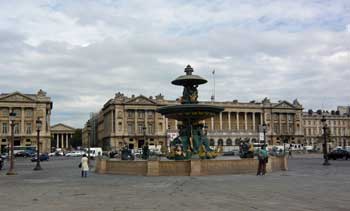
There are many reasons why fast travel might be your best option , but only up to a point. With only a few exceptions, 3 nights per city is a good minimum even for those wishing to see as much as possible, or 2 nights in the smaller cities.
If you are going to France and Italy for sure then start with Paris and Rome as the foundation and add cities in between to the degree you’ll have time. France is a deceptively large country so travel will eat up some time unless you are flying or taking the bullet trains.
>>> Going just to Italy? : Here are the best first-time Italy itineraries for 3 days to two weeks
Flying in and out
Unless you are starting from elsewhere in Europe, you’ll want to carefully choose which airport to fly into. It used to be that Paris was one of the cheapest, and it’s still competitive, but it doesn’t rank high on the list of European cities that are cheapest to fly into .
Two one-way tickets is ideal
It used to be that round-trip tickets were always much cheaper than two one-way tickets, but often that is no longer true. Sometimes the one-way flights are exactly half the round-trip fare, sometimes a bit more than half, and other times they are double. It’s hard to predict so it’s worth comparing them yourself.
The first thing to try is this:
- (your city) to Paris one-way
- Rome to (your city) one-way
Compare that to this:
- (your city) to Paris round-trip
- (your city) to Rome round-trip
If the two one-way flights are within US$150 or so of either round-trip, then they are your best option. If the round-trips are much cheaper then your best option is to buy one of those as well as a one-way flight between the cities (for around US$100) for just before you fly home. It would cost more on the train and also take 14 hours, so flying that last part is the way to go unless you are planning on using the last leg of a Eurail Pass on an overnight run.
Getting around once in Europe
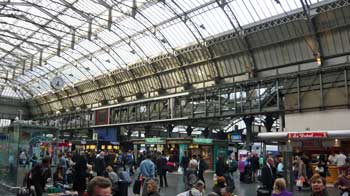
Even on trains, you still have three main options:
- Buying a France-Italy regional Eurail Pass
- Buying individual train tickets in advance
- Buying individual train tickets one at a time when you get there
If you are under 26 you can qualify for the 2nd Class Eurail Pass, which will be ideal for many people. If you are over 25 you have to buy a 1st Class Eurail Pass, and those are probably only best for those with a bit more money to spend.
Best cities in France and Italy for first-time visitors
Paris (minimum 3 nights but even that is rushing it).
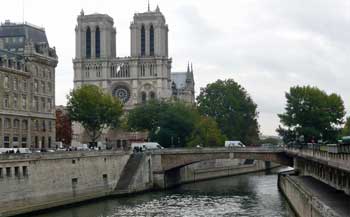
It’s true that you can’t just see all of France by just visiting Paris on your first trip, but it’s still not a bad idea because this city is the center of almost everything and even the areas surrounding it are filled with great sights, amazing histories, and plenty of things to do. It’s almost impossible to get a bad meal in the city and most of the food is reasonably priced considering the quality. Be prepared for a small hotel room, even if you pay a lot, so it’s more about paying for the location rather than for a luxurious and large place to sleep.
The sights in Paris are almost all worthwhile, but don’t think you have to spend an entire day in the Louvre in order to enjoy it. In fact, I highly recommend taking the 3-hour double-decker sightseeing tour (run by several companies) on your first day in order to see at least the exteriors of all of the famous landmarks. If you want to go inside at least a few of the big attractions you might consider getting a Paris Pass , which also covers the bus tour and a cruise on the Seine.
Spend at least three nights in Paris itself and if you have extra days you might do a day trip (tour buses are a great choice) of the nearby Loire Valley. It’s filled with famous castles and palaces where the rich used to live outside of the city, and many are available for tours.
Paris to Nice by train: About 6 hours
>>> Check Paris hotel deals
Provence region (optional 2 or 3 nights)
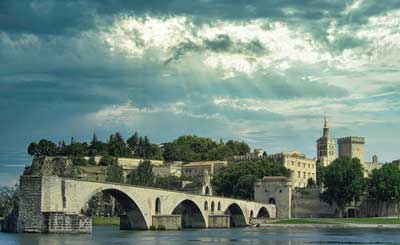
The main city is Arles and that is probably the best base, although Avignon (where the Popes lived) is also very tourist friendly and could be a good choice. In fact, Avignon is the beginning of the famous Côtes du Rhone wine road, which connects a series of hill towns with amazing scenery and of course wine tasting. Something like this might be better for a second or third trip to France unless you’ve got weeks to spend here. Provence is also known for its cuisine, as it stands out even within a country where the food is amazing virtually everywhere you go.
Paris to Avignon by train: About 3.5 hours Avignon to Nice by train: About 3 hours
Nice, France (minimum 2 nights)
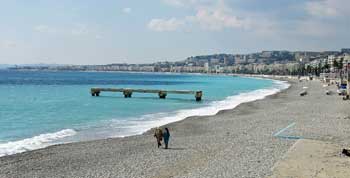
Nice has a famous beach (made of pebbles rather than sand), but it’s also an important cultural capital with great museums and a thriving food scene. You could easily spend 2 or 3 quick days in Nice alone, but you might also consider spending a few hours in Cannes and/or Monaco, which are both only about 30 minutes away by train in either direction. The cheaper hotels in Nice are near the train station anyway, so that’s something to consider if you want to visit all 3 places in one short trip.
Nice to Milan by train: About 5 hours Nice to Venice by train: About 7.5 hours
>>> Check Nice hotel deals
Milan (1 night or just skip it)
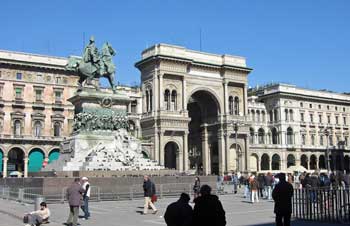
The down side, however, is that Milan is mostly a business/financial city that isn’t as charming as the rest on this list. It’s one of Europe’s fashion capitals as well, but the casual visitor wouldn’t notice. Worst of all, accommodation in Milan can be insanely expensive if there is a trade fair or event in town. If you are coming through in between fairs and events, hotels can actually be unusually cheap, so it’s worth checking rates if you are considering stopping. Generally speaking, I recommend skipping Milan at least on your first trip.
>>> Check Milan hotel deals
Milan to Venice by train: About 2.5 hours
Venice (1 night minimum, 2 nights maximum)
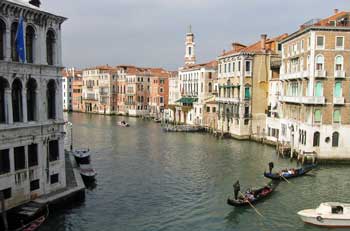
The trick is to stay at least one night, if not two, on the main island itself . Perhaps surprisingly, Venice shuts down early, with most restaurants and bars closed by around 10pm. But in those evening hours as well as the morning hours on the following day, the place can feel magical and like a fairy tale destination. Venice is also quite compact so seeing the main highlights in 24 hours isn’t difficult. Depending on your budget, spend one or two nights on the main island and you’ll be quite satisfied by the time you leave. You’ll be sick of the crowds by then anyway.
Venice to Florence by train: About 2 hours
>>> Check Venice hotel deals
Florence (2 nights minimum, plus side trips)
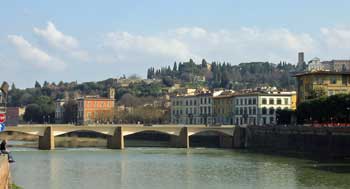
Whether you are coming from Venice or from Rome, this is the point on your trip that you’ll be able to catch your breath a bit. It’s also the cheapest city on this list so lingering here will be more affordable in addition to relaxing. The cuisine here is, of course, world famous, and it can get even better and cheaper if you spend a day or two in one of the many scenic villages in this part of Italy.
From Florence to Rome it’s only around 90 minutes by train, so another easy and pleasant travel day.
Pisa (a few hours on a day trip at most)
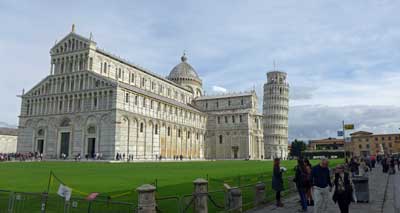
Regardless of your starting point, you can go to the Pisa Centrale train station and walk about 25 minutes to the Leaning Tower area, or take a train to the Pisa San Rossore train station and 7 minutes to the Field of Miracles. There are also bus tours from Florence that take you all the way there, but those come with the slowness of large-group travel.
>>> Check Florence hotel deals
Cinque Terre (1 night, optional)
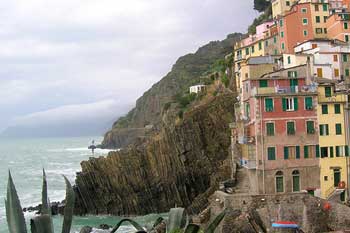
When you see a photo of these villages it’s hard not to be drawn in so if you are in that group you could add a day or two in this area either before or after Florence. Note that the scenic footpaths connecting the towns are partly closed down at times due to instability, so a quick tour by train or even by boat might be a better option.
Florence to Rome by train: About 90 minutes
Rome (minimum 3 nights)
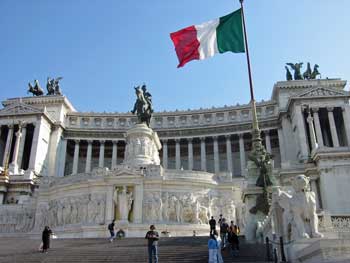
All of that said, Rome is absolutely a must-visit, although you won’t be blamed for hustling through the city quickly and efficiently so you can spend more time in the relative serenity of anywhere else. The Eternal City is also quite expensive, especially by Italian standards, which is another reason to save only a few days there rather than a full week.
>>> Check Rome hotel deals
Naples/Pompeii/Sorrento/Amalfi Coast (optional up to 4 nights)
The “big 3” in Italy are Rome, Florence, and Venice, and if you have time for only 3 cities those are the obvious ones to choose. But if you want to dig deeper into Italy and you have enough time, your next best choice will be to base yourself in Sorrento and use it to explore Naples, the ruins of Pompeii, the Amalfi Coast, and the island of Capri.
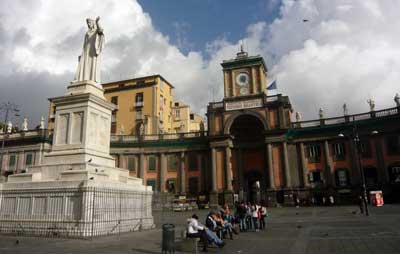
Interestingly enough, as of 2024, Naples is packed with tourists again and the hotels are quite busy as well. In previous versions of this article I would urge (as above) for visitors to just do Naples as a day trip, but with larger crowds and better safety, it’s time to consider staying in Naples itself for a night or two again.
Stay in Sorrento
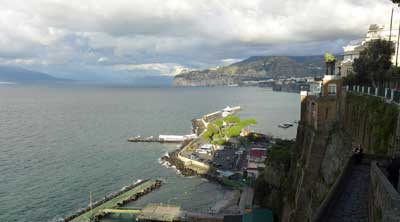
Amalfi Coast and the Island of Capri
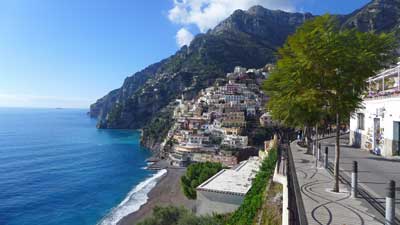
The other main nearby attraction is the famous tourist island of Capri, which is best known for its Blue Grotto attraction. The ferry from Sorrento only takes 20 minutes each way and leaves hourly most of the day. This is another easy and ideal day trip where you can have breakfast and dinner in Sorrento and a wonderful time in Capri in between.
>>> Check Sorrento hotel deals
Bologna is the best addition for foodies

Bologna is yet another beautiful city with a lot to see, but it’s not one of the top tourism cities so the vast majority of restaurants there rely mostly on repeat business from locals. You’ll get pretty good Italian food even in Rome, Venice, and Florence, but if you want to experience what is considered the best restaurant scene in Italy, you’ll find it in Bologna.
Bologna is only 37 minutes by train north of Florence, so you could even go for an afternoon or even just a dinner while staying in Florence, and the city is about 90 minutes south of Venice by train, so if you want to stay it’s best to stay for a day or two in between Venice and Florence.
Filling in the rest of your itinerary
If you have only two weeks total then the above minimums will also pretty much be your maximums, give or take a day. But if you have three weeks you will be adding days to these cities or adding new cities altogether. Honestly, if this is your first trip to these countries, you’ll really get the most bang for your buck by adding extra days in Paris or Florence or both.
Rushing around for two weeks can be exhilarating, but rushing around for three weeks can really start to get exhausting. It’s better to plan to go slower and if you are getting bored you can do a day or overnight trip to something nearby. But you won’t get bored, and if you do you are probably doing it wrong.
Cinque Terre photo by World Walk About on Flickr
OTHER POPULAR POSTS
Leave a reply cancel reply.
Your email address will not be published. Required fields are marked *
France and Italy: Best 2 to 3 week itinerary for first-time visitors " --> All Comments
Thanks for the great starting point!!
Hi Roger, I just stumbled on your site and it is amazing, so thank you! I would like to take my wife, 15 and 18 year old kids to Europe in June 2024 for the first time. Gotta see Paris, but what other countries/cities would you recommend seeing if we were planning a 14 day trip. Having never been across the Atlantic it’s a bit overwhelming to a first timer. I like planning trips so I’m not opposed to doing it myself if possible. Any help or suggestions are greatly appreciated. Thank you in advance for your help.
I’m glad you have found this to be helpful. I think you are on the right track and with 14 days I’d start in Paris and then either stop in Nice or a wine region and then make my way to Italy for the second week. So again to simply, I’d start in Paris for 3 or 4 days and then probably choose something else in France for the next 3 or 4 days. Then get to Venice by train or plane and spend 1 or 2 days there (it’s small and you can see it in a day or so) and then take a train to Florence for 2 or 3 days and then a train to Rome for your final 3 days or so. Then you’ll probably have to fly back to Paris to board your flight home, but I’d check if you can get an open-jaw ticket that is home to Paris and then Rome to home. Usually those cost a lot more though.
The article above should give you lots of information and options on filling in the blanks. Let me know if you have any other questions. -Roger

Provence and the Riviera
Travel guide.
- Things to Do
- Things to See
- Active Pursuits
- In One Week
- In Two Weeks
- For Families
- A Historic Path
- Exploring the Area
- Planning a Trip
- Organized Tours
- Driving Tours
Suggested Itineraries in Provence and the Riviera
When the Frommer’s guidebooks were first launched, founder Arthur Frommer cautioned his readers, “You can get lost in France.” It’s still an apt warning—and promise—today.
For those with unlimited time, one of the world’s great pleasures is getting “lost” in France, wandering at random, making new discoveries off the beaten path. Few of us have this luxury, however, and so here we present 1- and 2-week itineraries to help you make the most of your time.
Provence and the French Riviera in particular are so treasure-filled that you may barely do more than skim the surface in a week. So relax and savor Avignon, Aix-en-Provence, St-Tropez, or Cannes—among other alluring destinations—saving the rest for another day.
Careful planning ahead of time can help you to see as much of these regions as possible without trying to cram in too much. Travel times can be cut considerably thanks to France's excellent road network, which leaves more time to meander along the quiet, secondary roads that take you into the hill towns. The region has an extensive public transportation system, with many of the towns and cities connected by train and/or bus. However, you might find that renting a car will be the best option if you want to explore some of the smaller villages.
Note : This information was accurate when it was published, but can change without notice. Please be sure to confirm all rates and details directly with the companies in question before planning your trip.

- All Regions
- Australia & South Pacific
- Caribbean & Atlantic
- Central & South America
- Middle East & Africa
- North America
- Washington, D.C.
- San Francisco
- New York City
- Los Angeles
- Arts & Culture
- Beach & Water Sports
- Local Experiences
- Food & Drink
- Outdoor & Adventure
- National Parks
- Winter Sports
- Travelers with Disabilities
- Family & Kids
- All Slideshows
- Hotel Deals
- Car Rentals
- Flight Alerts
- Credit Cards & Loyalty Points
- Cruise News
- Entry Requirements & Customs
- Car, Bus, Rail News
- Money & Fees
- Health, Insurance, Security
- Packing & Luggage
- -Arthur Frommer Online
- -Passportable
- Road Trip Guides
- Alaska Made Easy
- Great Vacation Ideas in the U.S.A.
- Best of the Caribbean
- Best of Mexico
- Cruise Inspiration
- Best Places to Go 2024

The Ultimate 10 Days In Italy Itinerary, For First Timers
There’s nowhere more romantic (or popular) than Italy. The word “Italy” conjures visions of crumbling Roman ruins, rolling cypress-studded landscapes, and secret canals.
Italy is rich in history, culture, and food. Italy’s magnificent cities boast some of the world’s best churches, palaces, museums, and historic sites.
Rome, Florence, and Venice shine as hubs of stunning Gothic and Renaissance art. Tuscany, in particular, is hailed as the birthplace of the monumental Italian Renaissance.
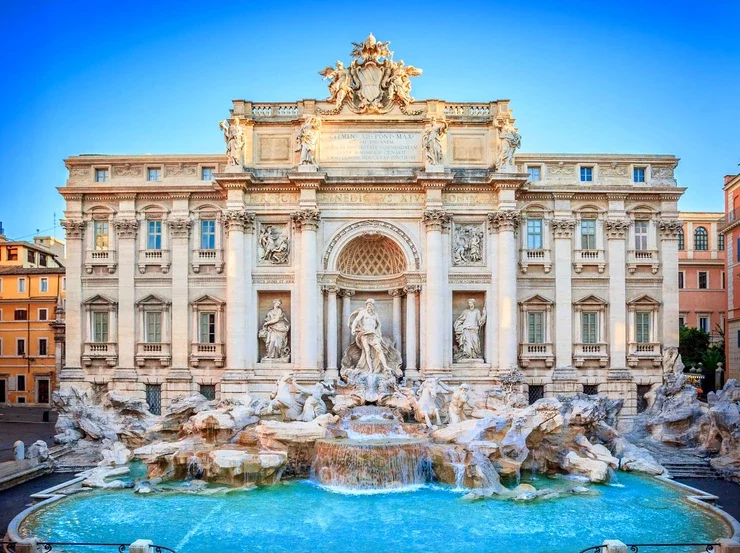
Within these captivating Italian cities, you’ll find expansive collections showcasing masterpieces by luminaries like Michelangelo, Leonardo da Vinci, and Botticelli.
Snapshot Of 10 Days In Italy Itinerary
This 10 days in Italy itinerary is perfect for first timers. It begins in Rome and ends in Venice.
You’ll have 3 bases: Rome (4 nights), Florence (4 nights), and Venice (2 nights).
- Day 1 : Rome
- Day 2 : Rome
- Day 3 : Rome
- Day 4 : Rome, day trip options: Pompeii, Tivoli, or Orvieto
- Day 5 : Florence
- Day 6 : Florence
- Day 7 : Florence & Optional Half Day Trip To Fiesole
- Day 8 : Day Trip To Siena or To Pisa & Lucca
- Day 9 : Venice
- Day 10 : Venice
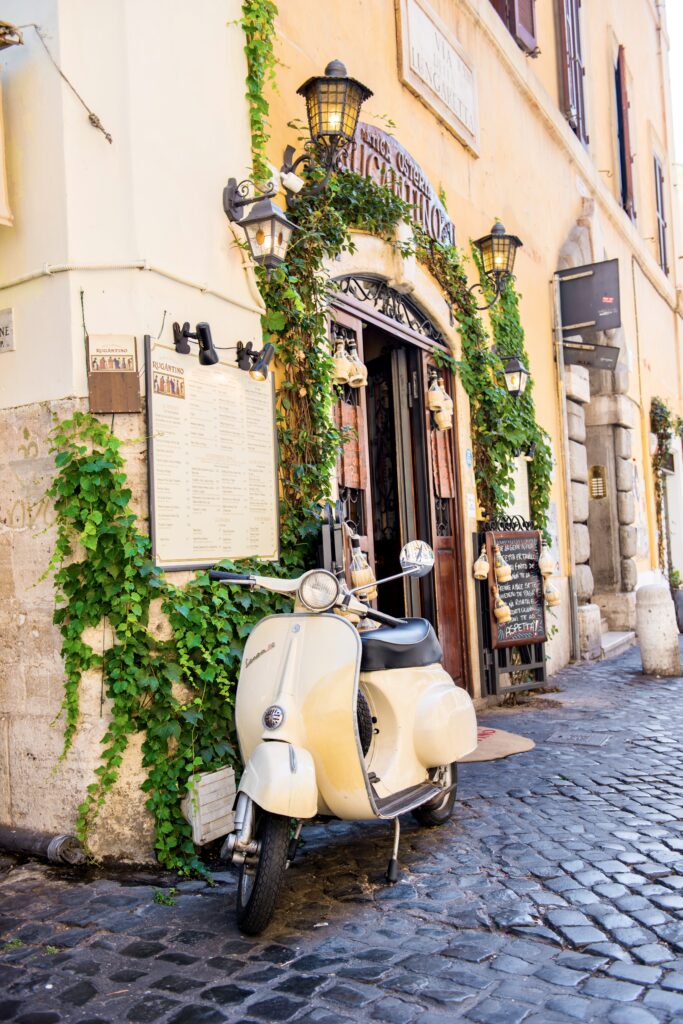
10 Days In Italy Itinerary
Day 1: rome.
Begin in Rome , the magnificent Eternal City.
Since you will be in the city for 3 days you may want to invest in the Omnia Rome and Vatican Pass , which gives you skip the access to several museums and free public transport.
Rome is a breathtaking concentration of history, art, and charm — every corner could fill your eyes, your camera, and your typical American romantic comedy.
Begin with the imperial ruins.
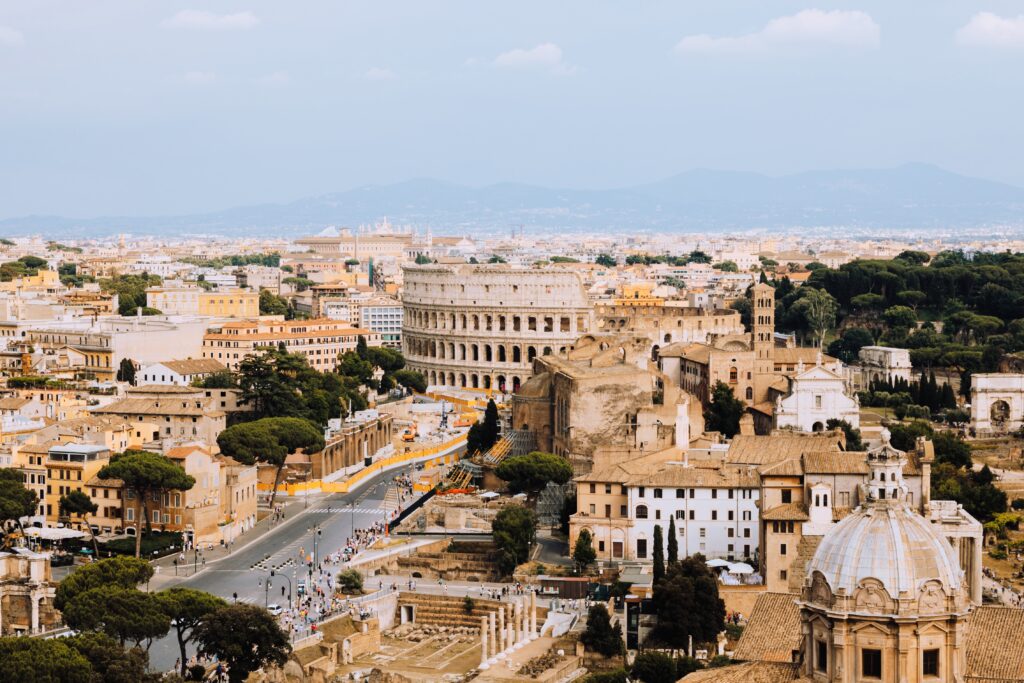
1. Colosseum
The 600 foot high Flavian Amphitheatre, nicknamed the Colosseum , was inaugurated in 80 A.D. with a grand 10 day festival.
Since then, it’s been synonymous with gladiators, chariots, and the emperor’s famous “thumbs up or thumbs down” edict. In the arena, gladiators and wild animals fought to the death.
The top level of the Colosseum was reopened in 2017. It provides sweeping views and may be the highlight of your visit.
If you’re DIY-ing the Colosseum, you need to reserve your entry time online well in advance. This is true even if you have a skip-the-line Roma Pass.
If you buy your ticket directly from the official website , you will specify the exact time and date. You can’t visit the Colosseum without a reserved entry time!
You can book a guided tour of the Colosseum or a tour that also includes the underground gladiator area of the Colosseum .
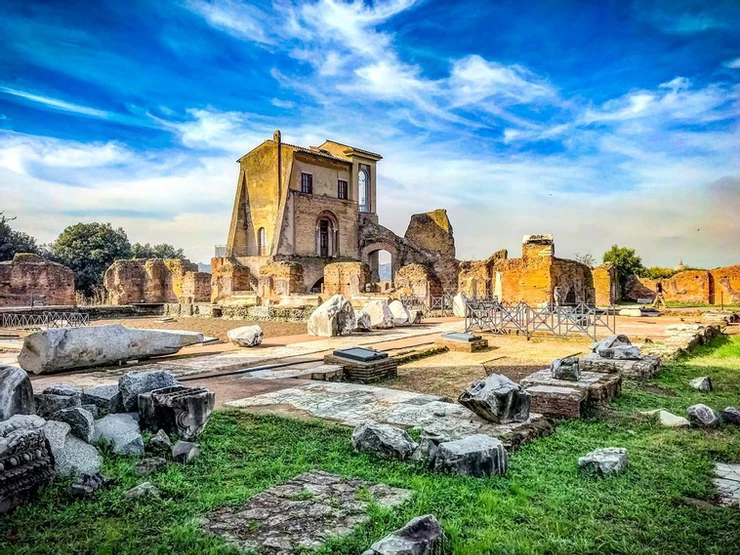
2. Palatine Hill
Palatine Hill is an archaeological treasure is believed to be the legendary birthplace of Rome. It’s dotted with the ruins of opulent palaces and imperial residences. You can get a sense of how the rich and famous of Imperial Rome lived.
Built circa 81 A.D., the sprawling Domitian’s Palace is the most impressive ruin. You’ll see ancient marble floors and crumbly ruins.
Aside from strolling around this lovely place, you’ll want to visit:
- Domus Tiberiana
- Palatine Museum
- House of Augustus
To see these sites, you’ll have to purchase a special SUPER ticket .
I highly recommend the House of Augustus. You’ll see rare and incredibly well preserved Pompeiian style frescoes. Three times a day there’s a sound and light show.
3. Roman Forum
After Palatine Hill, you move on to the Roman Forum . I advise having a guided tour here. There’s not much signage. It will be difficult to divine what you’re looking at without a guide to decipher the lovely rubble.
The forum is a rectangular valley running from Arch of Titus to the Capitoline Hill. The main road is the Via Sacre.
The forum was the beating heart of Rome, the seat of power, and its central showpiece. It was a grandiose district consisting of white temples, grand basilicas, and vibrant public spaces.
Click here for a skip the line ticket. You may also want to book a guided tour of all three imperial sites, which will take approximately 3 hours.
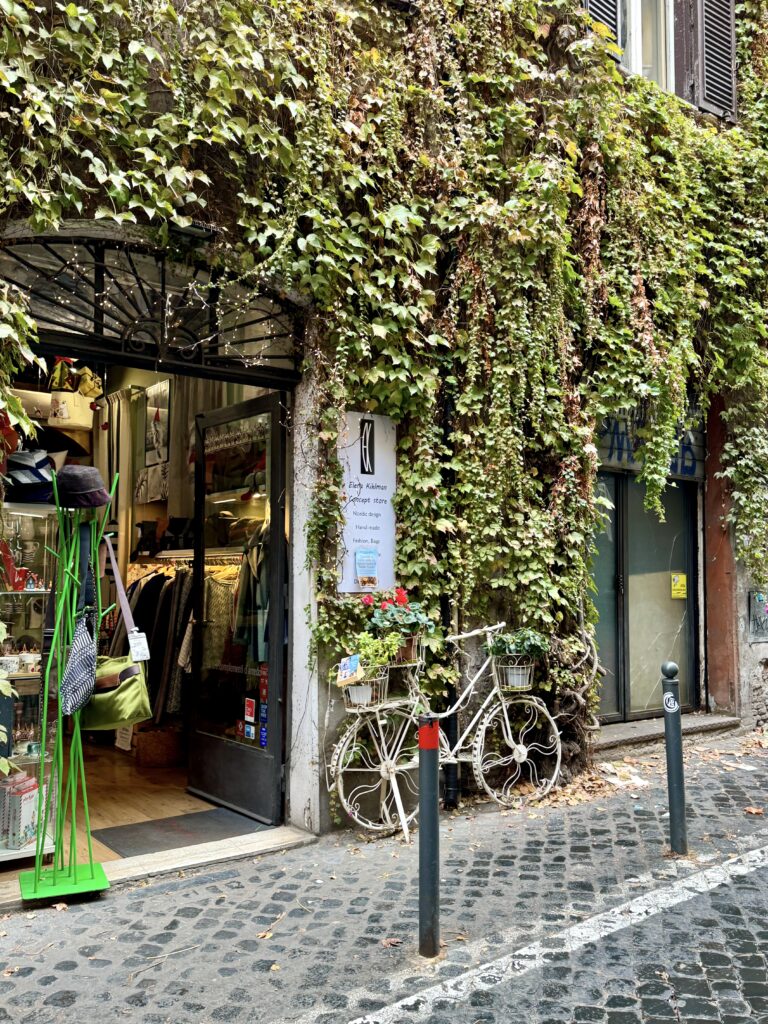
4. Monti Neighborhood
When you’re done exploring the ruins, head to Rome’s adjacent Monti neighborhood, just 5 minutes away.
Monti is Rome’s trendiest off the beaten path district. It’s packed with unique shops and hip eateries.
Be sure to get off the main drag and explore Monti’s cute side streets. There are great spots to eat on Via Urbana.
As one of Rome’s top foodie districts, Monti is also an excellent place to book a guided food tour .
Monti’s one must see is Santa Maria Maggiore Church . It dates to the 5th century A.D. and it has absolutely breathtaking Byzantine-style mosaics.
When you’re done in Monti, head over to the the Vittorio Emanuel II monument towering over Piazza Venezia.
Known as the Altar of the Fatherland, it’s one of Rome’s most recognizable landmarks. It was built to honor Victor Emmanuel II, the first king of a unified Italy, and is a symbol of Italian national identity.
For views, hike up to the second floor. For even better views, take the Roma dal Cielo elevator around the back up to the viewing terrace.
>>> Click here to book an elevator ticket
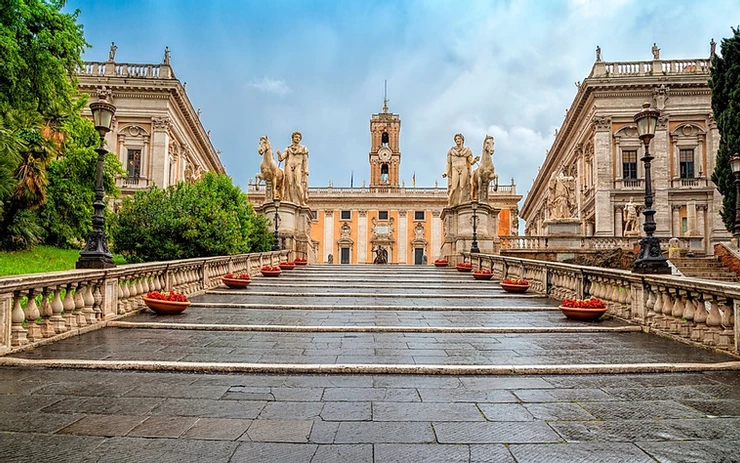
5. Capitoline Museums
Around the corner is Michelangelo’s stairway, rising to the Piazza del Campidoglio at the top of Capitoline Hill. At the tip top is the Capitoline Museums .
Inside, are some of Rome’s greatest treasures — the equestrian statue of Marcus Aureliusk, the original She-Wolf of Rome , and scads of ancient statues. There’s also a knockout view of the Roman Forum from the tabularium.
You’ll want to book a skip the line ticket in high season. If you’re a true fan of ancient sculpture, you can also book a guided tour of the museum.
When hunger calls after this hectic day, head to the delightful Jewish Ghetto neighborhood. It’s just a stone’s throw away, on the banks of the Tiber River.
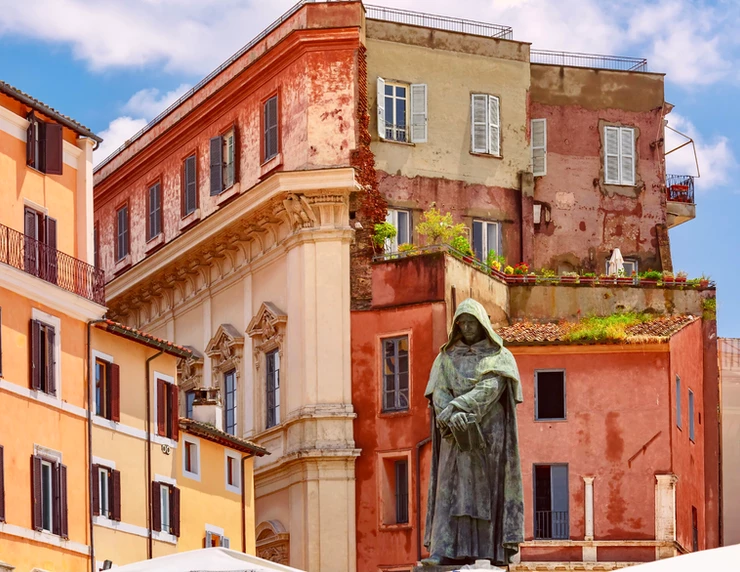
Day 2: Rome
Begin day 2 of your 10 days in Italy itinerary with a classic walk through Rome’s historic center .
1. Campo de’Fiori
Campo de’ Fiori is Rome’s colorful market square. Here, you’ll find fresh produce and can pick up some souvenirs like olive oil, pasta, or limoncello.
In the center is a statue of Giordano Bruno, a 16th century friar and philosopher who was imprisoned in Castle Sant’Angelo and burned at the stake for his scientific theories.
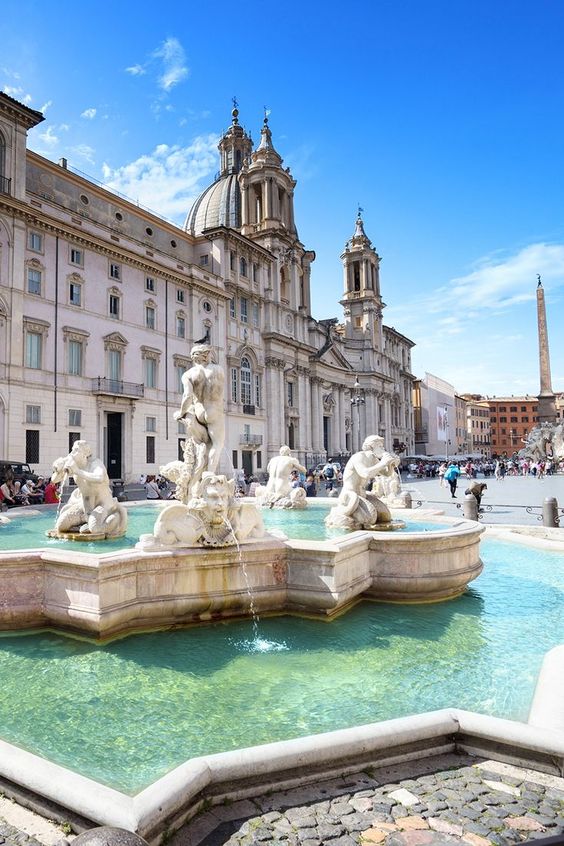
2. Piazza Navona
Your next stop is the Piazza Navona . The piazza is dotted with fountains by the foremost Baroque sculptor, Gian Lorenzo Bernini . It dates back to the time of Domitian, who used it as a racetrack.
The piazza is a lively place. There are cute cafes, streets performers, and fancy Baroque palazzi.
Peak inside the Church of Sant’Agnese , designed by the architect Borromini.
Or pop into the underground museum, the Studio di Domiziano and learn about the history of the piazza when it was used as a racetrack in ancient Rome.
3. Pantheon
Then, you’re off to Rome’s most famous temple, the 2,000 year old Pantheon . Built by Emperor Hadrian,the entrance boasts massive 40 foot single piece granite columns.
Inside is a magnificent dome with a giant oculus (or eye in the sky) that inspired the domes of St. Peter’s Basilica and the Duomo in Florence. If it’s raining, water falls through the oculus and out the drains in the floor.
The Pantheon used to be free to visit. But as of July 2023, it’s not anymore.
If you want to avoid a massive wait to go inside, you should pre-book a skip the line ticket . You can also book a 1 hour guided tour .
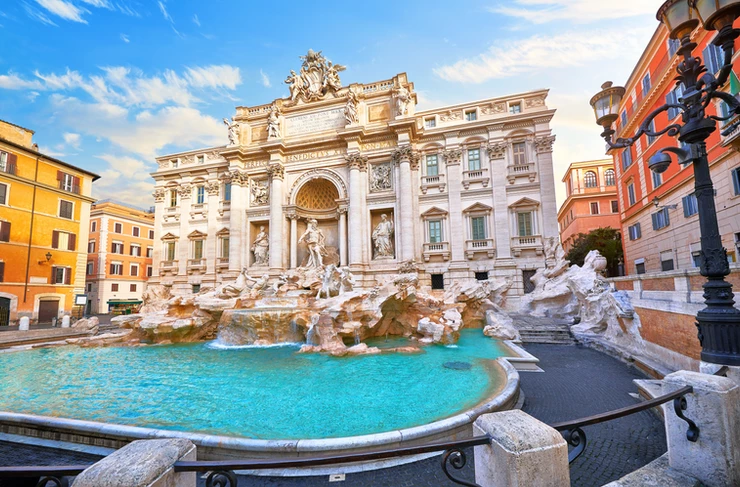
4. Trevi Fountain & Spanish Steps
Further on is the famous Trevi Fountain, an imposing Baroque monument designed by architect Nicola Salvi. The fountain is 85 feet high and 65 feet wide, making it Rome’s largest fountain.
In the center is the figure “Ocean.” Water pours from 24 spouts. If you’re superstitious, toss a coin over your shoulder to ensure your return to Rome.
For lunch options, there’s a cute little hole in the wall restaurant nearby, Ristorante Sora Lucia, which serves up delicious gnocchi for locals.
Piccolo Buco is also a tiny and delicious pizzeria only one minute from the Trevi Fountain. And La Prosciutteria serves up killer porchetta sandwiches.
After lunch, head down Via Sistina to the Spanish Steps. I think they’re a bit overrated, but the staircase is one of Rome’s iconic sites.
At the foot of the steps is another famous Bernini fountain, the Sinking Boat Fountain .
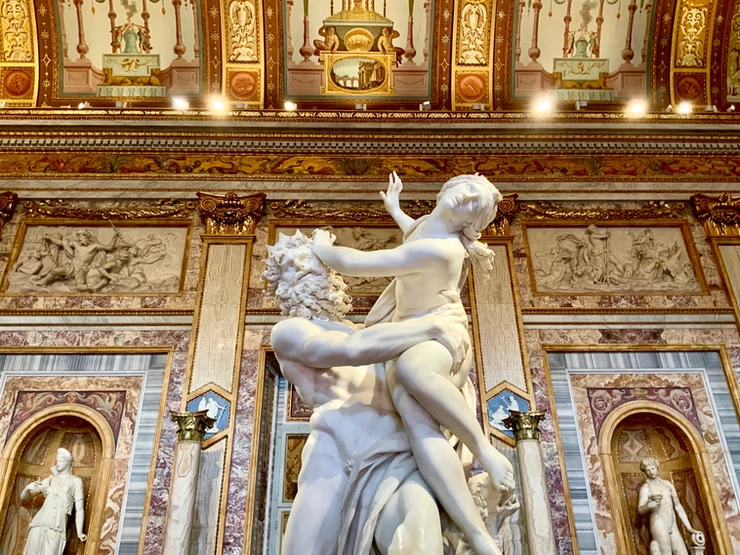
5. Borghese Gallery
After lunch, take in one of my favorite art museums in the world — the Borghese Gallery . You may think I’m exaggerating, but I’m not.
Incredible masterpieces are set in a stunning villa filled with frescos and marble. It houses an impressive collection of Roman, Renaissance, and Baroque art, with stunning pieces by Bernini, Raphael, Caravaggio, and Canova.
The Borghese has three of Bernini’s best works, including the Rape of Prosperina shown above.
It has six rare Caravaggio paintings, a tenth of the total Caravaggio ouevre in existence. And you could spend hours admiring the magnificent Venetian Room.
You’ve absolutely must pre-book a ticket well in advance to visit the Borghese Gallery. Only a set number of people are allowed in every two hours.
6. Piazza del Popolo
When you’re done admiring the art, I recommend heading over to the west side of the Borghese Gardens, towards the Piazza del Popolo.
Pop into the Basilica of Santa Maria del Popolo to see two beautiful Caravaggio paintings for free. The view from the terrace overlooking the Piazza del Popolo is quite beautiful, particularly at sunset.
There are some good restaurants near the Borghese Gallery, if you want to stay in the area for dinner.
For gourmet food, try Oliver Glowig (Michelin-starred) or Sapori del Lord Byron. For a cozy informal setting, try Girarrosto Toscano.
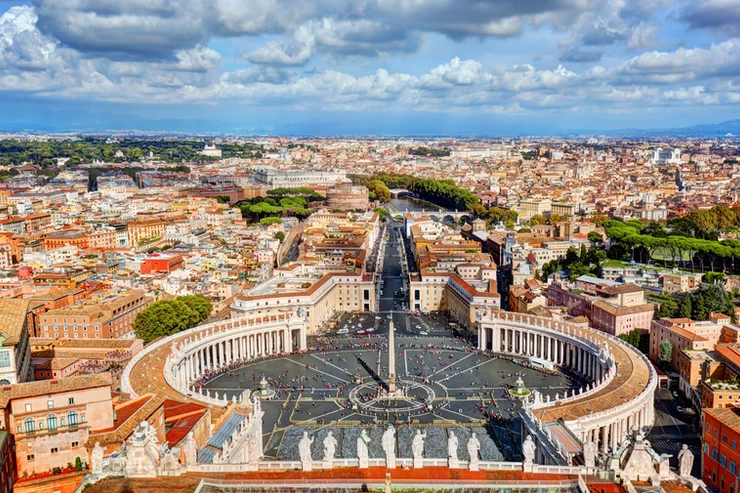
Day 3: Rome
1. vatican museums.
Start off day 3 of 10 days in Italy with a bang by visiting Vatican City .
Unless you arrive on a weekend. You don’t want to go on a weekend, ever. It’s too crowded.
So if your time in Rome falls on a Saturday or Sunday, flip flop the days of my sample itinerary around and push the Vatican to a weekday.
Unless you’re there in the dead of winter, it’s essential to have skip the line tickets or you’ll wait for hours. You can book a guided tour or do a DIY through the Vatican Museums with an audio guide.
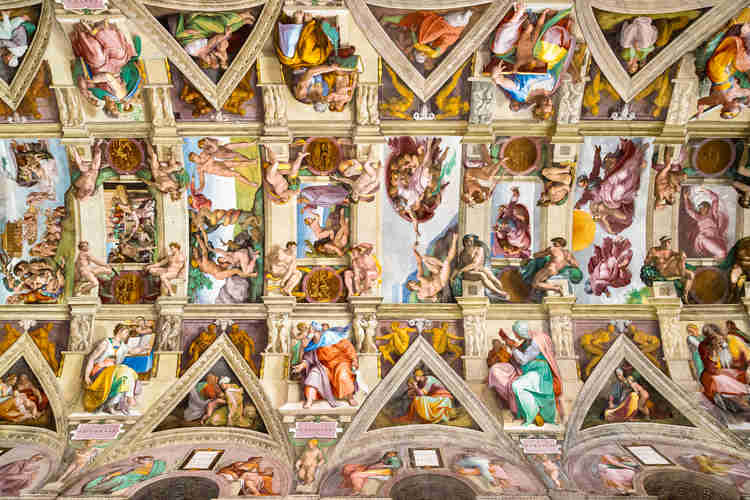
The Vatican holds one of the world’s greatest art collections.
Some of the most famous art works on the planet are there. If you’re an art or history lover, the Vatican is a must see site in Rome.
The highlight of the Vatican is the Sistine Chapel, adorned with Michelangelo frescos .
But you should also try to visit the Pinacoteca (painting gallery), the Raphael Rooms, the Pio-Clementine Museum (sculptures), and the Borgia Apartments.
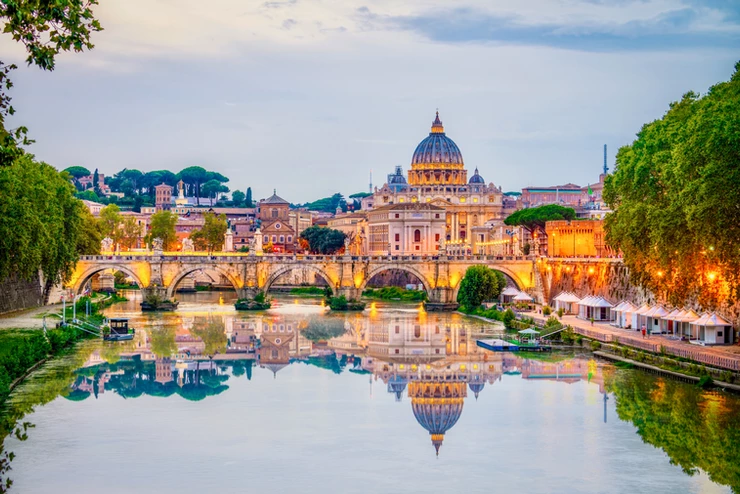
2. St. Peter’s Basilica
When you’re done admiring the Vatican treasures, head to St. Peter’s Basilica . This is the most famous church in Christendom.
Designed by Bramante, Raphael, and Michelangelo, it’s a true Renaissance masterpiece. The dome of St. Peters is the tallest in the world.
The basilica is the burial place of St. Peter and past popes. It houses the famous Bernini Baldachine altar and Michelangelo’s tragically beautiful Pieta .
St. Peter’s is free to enter, but you have to go through security and you should expect long lines. You can pick up an audio guide inside.
I recommend booking a dome climb . This is where you have the iconic view of the Bernini-designed St. Peter’s Square and a panoramic view of Rome.
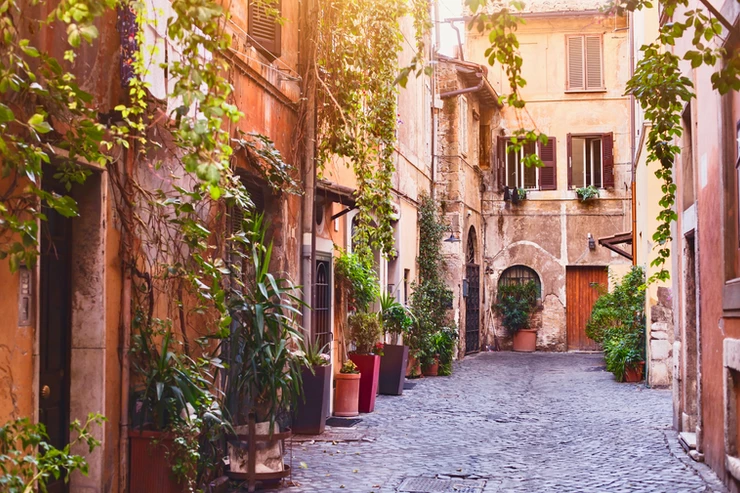
4. Trastevere Neighborhood
From here, unless you want to burn off some pasta, I recommend taking a taxi to Rome’s atmospheric Trastevere neighborhood for the rest of your day.
Trastevere is a village within a city, with the laidback vibes of small town Italy. Its lovely cobbled and cafe-lined streets are vastly quieter than the cacophony of central Rome.
If you have time, visit Villa Farnesina , an underrated small museum in a beautiful setting. It’s only open weekdays until 2:00 pm.
This sumptuously decorated villa was built in the early 1500s for one of Europe’s richest Renaissance men, Agostino Chigi. The villa has some magnificent paintings and frescos by the High Renaissance artist Raphael .
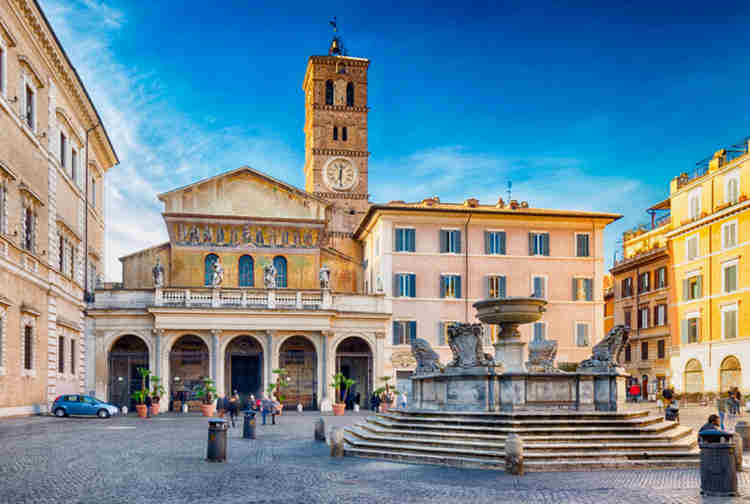
Next, take a stroll in the lively Piazza di Santa Maria, which is the heart of Trastevere.
Head into Santa Maria Basilica, the oldest church dedicated to Mary in Rome.
It’s time for happy hour. Settle in for some wine at Enoteca Ferrara, which has a huge wine list. You can eat here too. I had a divine puttanesca.
Trastevere is also an amazing place to go on a food tour in Rome or a guided walking tour .
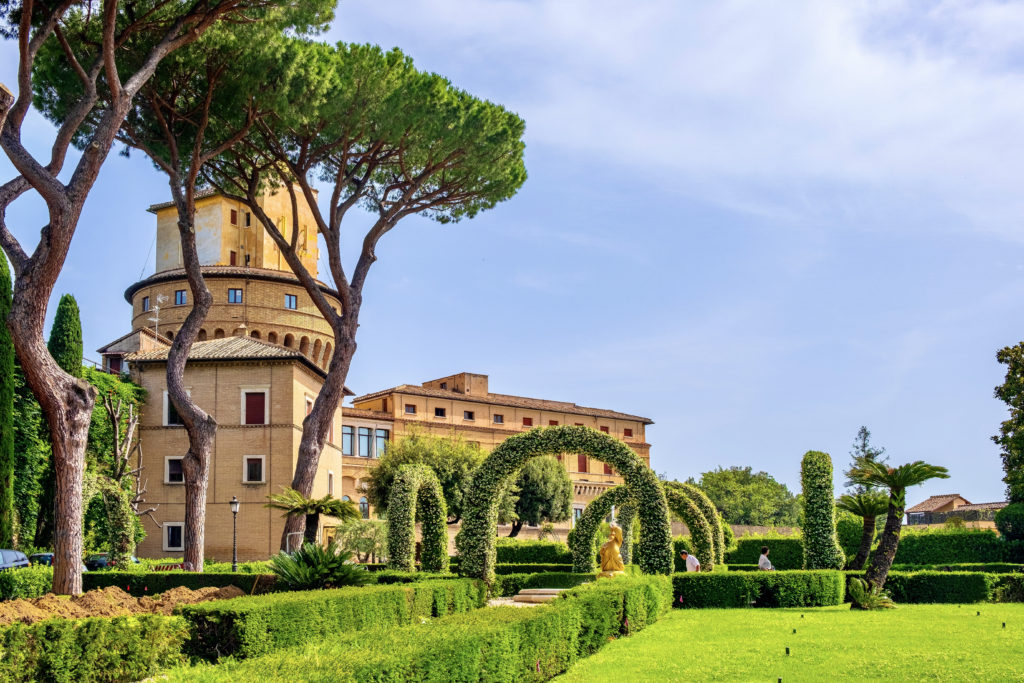
Where To Stay In Rome
If you’re a first timer in Rome, you may want to stay in the historic center around the Pantheon or Piazza Navona.
Some good options are the Liberty Boutique Hotel , the Hotel Maala t , Deco Roma , or Hotel Hassler Rom a . I love the Hassler!
If you want to stay near the Imperial ruins, Palazzo Manfredi and the I nn at The Roman Forum are great choices. The Manfredi has exceptional Colosseum views from its rooftop.
If you want to stay in the quieter Monti area, which makes a great base, the Palazzo Manfredi , Villa Spalletti Trivelli (Roman townhouse), and Roma Luxus (former 18th century palace) are fantastic choices.
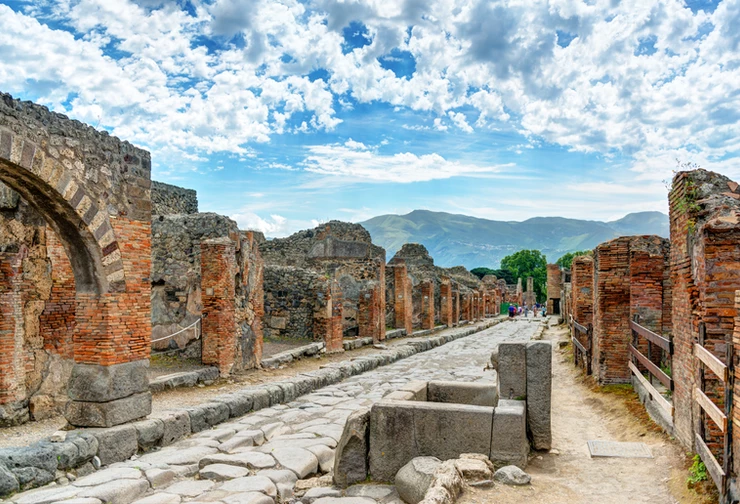
Day 4: Day Trip Options: Pompeii, Tivoli, or Orvieto
On day 4 of your 10 days in Italy, it’s time for a day trip from Rome . There are so many fantastic options.
But, to narrow your choices down, here are my three favorites:
- (1) Pompeii
- (3) Orvieto
You can pick one based on your individual preference and how much time you want to spend traveling.
Pompeii is a hike from Rome, 2 hours on the high speed train. But Pompeii is Italy’s most famous archaeological site, a living museum.
It’s definitely easiest to visit on a guided day tour from Rome .
But if you can get yourself there, you can then take a guided walking tour with an archaeologist to learn everything abut Pompeii.
In 79 A.D., Mount Vesuvius erupted and buried the city in 60 feet of ash. The city was entombed and preserved for many centuries. Beginning in 1748, archaeologists began painstakingly excavating the ruins.
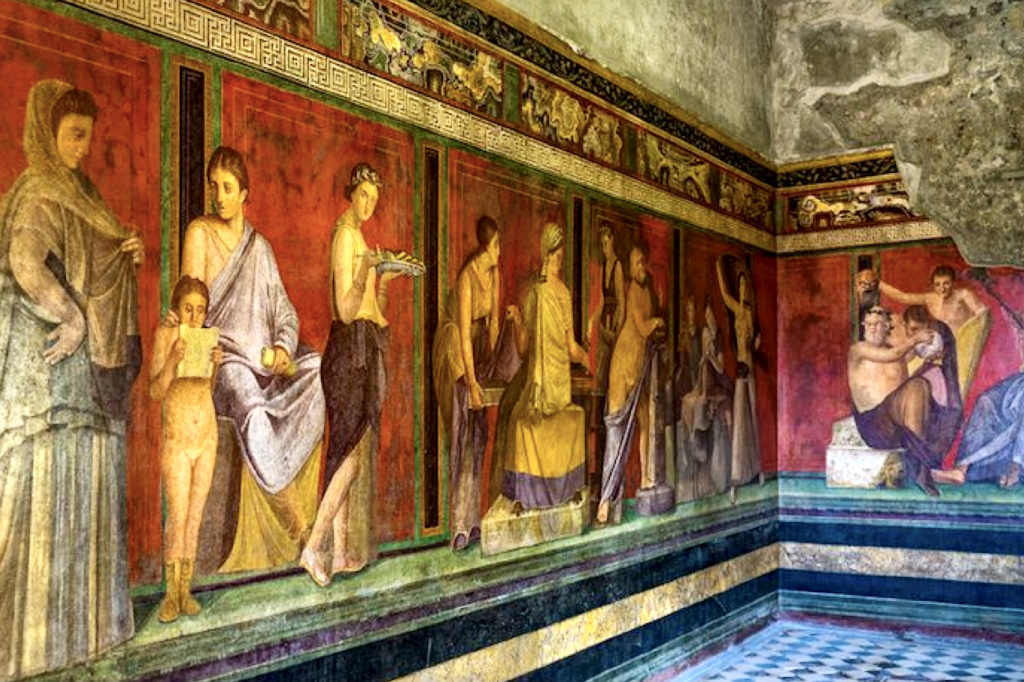
The ruins are a remarkable evocation of everyday Roman life. You can get a vicarious thrill sharing living space with ancient Romans.
In the complex, you’ll find roman baths, a roman forum, brothels, basilicas, a grand theater, and the oldest Roman amphitheater in the world.
When you’re done exploring the ruins, head to a vineyard or restaurant on the nearby Mount Vesuvius.
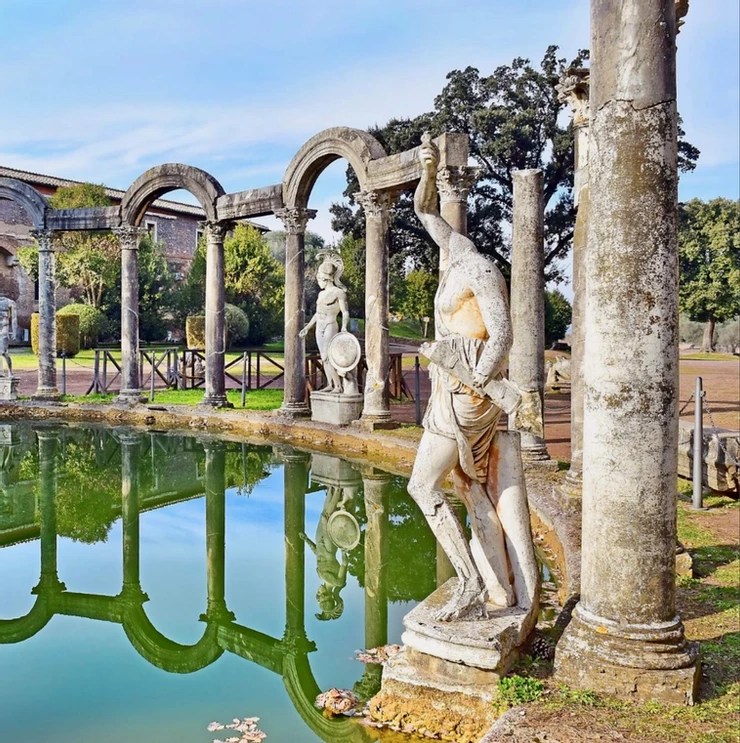
2. Tivoli: UNESCO Sites
Tivoli is a much easier day trip, just 30 minutes from Rome. Tivoli is home to two UNESCO World Heritage Sites: the sprawling ancient Hadrian’s Villa and the comely 16th century Villa d’Este, a Renaissance retreat.
You might want to book a tour , just to make it easier to visit both sites and get the full historical backdrop. That’s what I did.
If you’re fond of ancient history or are ruin luster like me, you’ll be fascinated and thrilled by the evocative ruins of Hadrian’s Villa .
Hadrian’s Villa is an important archeological complex. It’s the largest and most spectacular villa of ancient Rome, three times the size of Pompeii.
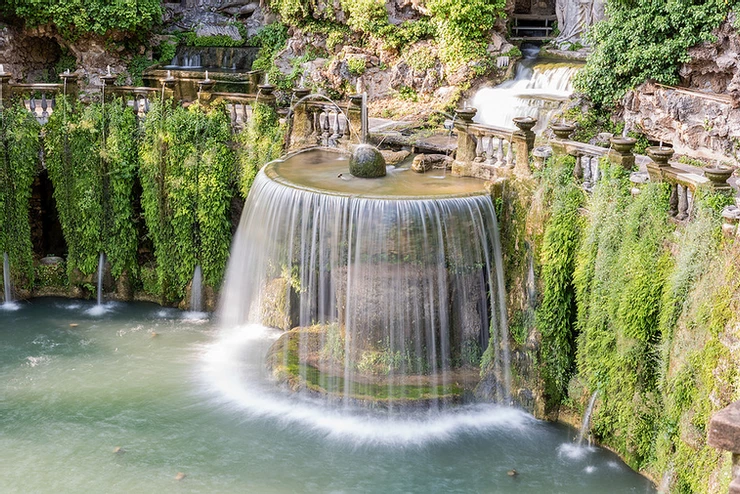
If you have ruin fatigue, Villa d’Este is a playground of whimsy, topped with a frescoed villa. The gardens are to die for — filled with sparkling fountains, moss draped grottos, and ponds filled with water lilies.
If you opt for Tivoli, you’ll get back early enough to take a last evening stroll through Rome’s centro historic.
If you want to really splash out on your final dinner, try La Pergola , with three Michelin stars, at the Rome Cavalieri Hotel. The hotel itself also has a superb art collection.
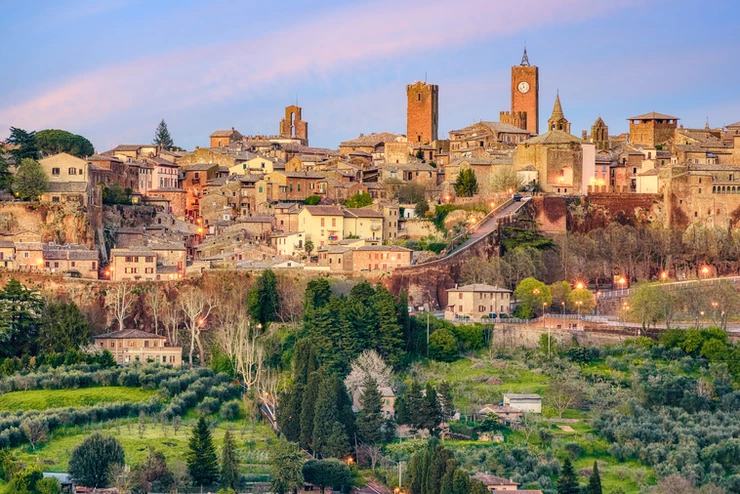
Your third option is to take the high speed train to Orvieto , a striking hill town in Umbria. There are three reasons to visit this charming town in Umbria — its beautiful cathedral with one of Italy’s most exciting facades, chianti, and ceramics.
Orvieto’s piece de resistance is Orvieto Cathedral . It’s one of the most beautiful and ancient churches in Italy.
The cathedral is a riveting ensemble of spires, spikes, golden mosaics, statuary, stained glass, and black and white striped marble. And that’s just the facade.
Inside, the Chapel of San Brizio has one of the Renaissance’s greatest fresco cycles, by Luca Signorelli.
Orvieto is an easy train ride (1 hour) from Rome, if you want to get there yourself. You can also book a guided tour from Rome that includes both Orvieto and Assisi .
I booked this 2.5 hour guided private walking tour of Orvieto. My guide was Emma and she was excellent, making the cathedral and its beautiful art works come to life.
Day 5: Florence
Day 5 you’re in Florence, the gorgeous”Cradle of the Renaissance,”
1. Florence Cathedral Complex
Begin at the Florence Cathedral complex. It includes the Duomo, the baptistery, Giotto’s bell tower, and the Duomo Museum.
You have to be organized to visit the Duomo and climb the dome. It’s an exceedingly popular activity. It’s absolutely essential to pre-book a ticket to climb Brunelleschi’s dome .
You can also book a combination guided tour for the Baptistery, Duomo Museum and a dome climb. This 3 hour combination guided tour covers the four attractions I’ve just mentioned, plus Giotto’s bell tower.
You should start with the stunning Duomo Museum to get the historical backdrop for all these structures. The museum is housed in the Piazza del Duomo at the back of Giotto’s Bell Tower, behind the Duomo apse.
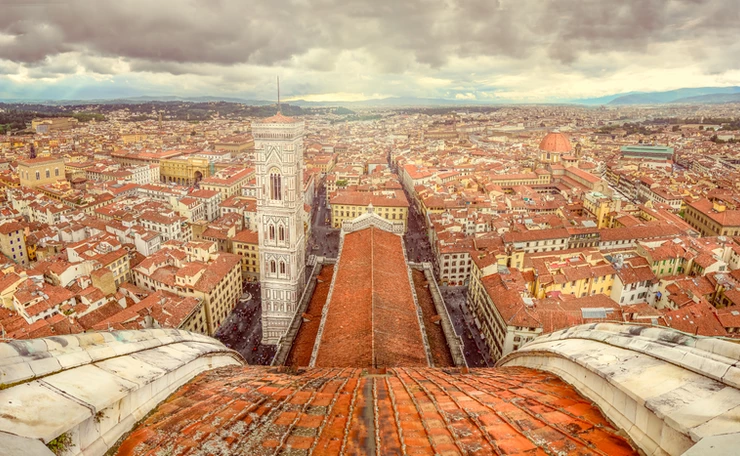
The museum space is a fabulous treasure box of sculpture. Its rooftop terrace also offers a mesmerizing view of Brunelleschi’s dome.
Then, head to Florence Cathedral. The Duomo is the most prominent, and popular, landmark in Florence.
It was built over 172 years, beginning in 1296. Florence Cathedral is made of brown sandstone and beautifully faced or “frosted” with pink, green, and white marble.
Filippo Brunelleschi’s magnificent terra cotta colored dome, built from 1420-36, is the highlight. The burnt orange cupola is the very symbol of Florence.
It’s decorated with frescos by Giorgio Vasari , a Florentine artist and the world’s first art historian. The views from the top are amazing.
Next, stroll to the Baptistery , in front of the main facade of the Duomo. Dating from 1059, it’s over a thousand years old.
The Baptistery sports three magnificent sets of bronze doors. designed by Lorenzo Ghiberti and Nicola Pisano. Inside, is a stunning golden Byzantine style ceiling mosaic telling the story of the Last Judgment.
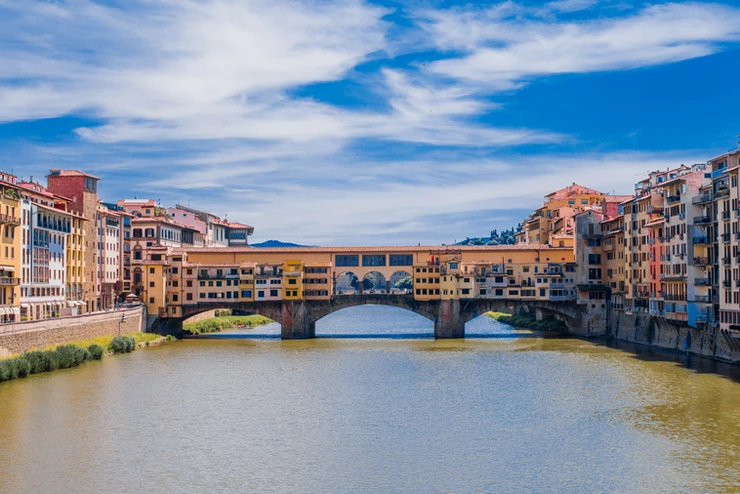
Break for lunch and a wander, enjoying the joys of a traffic free Florence.
Try Casa del Vino , where you can get sandwiches, crostini, or charcuterie plates with a delicious glass of wine. All’Antico Vinaio is also a must try, just minutes away from Piazza della Signoria .
2. Ponte Vecchio
Then, take the classic stroll across Florence’s storybook bridge, the Ponte Vecchio. It looks like cobbled together houses suspended over the Arno River.
The bridge has three arches topped with a jumble of charming shops. Nowadays, you can buy expensive jewelry on the Ponte Vecchio.
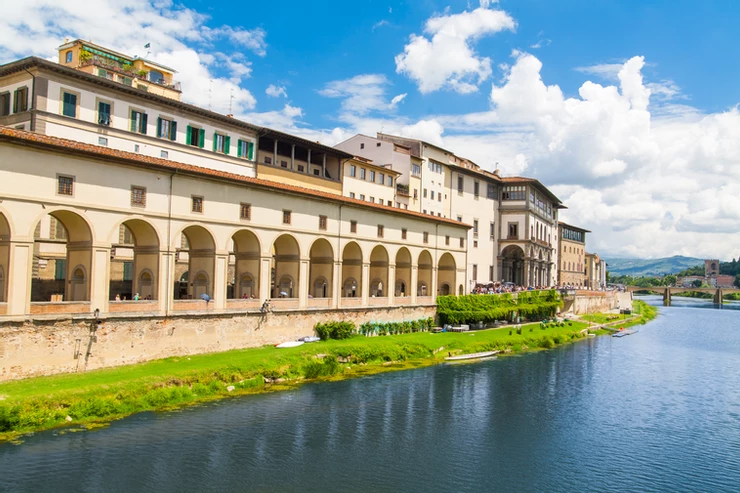
3. Uffizi Gallery
In the afternoon, head to the Uffizi Gallery, Florence’s #1 sight. It houses the world’s best and most abundant collection of Italian medieval and Renaissance art.
The museum is a crowd pleaser, the third most visited site in Italy. The Uffizi deserves its accolades.
The Uffizi boasts some of the best art in Italy . There are seminal works from the 13th to 18th centuries. Here’s where you’ll find one of the world’s most iconic paintings, Sandro Botticelli’s Birth of Venus .
You can’t visit without a s kip the line timed entry ticket .
At night, get an apertivo at the atmospheric Osteria dell’Enoteca.
For dinner, indulge at Trattorio da Tito not far from the Accademia, or Bobo’s Trattoria. Alternatively, take a guided food tour for the total Florence food experience.
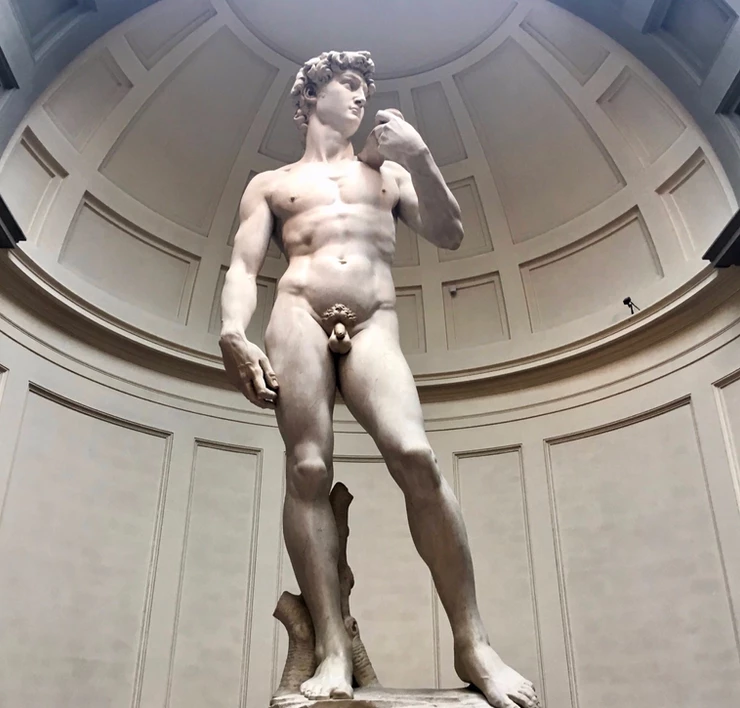
Day 6: Florence
1. michelangelo’s david.
Start you morning bright and early at the Accademia Gallery . After the Uffizi, the Accademia is Florence’s most visited museum.
People flock in to see what is probably the world’s most famous sculpture, Michelangelo’s commanding statue of David .
The 17 foot sculpture is considered the embodiment of male beauty, a Calvin Klein-like model of physical perfection. David was commissioned for a niche of the Duomo.
Aside from David, there are plenty of other magnificent works of art to admire.
You’ll find Michelangelo’s Slaves and bronze busts of Michelangelo by Daniele da Volterra. There are also paintings by Andrea del Sarto, Fra Bartolomeo, and Botticelli.
Click here to pre-book a timed entry ticket, which I highly recommend doing to avoid long lines. Be sure to get in the right line for your time slot when you arrive.
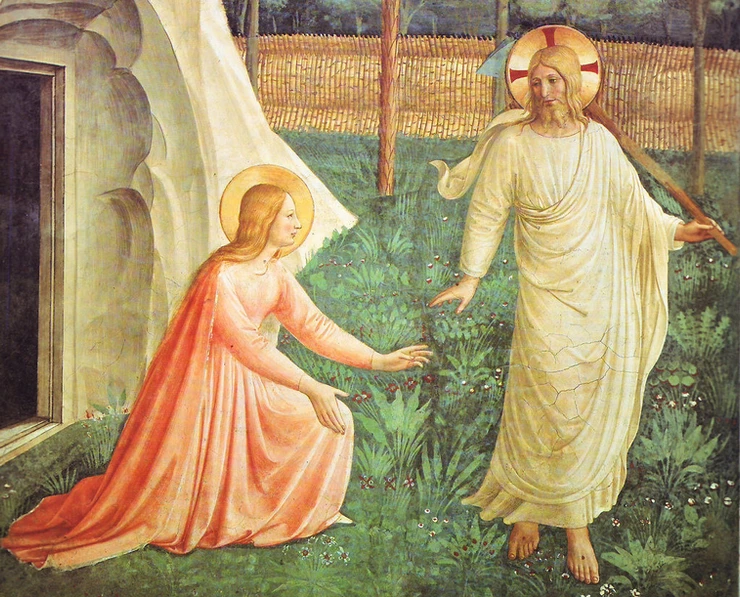
2. San Marco Monastery
When you’re done at the Accademia, head a few blocks to another amazing Florence art spot, the Museum of San Marco Monastery .
San Marco is an extraordinary decorative complex, one of the most unusual things to do in Florence. You can admire Fra Angelico’s art in its original in situ location and understand how contemporary audiences experienced it.
At this Renaissance convent-museum, you travel back in time to a nearly perfectly preserved 600 year old Dominican monastery.
Click here to pre-book a tick to San Marco. Or, and this I highly recommend if you’re interested, click here to book a guided tour where you learn all about Fra Angelico, Savonarola, and the Medici.
You’re likely ready for lunch. This is a good time to explore the San Lorenzo markets.
There are two of them, an outside street market and an indoor food court known as the Central Market.
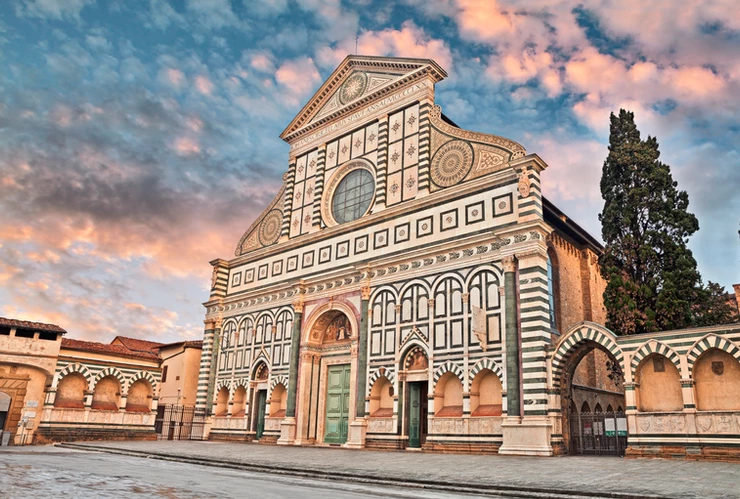
3. Santa Maria Novella
After lunch, tour the beautiful Basilica of Santa Maria Novella and the Piazza della Repubblica. Santa Maria Novella was founded in 1279 by a Dominican order.
The basilica has a similar design to the Duomo, with polychrome and white marble create a striking front facade.
The interior is a true marvel. It holds one of the most famous paintings in Italy, the Holy Trinity by Masaccio.
You’ll want to inspect three important highlights — the Strozzi Chapel, the Filippo Chapel, and the Spanish Chapter House.
Click here to book a guided tour of Santa Maria Novella and its ancient pharmacy.
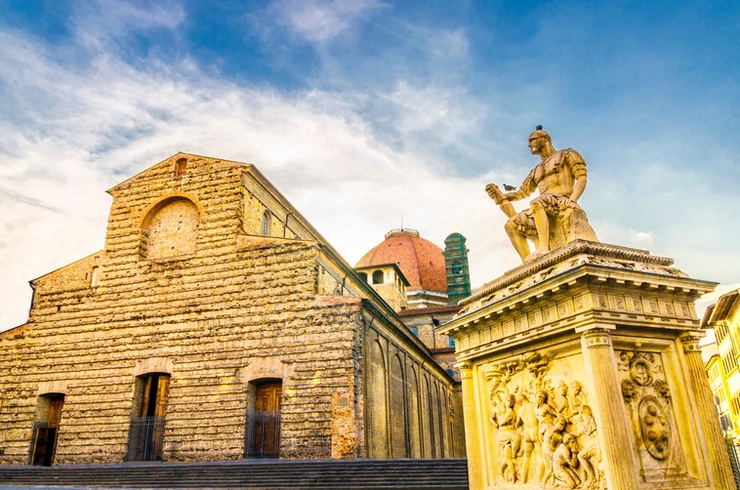
4. Basilica of San Lorenzo Complex
Next, head to the monumental complex of the Basilica of San Lorenzo . The complex is a veritable haven of Renaissance art and architecture, a must see for history buffs.
The complex is vast, including: the basilica itself, Brunelleschi’s Old Sacristy, Michelangelo’s New Sacristy, the Medici Chapels, the Medici Crypt, and the Laurentian Library. You will need to buy separate tickets for each attraction.
The highlight is the Medici Chapels . They are home to the largest number of Michelangelo sculptures in Florence, quite a selling point.
This is a popular spot and tickets are likely to sell out. Click here to pre-book a ticket for the chapels. Click here to book a ticket and guided tour.
I also recommend checking to see if the Laurentian Library is open (it has fluctuating hours). Michelangelo designed the library and it’s considered a masterpiece of Mannerist architecture.
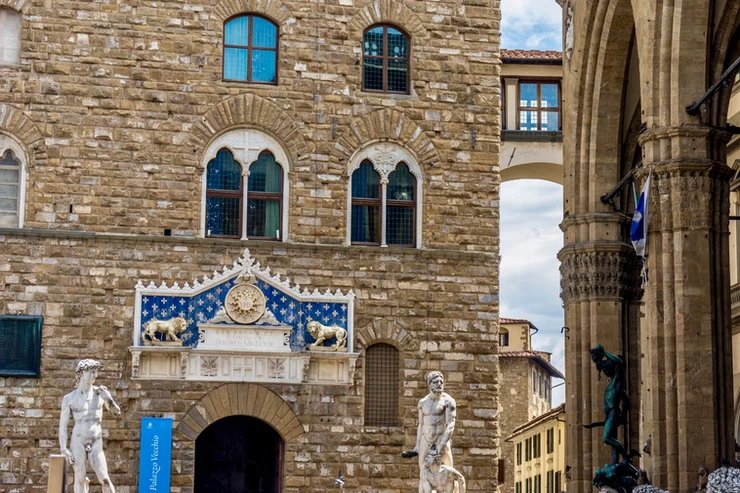
5. Palazzo Vecchio & Piazza della Signoria
In the evening, head to the magnificent Palazzo Vecchio . It’s one of the few must see sites in Florence that’s open at night.
The Palazzo Vecchio was the seat of government and one of the three palace-residences of the Medici dynasty . It sits in the Piazza della Signoria , which is essentially a free open air sculpture gallery.
It’s definitely worth going inside the Palazzo Vecchio, though so many tourists don’t.
The Palazzo Vecchio is a doughty medieval fortress on the outside and a resplendant Renaissance palace on the inside.
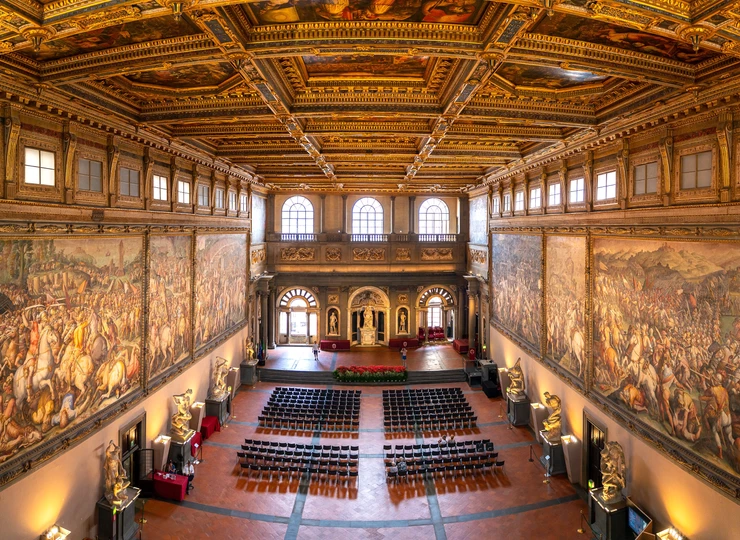
Inside, you can admire the stunning Michelozzo-designed courtyard and explore the grand Hall of the Five Hundred.
You’ll find sculptures by Michelangelo and Donatello and beautiful Giorgio Vasari frescos at every turn.
The palace’s Tower of Arnolfo can be climbed. It provides fantastic views over Florence and the Duomo. And the lines aren’t nearly as long as for Brunelleschi’s dome.
Click here to pre-book a ticket and audio guide for the Palazzo Vecchio. Click here to book a ticket and guided tour.
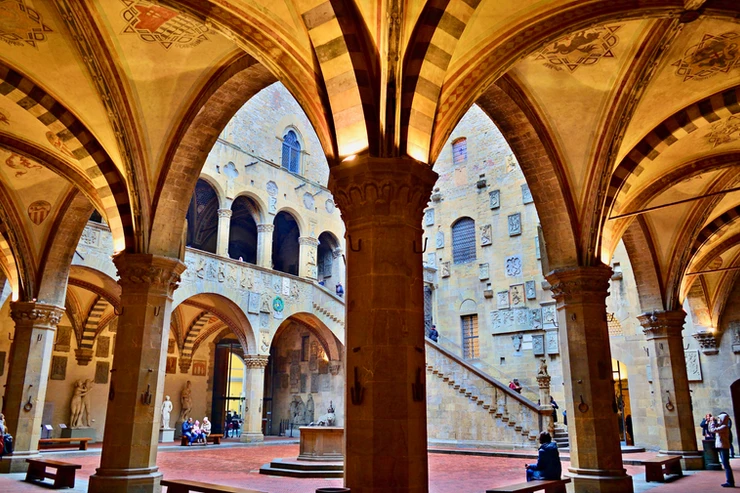
Day 7: Florence + Optional Half Day Trip To Fiesole
1. bargello museum.
The Bargello Museum houses an amazing collection of Renaissance sculptures. The most important works are in the Michelangelo and Donatello rooms.
Those include Michelangelo’s first major sculpture, Bacchus, and his Pitti Tondo , Donatello’s acclaimed Bronze David and St. George , and Gian Lorenzo Bernini’s Bust of Costanza.
If you’re a fan of sculpture, you may want to book a guided tour of the Bargello .
2. Basilica of Santa Croce Complex
After the Bargello, visit the amazing Basilica of Santa Croce .
In a city studded with magnificent churches, Santa Croce really stands out. Santa Croce has one of the greatest assemblages of paintings, sculptures, and funereal tombs in existence.
Santa Croce is a place of superlatives. It’s the world’s largest Franciscan church, a fine example of Italian Gothic style.
Santa Croce is home to many celebrity tombs (including Michelangelo’s), magnificent frescos, and Donatello sculptures. The basilica is a place of one stop shopping for Italian culture.
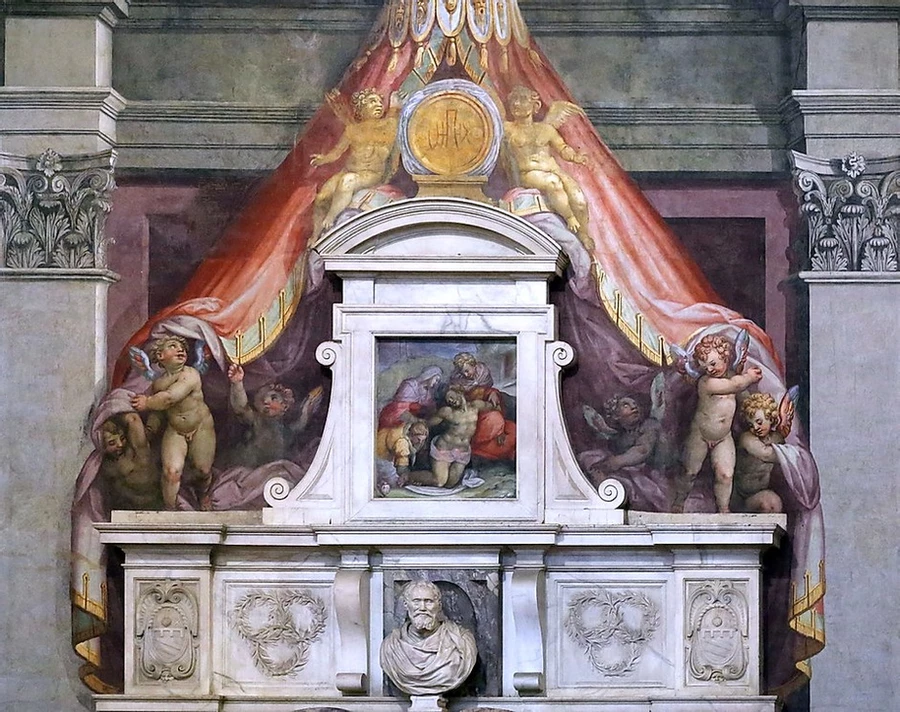
In particular, the frescoed chapels are impressive. The best ones are the Bardi Chapel, the Peruzzi Chapel, the Pazzi Chapel, the Baroncelli Chapel, and the Maggiore Chapel.
You’ll find frescos by Giotto, the greatest artist of the 14th century, and other Renaissance luminaries.
Click here to pre-book a skip the line ticket. Click here to book a tour of this important church.
If you want to lunch in the Santa Croce area, try the tiny but mighty Le Vespe Cafe . There will be lines, but it’s well worth the wait.
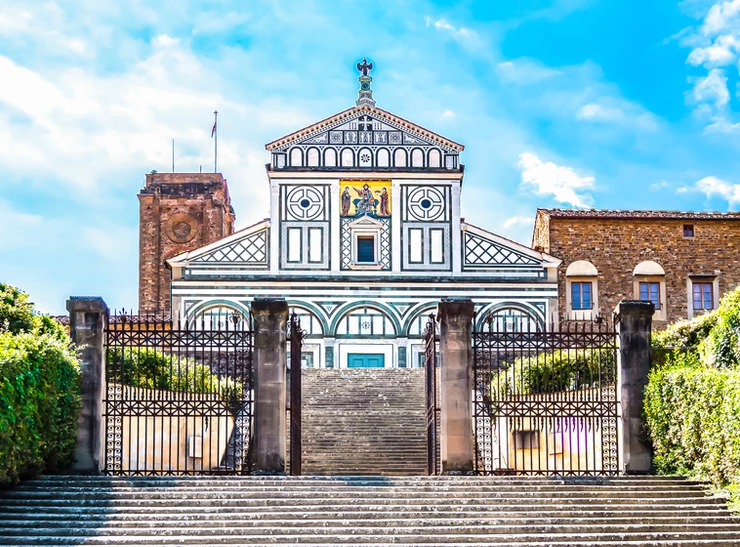
3. San Miniato al Monte
For your last evening in Florence, head to one of Florence’s iconic viewpoints . Piazzale Michelangelo is the classic lookout point.
But if you hike 10 minutes further uphill, you’ll come to the Basilica of San Miniato al Monte , Florence’s crowning glory.
The ancient church is a unique and harmonious blend of medieval architectural styles, pre-dating Florence’s Renaissance treasures. Behind the church is a monumental cemetery with beautiful funerary art and sculptures.
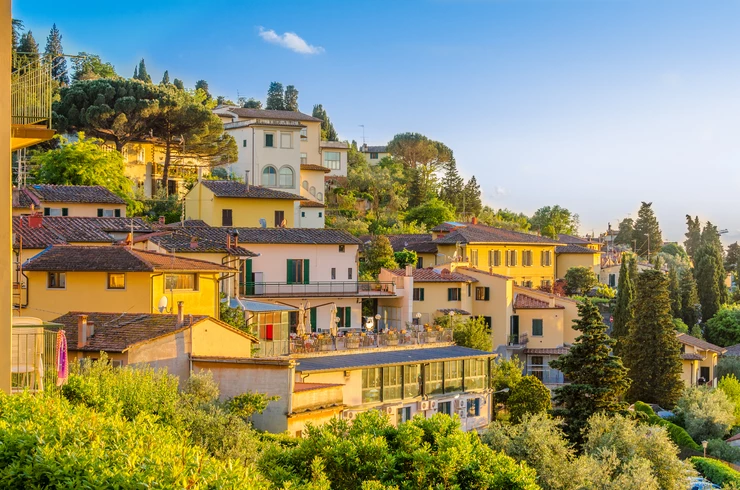
4. Optional Half Day Trip to Fiesole From Florence
If you can tear yourself away from Florence, head to nearby Fiesole. Located high above Florence in the Tuscan countryside, Fiesole is the quickest and easiest day trip from Florence .
You can actually walk there in an hour. If you don’t want to hoof it, Bus #7 leaves from near Piazza San Marco. You could easily wile away a half day in Fiesole, escaping Florence’s adoring crowds.
If you’re a ruin luster or history buff, Fiesole will suit. Fiesole pre-dates Florence, with Etruscan roots from the 8th to 9th century B.C.
Be sure to visit the Etruscan-Roman Archaeological site, including a Roman aphitheater, Roman baths, and remains of Etruscan walls.
Also check out the the Monastery of San Francesco. This is the town’s highest point, with a wonderful panoramic view of the town.
Click here for an e-bike tour of Fiesole and the surrounding countryside.
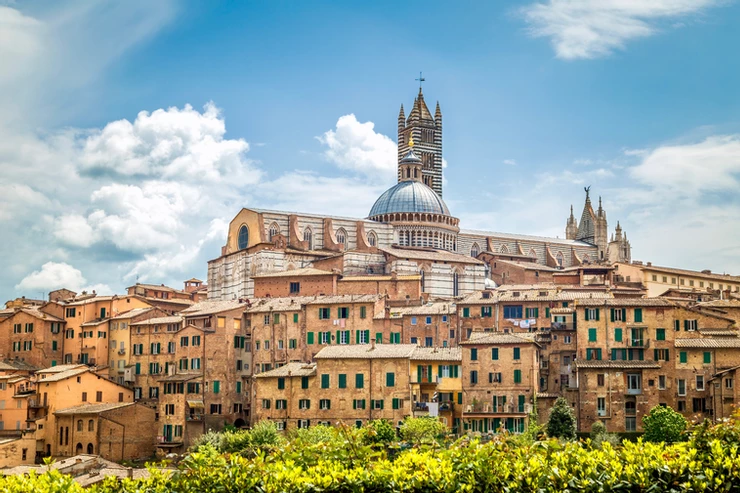
Day 8: Day Trip Options
On day 8 of your 10 days in Italy itinerary, plan a day trip from Florence. Head to either (1) Siena; (2) Pisa; (3) or a combination of Pisa and Lucca. Pisa and Lucca are just 10 miles apart.
1. Siena Option
Siena is one of the best towns to visit in Tuscany for its rustic medieval beauty, tasty food, and luscious chianti. If you want to bask in medieval times, there’s no better place.
You’ll want to spend ample time strolling through the pedestrianized historic center. It’s a well-preserved burnt orange dream littered with cute cafes and shops.
Siena’s most famous site is its Duomo, Siena Cathedral . It’s one of Europe’s most beautiful churches, especially for lovers of all things Gothic. Click here to book a skip the line ticket.
Siena’s Piazza del Campo is one of Europe’s most beautiful squares. It holds Siena’s landmark, the Piazza Pubblico , with one of Italy’s most famous fresco cycles.
If you’re there for dinner, don’t miss Taverna San Giuseppe. The restaurant is in a brick vaulted room in a 12th century building. It serves up fresh made pasta and other Tuscan comfort food.
Click here to pre-book a guided tour from Florence to Siena , which also includes San Gimignano . Foodies can take a food tour in Siena .
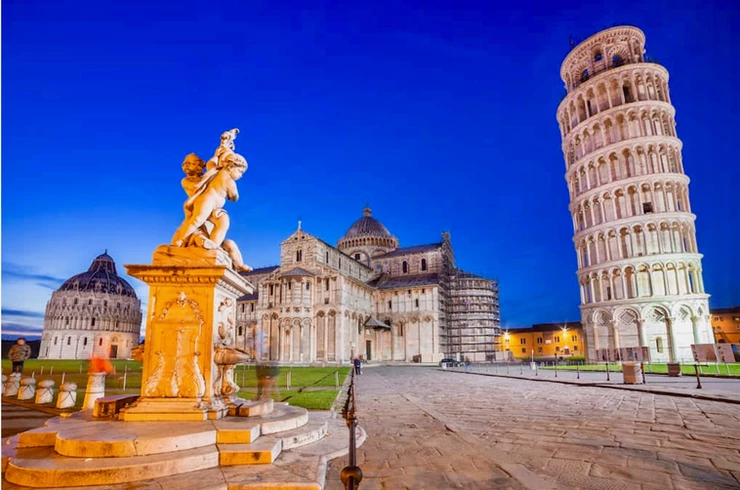
2. Pisa Option
No Tuscany road trip is complete without a stop in Pisa .
Most travelers visit Pisa for its famously Leaning Tower. But there are actually six sites on the Field of Miracles: (1) the exuberant Duomo; (2) the ornate Baptistery; (3) the Leaning Tower, and (4) three wonderful museums.
Climbing the tower is an incredibly in demand activity. So you’ll need to purchase tickets in advance to do the climb.
If you’re a history and architecture buff, you could easily spend the entire day in Pisa exploring the Field of Miracles. And then spend the evening wandering around Pisa’s picturesque old town.
If you get museum fatigue from Pisa’s intense concentration of art and architecture, in the afternoon head to Lucca for the rest of the day.
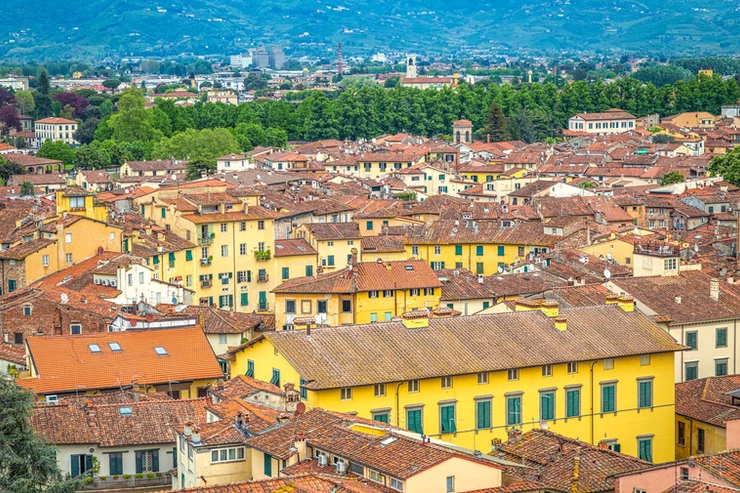
3. Pisa + Lucca Combo Option
Beautifully preserved Lucca is just 30 minutes away from Pisa and can be easily combined on a day trip. Lucca is like a mini-Florence.
The town is still entirely contained within its stout Renaissance walls. The walls are like a circular park for pedestrians and bikers, with beautiful views over the region. (Walking the entire wall takes about 1 hour.)
Lucca doesn’t really have any must see sites, which means its under the radar for most tourists. Lucca’s appeal lies in its relaxed old world medieval charm.
It’s perfect for aimless strolling along the pretty streets and piazzas. Lucca’s central square, Piazza Anfiteatro, is an enclosed piazza built around an ancient Roman arena.
In Lucca, you can take a cooking class or go on a biking food tour .
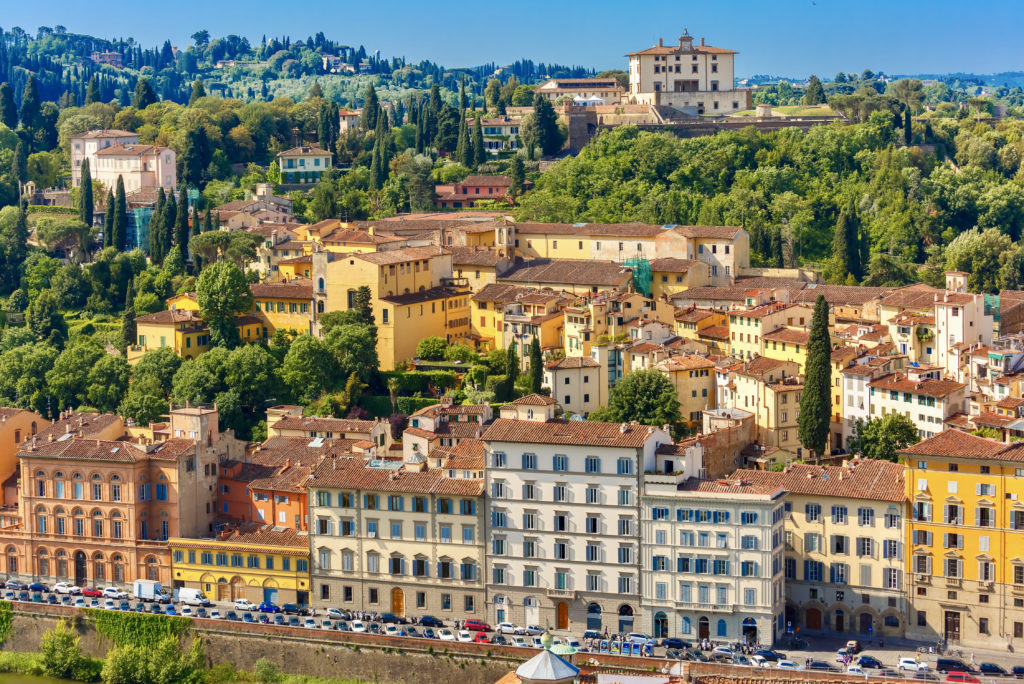
Where To Stay In Florence
If you want something central, book at the Hotel Brunelleschi or Portrait Firenze . Portrait Firenze is one of the most sought after hotels in Italy and is just steps away from the Ponte Vecchio.
Of course the Four Seasons is always beautiful and in a quiet location.
The Palazzo Vecchietti is housed in a beautiful 16th century townhouse. The St. Regis is a beauty too, right near Santa Maria Novella. Il Salviatino has a patrician feel and offers Duomo views.
In the Oltrarno neighborhood, I have really enjoyed Villa Cora with its stunning views and Renaissance style suites.
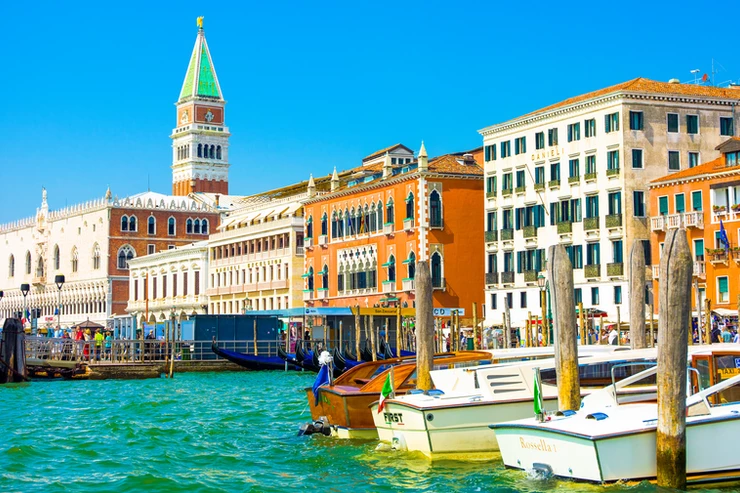
Day 9: Venice
Venice is a realm of its own, a singular creation nestled in a lagoon of northern Italy. It stands as one of the planet’s most captivating and picturesque urban gems, akin to a scene from a movie.
Venice’s unparalleled charm stems from its unique character. Floating gracefully on water, it appears like a bewitching mirage brought to life.
Roaming its intricate web of narrow streets is a must, as getting deliciously lost in its labyrinth is the best way to uncover its enchantment.
1. Doge’s Palace
Begin day 1 in Venice with a visit to the Doge’s Palace . The Doge’s Palace is one of Venice’s most iconic landmarks. Set in St. Mark’s Square, the palace is the very symbol of Venice.
This pink and white marble Gothic-Renaissance building was the official residence of the doges, rulers of Venice for more than 1,000 years. After a fire in 1677, it was largely rebuilt.
Inside the grand interior are some fabulous pieces of Renaissance and Venetian art.
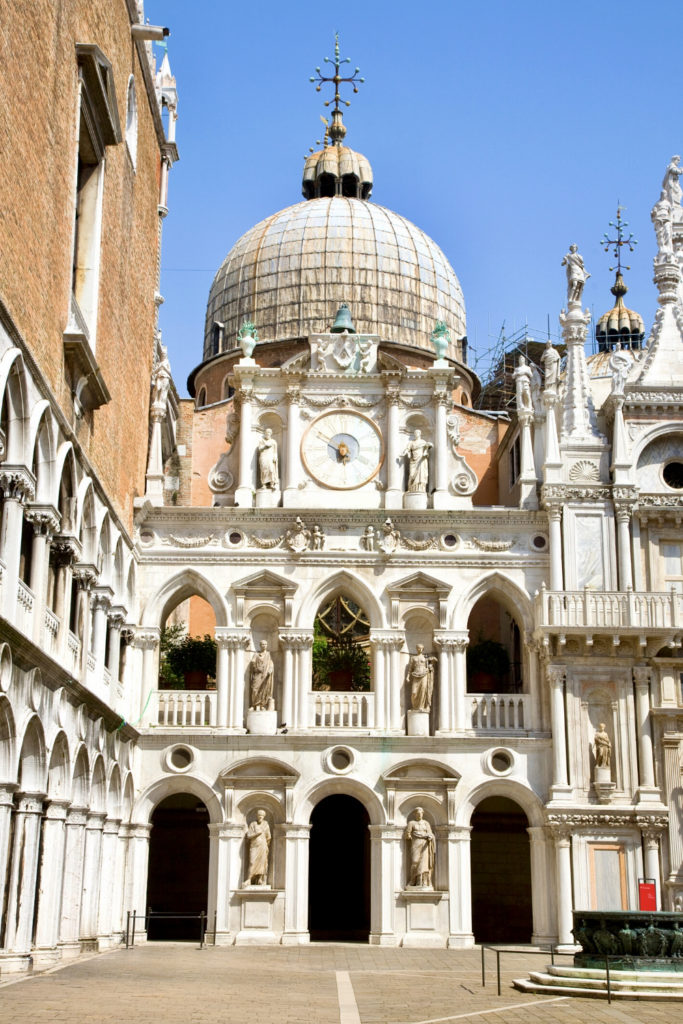
If you buy tickets for the Secret Itineraries Tour , you’ll pass into the judges’ chambers, interrogation rooms, and prisons. You’ll see the cell of the infamous ladies man Casanova, who made a miraculous escape.
And you’ll walk across the lovely Bridge of Sighs. Legend hold that prisoners took their last glances of Venice through the tiny barred windows and “sighed” before heading to the interrogation chambers.
A more romantic tale holds that when two lovers go under the bridge at sunset via gondola, their love will last forever.
Click here to pre-book a ticket to the Doge’s Palace, which is essential to avoid the long lines.
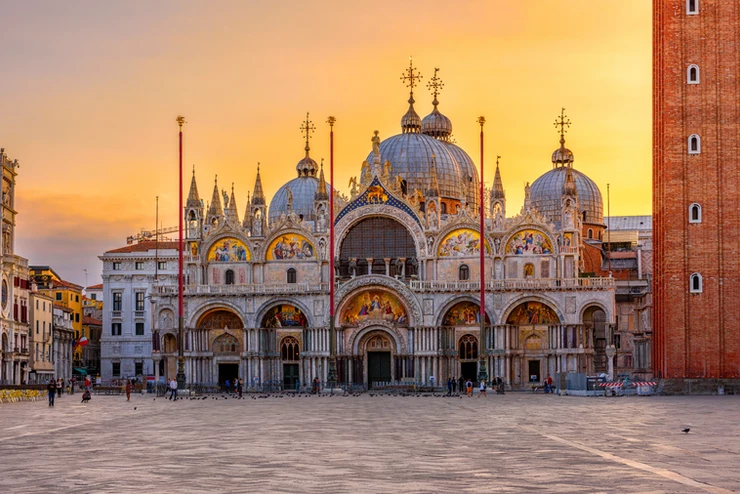
2. St. Mark’s Basilica & Piazza
After the Doge’s Palace, spend some time wandering around the San Marco area by foot. The square itself is magic, but spend some time walking along the back streets.
Then, venture into St. Mark’s Basilica , an astonishing tour de force of Italo-Byzantine architecture.
Consecrated in 1093, it’s one of the world’s most famous churches. Since 1807, St. Mark’s has been the cathedral of Venice.
The church has a unique and eclectic mix of styles and materials. Venice imported its art and architectural style from the Byzantine world.
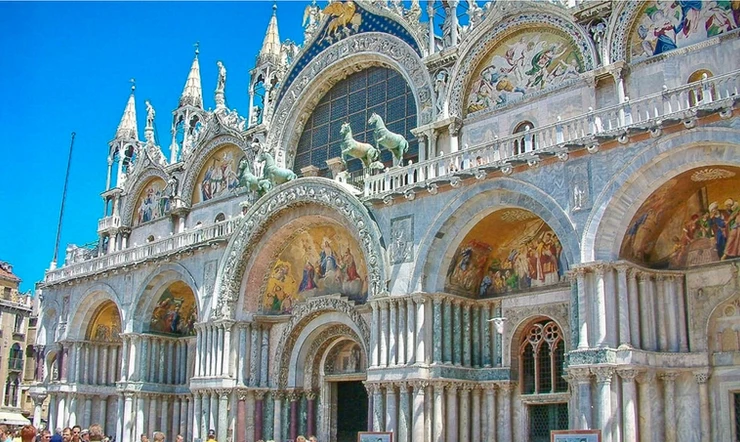
Just as Venice is like no other city in the world, St. Mark’s is like no other church in Europe.
Inside, it’s a golden extravaganza of mosaics. There are 90,000 square feet in total, symbolically concentrated high above in the celestial world.
In the middle ages, Venice was the leading school of mosaic in, ahead of Ravenna . The oldest mosaics in St. Mark’s date back to 1070, telling Old Testament stories.
St. Mark’s is always crowded. You must pre-book timed entry tickets or a guided tour .
To avoid crowds, you might also consider going on a night tour . There’s also a guided tour with access to the secret terraces , which is worth it for the views.
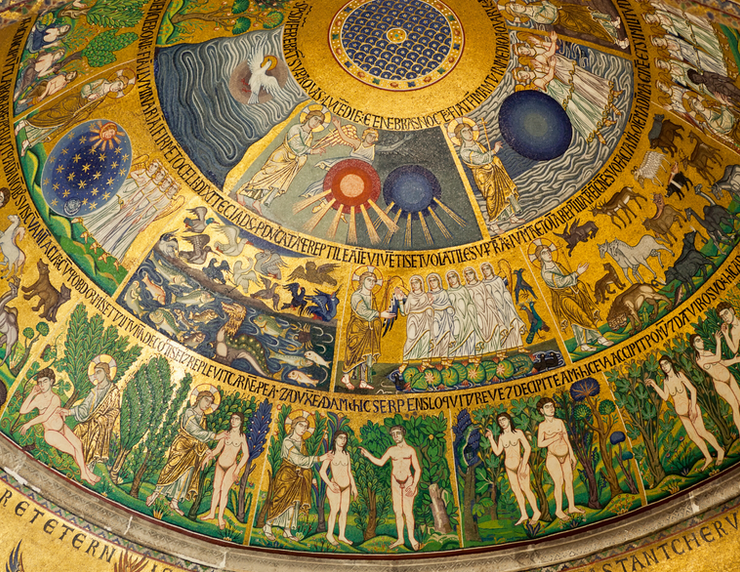
It’s time for lunch. For authentic Italian, stop in at Tuttinpiedi.
It serves up freshly cooked pasta in takeaway boxes. If you’d like a more leisurely sit down place, try Ai Mercanti or Osteria Enoteca.
3. Grand Canal
In the late afternoon, take a boat tour down the Grand Canal . It’s a classic, unmissable thing to do in Venice.
As you sail, you can admire Venice’s must see sites and dreamy palazzos.
Here’s my guide to the must see sites on the Grand Canal , with tips for riding the Vaporetto, which is Venice’s water bus.
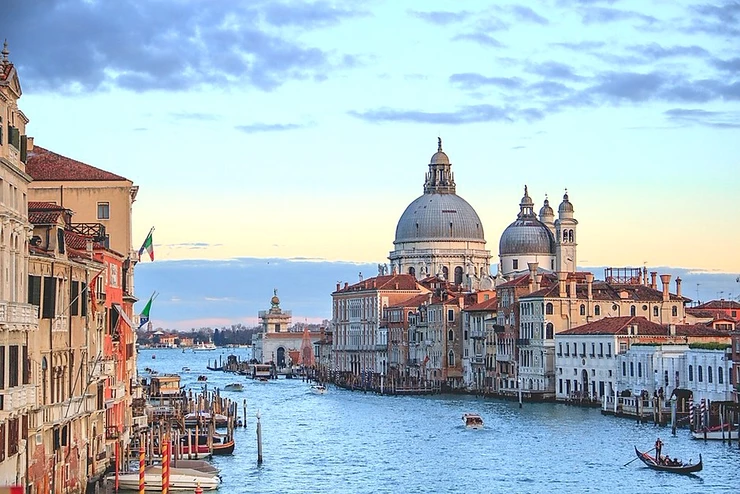
The most important buildings on the Grand Canal were residences of Venice’s powerful patrician families. Because of these sumptuous palaces, the Grand Canal has been described “as the most beautiful street in the world.”
One of the must see sites is the Basilica of Santa Maria della Salute. La Salute is a Ventian jewel of Baroque architecture.
Built on top of over 1 million timber piles, it was designed by local architect Baldassare Longhena, who also built Ca’ Rezzonico. La Salute’s most eye catching figure is its crown like dome, with a statue of Mary on top.
If you book a gondola ride down the grand canal , you can also admire Ca’ Rezzonico, Ca’ Grande, Palazzo Grasse, Ca d’Oro, and Ca Foscari.
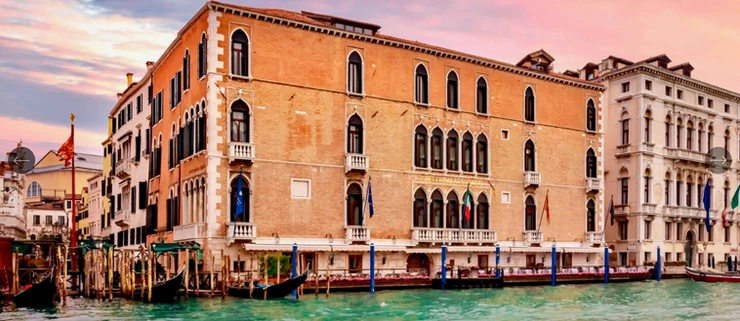
4. Gritti Terrace
For a pre-dinner drink, take in canal views at the iconic Gritti Terrace in the Palazzo Gritti. Built in 1525, the Palazzo Gritti is a Venetian Gothic wonderland.
Originally, the palace was the home of a doge. But now it’s an expensive luxury hotel.
The hotel is chock full of Venetian antiques, oriental rugs, and spectacular Murano glass light fixtures. It faces La Salute.
For dinner, if you’re a fan of fresh seafood, you can’t do better than the tiny restaurant of Ai Artisti (make reservations!) The menu changes daily according to what’s on offer at the nearby fish market.
Day 10: Venice
You finish up your 10 days in Italy itinerary with another day in Venice.
1. Danieli Hotel
If you want a glamorous breakfast or brunch, book at table at Restaurant Terrazza Danieli .
Perched on the hotel’s rooftop, the restaurant-bar is a magical location, overlooking La Serenissima. This was one of the nicest things that I did my last time in Venice.
If you want something more casual, there are loads of coffee and pastry shops around Venice.
Once you’re fueled up, pick one of Venice’s three premiere museums to visit: (1) The Peggy Guggenheim Museum; (2) the Scuola Grande di San Rocco; or (3) the Galleria dell’Academia.
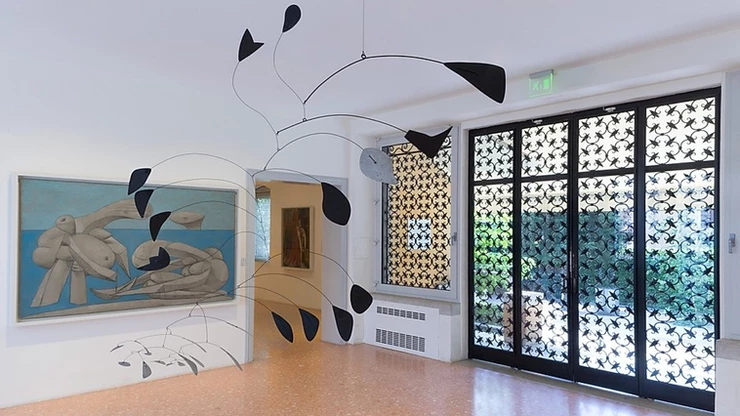
2. Guggenheim Museum: Modern Art
The Peggy Guggenheim Museum is housed in the Palazzo Venier dei Leoni on the Grand Canal. You can click here to pre-purchase a ticket.
The museum holds one of the finest modern art collections in the world. If you love 20th century art, the golden age of modern art, this museum is for you.
Everything is a seminal work of art. Guggenheim’s collection includes works from the major movements of Cubism, Surrealism, Futurism, and Abstract Expressionism.
There’s an entire room dedicated to her beloved Pollack. You can see works by Picasso, de Chirico, Vassily Kandinsky, Joan Miro, Paul Klee, Max Ernst, Magritte, Willem de Kooning, Salvador Dali, and Alexander Calder.
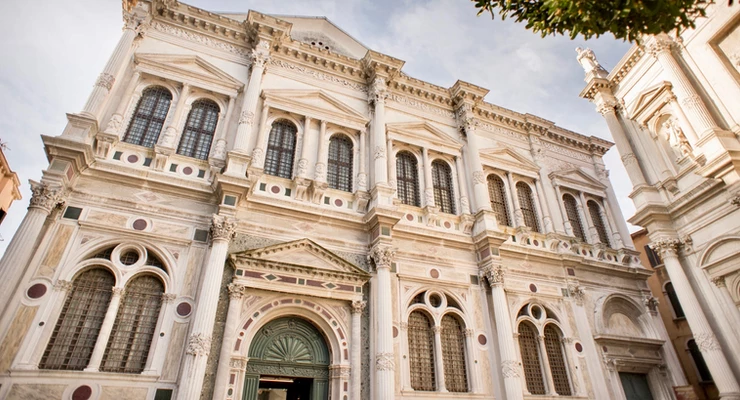
3. Scuola Grande di San Rocco: Tintoretto Frescos
If you prefer classical art to modernism, head to the absolutely breathtaking Scuola Grande di San Rocco . It’s an off the beaten path gem in Venice’s San Polo area.
The school was the seat of the Brotherhood of San Rocco. They were wealthy Venetians dedicated to charitable works.
The school is decorated wall to wall by Venetian Renaissance painter Tintoretto, whose style combines Michelangelo’s draftsmanship and Titian’s use of color.
His cycle fresco in the Chapter Room is considered the “Sistine Chapel of Venice.” Mirrors allow you to see the ceiling paintings without neck strain.

4. Accademia Gallery: Classic Venetian Paintings
Close by the Accademia Bridge, you’ll find the Accademia Gallery . The Accademia is the most important museum in Venice and one of the best in Europe.
It’s housed in the former Santa Maria della Carita church and convent complex. The museum was built, in part, by famed Italian Renaissance architect, Andrea Palladio .
The Accademia houses the world’s most important collection of Venetian painting. The museum is comparable to the Uffizi Gallery’s collection of Florentine works. The gallery has pieces by Veronese, Titian, Tintoretto, Tiepolo, Bellini, Canaletto, Mantagna, and Giorgione.
It also possesses the world’s most famous drawing, Leonardo da Vinci’s Vitruvian Man (which isn’t often on display).
Click here to book a skip the line ticket.
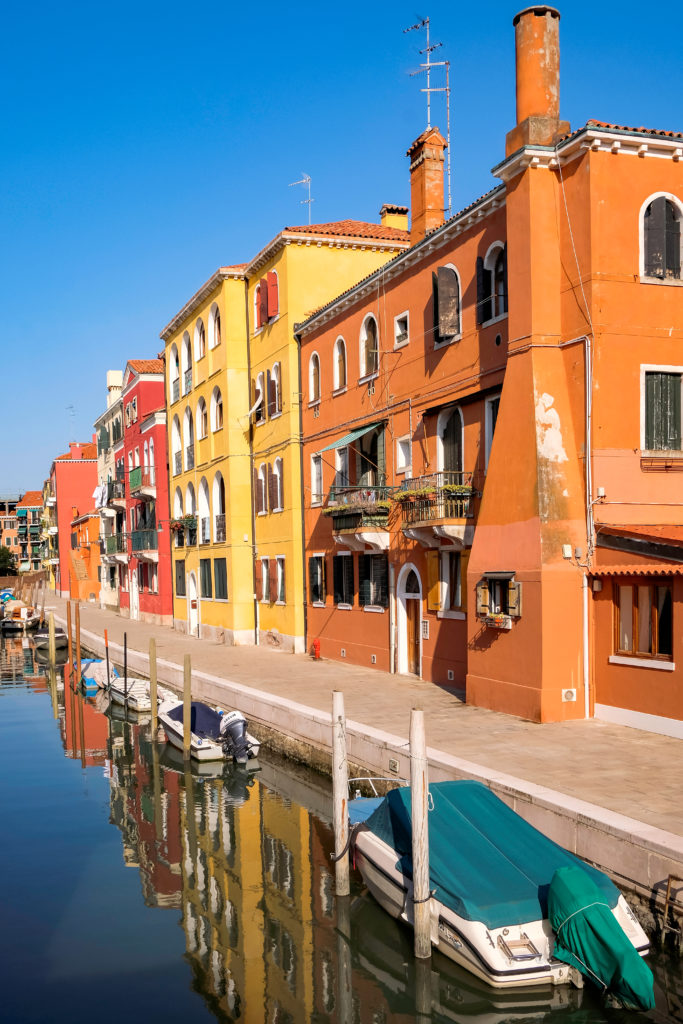
5. Cannaregio
Next, head to the Cannaregio neighborhood for a slice of authentic Venice. Cannaregio is a mostly residential sestiere in northwest Venice that’s largely bereft of crowds. It has elegant faded buildings and hidden churches with Tiepolo paintings.
Cannaregio is chock full of quaint cicchetti bars and gelaterias. Cicchetti is basically the equivalent of tapas, little bite size morsels of goodness that sustain you until the real meal at 8:00 pm.
In Cannaregio’s main square, there’s a Jewish Museum you can pop into for a history lesson. Or, simply wander the maze of narrow walkways, canals, and bridges.
For lunch, try Trattoria Al Ponte del Megio or Il Paradiso Pertduto. Alternatively, sign up for a food tour in this historic off the beaten path neighborhood.
Click here to book a walking tour of what may be the most authentic part of Venice. Another fun thing to do in this less touristy neighborhood is to go stand up paddle boarding or learn to row a gondola .
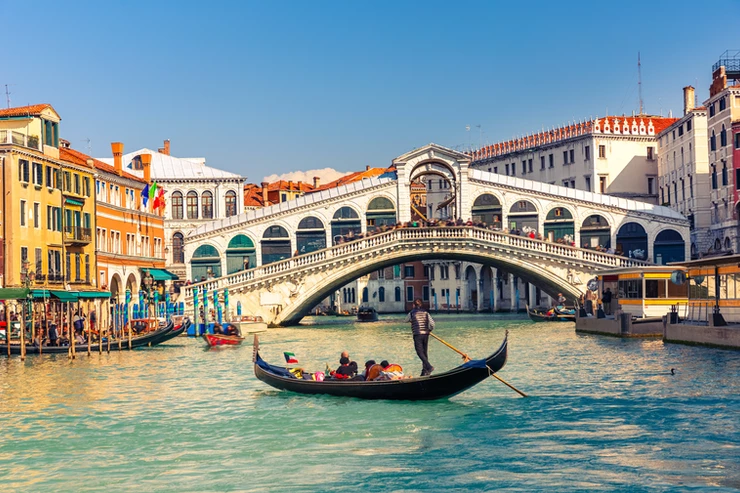
Finish up your afternoon in Venice’s Rialto neighborhood. You can cross the famed Rialto Bridge, the oldest of 4 bridges spanning the Grand Canal.
The area around the Rialto is full of upscale shops. Amidst them, is a fishy smell from the famed fish market.
Finish up your day with a gondola ride at sunset. Or better yet, learn to row a gondola yourself with Row Venice.
For dinner on your last day in Italy, pick a restaurant according to your preferred location.
Try Bistro de Venice (San Marco), l Como (Castello), Locanda Monti (Dorsoduro), or L’Orto dei Mori (Cannaregio). Make reservations!
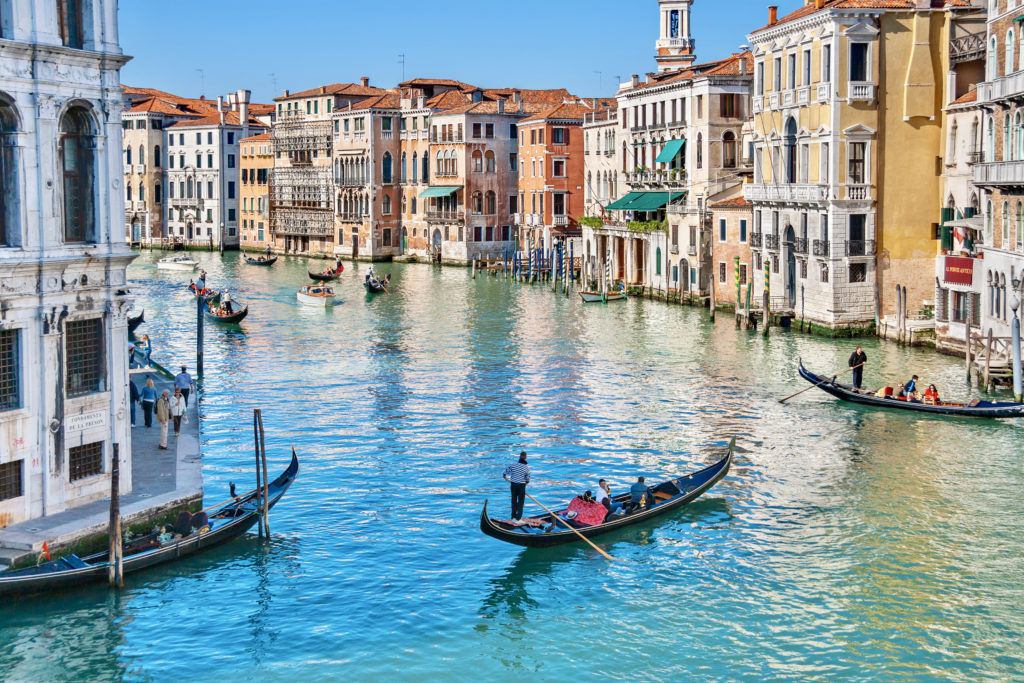
6. Gondola Rides In Venice
Taking a gondola ride in Venice ranks among one of the most dreamed-about experiences for travelers.
This will likely be your biggest expense in Venice if you decide to take one.
Here are some of the sample gondola rides you can go on:
- shared gondola ride across the Grand Cana l
- shared 2 hour gondola ride past main sites
- 30 minute private gondola ride
- 45 minute private gondola ride
- 30 minute private gondola ride at night
- 2.5 hour private city tour + gondola ride
To get a similar experience to the gondola, you can also take a traghetto. That’s a largish gondola-type boat that the locals use to cross the Grand Canal.
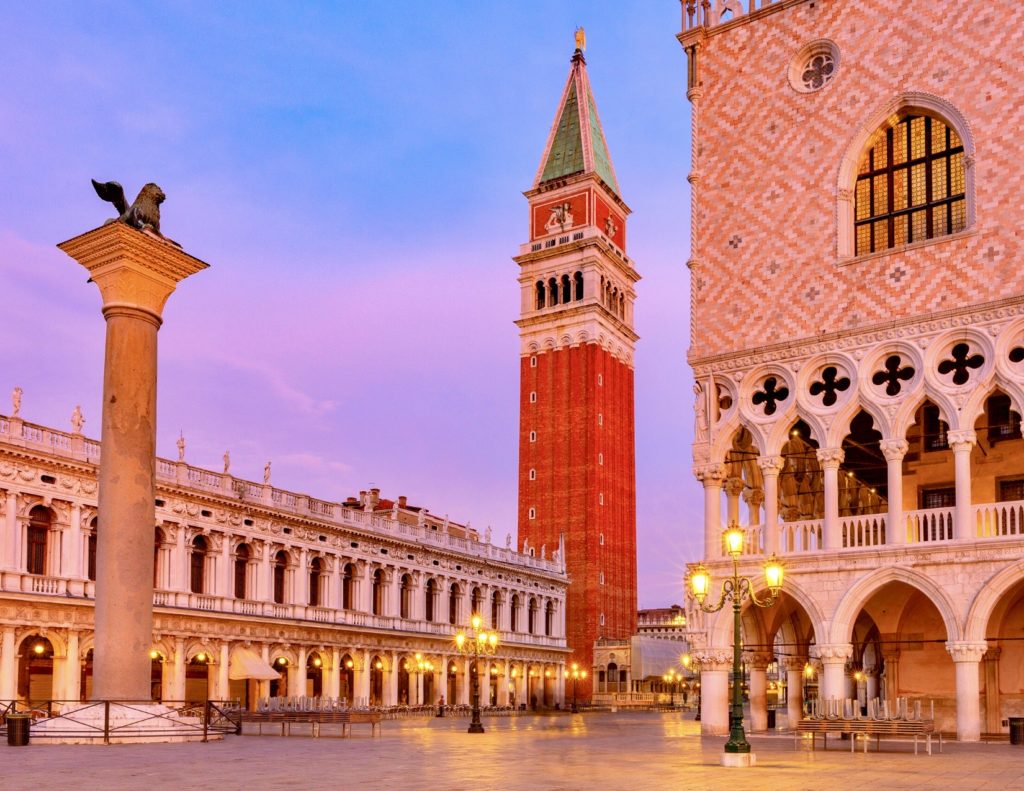
Where To Stay In Venice
There are some amazing hotels in Venice. Be aware that, because Venice is such a dense city, the hotel rooms will be smaller than usual.
If you want a real luxury hotel, opt for Gritti Palac e (elegance and views of the Grand Canal) or the Hotel Danieli (opulent Venetian rooms with a rooftop terrace). If you don’t stay there, I highly recommend you visit for a cocktail or brunch.
If you want a luxe hotel in the center of things, try St. Regis (unrivaled terrace suites above the Grand Canal), Aman Venice (my fave, you’ll feel like an aristocrat), or Bauer Palazzo (elegant Venetian design).
For a cute boutique hotel, try the Novecento , the Palazzo Venar t , or the Hotel Bucintoro .
I hope you’ve enjoyed my 10 days in Italy itinerary. You may enjoy these other Italy travel guides and resources:
- 12 Ways To Spend 1 Week in Italy
- 5 Ways To Spend 1 Week In Sicily
- 10 Day Tuscany Itinerary
- Tips For Visiting Italy
- 7 Day Road Trip From Venice To Milan
- 100+ Bucket List Places in Italy
- Historic Landmarks in Italy
- Most Beautiful Towns in Italy
- Best Museums in Rome
- Hidden Gems in Rome
- Best Museums in Florence
Pin it for later.
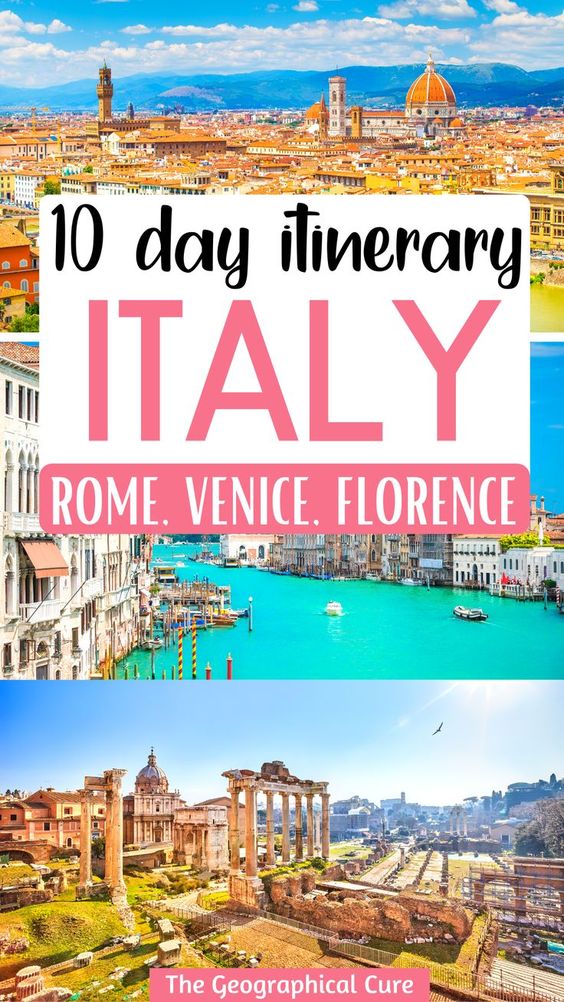
4 thoughts on “The Ultimate 10 Days In Italy Itinerary, For First Timers”
Very helpful, thorough guide!
Thank you so much Chelsea!
I love seeing this! Venice is so different when you slow down and dig a little deeper. Just getting away from the main tourist spots (San Marco and Rialto in particular!) provides a whole different experience. I loved getting up super early, when it’s just you and the city and maybe a few pigeons!
Yes couldn’t agree more! Venice is so much more than St. Mark’s.
Leave a Comment Cancel reply
Save my name, email, and website in this browser for the next time I comment.
Last Updated on July 19, 2024 by Leslie Livingston

Get our Rail Planner app
Plan your trip, get extra discounts, and show your Pass as you go.

Our favorite offseason routes
Chase the sun long after summer ends with these 7 train routes

All about seat reservations
Everything you need to know about booking your seats

Alternatives to Busy Routes
Travel between popular European cities without seat reservations

Through our Chatbot in the bottom right corner.

Ask the Community
Browse questions from fellow Eurail travellers, or ask your own!
- Plan your trip
- Popular Train Routes in Europe
How to Get From Paris to Rome by Train
- Order overview
- Reservations overview
- My Trips & Travelers
- {{translatedTraveler}} {{#promotional}} {{currencySign}} {{standardPrice}} {{/promotional}} {{quantity}}x {{currencySign}} {{finalPrice}}
- Child {{childPasses}}x FREE
- {{translatedPassType}}
- {{translatedValidityPeriodDescription}}
- {{translatedClass}}
- Remove Pass(es)
- {{variant.localizedTravelPackDescription}} {{quantity}}x Free
- {{variant.localizedPassUpgradeDescription}} {{quantity}}x {{currency}} {{price}}
- Your order will arrive by {{expectedDeliveryDate}} 1 x {{currency}} {{price}}
Your cart is empty

Visits to magnificent Paris and the Eternal City of Rome are often at the top of a traveler's to-do list. Although these cities are far apart, they are very well connected by train. Here's everything you need to know to make this wonderful journey for yourself.
Video train route Rome - Paris
Train options for Paris to Rome
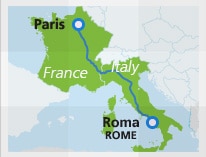
Traveling by high-speed train
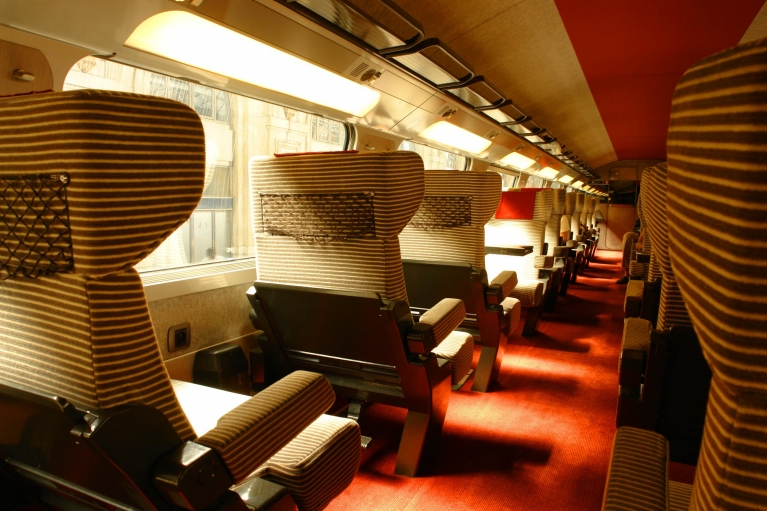
The fastest and most comfortable way to travel from Paris to Rome is by taking the TGV high-speed train . This modern train will whisk you directly to Milan, where a second high-speed train, the Italian Le Frecce , will take you the rest of the way to Rome. For actual travel times, check out our timetable . If you're traveling with a Eurail Pass you don't need to buy a ticket and only pay a small reservation fee. We recommend you book your seats as far in advance as possible.
Traveling by night train and regional train

If you prefer to travel at night, you can take the Intercités de Nuit night train from Paris to Nice, near the Italian border. From there, you can easily make your way to Rome with regional trains. This travel option will take you about 20 hours. For more information and inspiration, check out our blog entry on traveling between Paris and Rome . If you're traveling with a Eurail Pass, you don't need to buy a ticket for the night train and only pay a small reservation fee. We recommend you book your accommodation as far in advance as possible. Reservations for regional trains are not required.
Eurail Passes
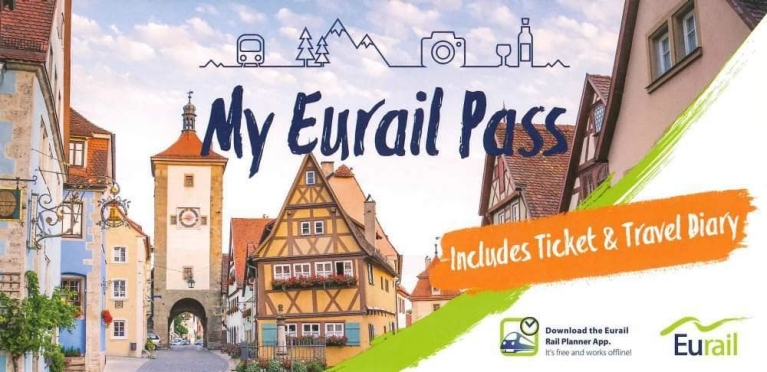
The Eurail Pass is a train pass that lets you travel on nearly every train in Europe. It comes in all shapes and sizes, so you can pick the one that best fits your vacation plans.
Check out our Eurail Passes .
Change of currency
You cannot change the currency once you have a Pass in your cart. Remove the Pass, and then change the currency on the website header.

30 Things to Do and See in Rome
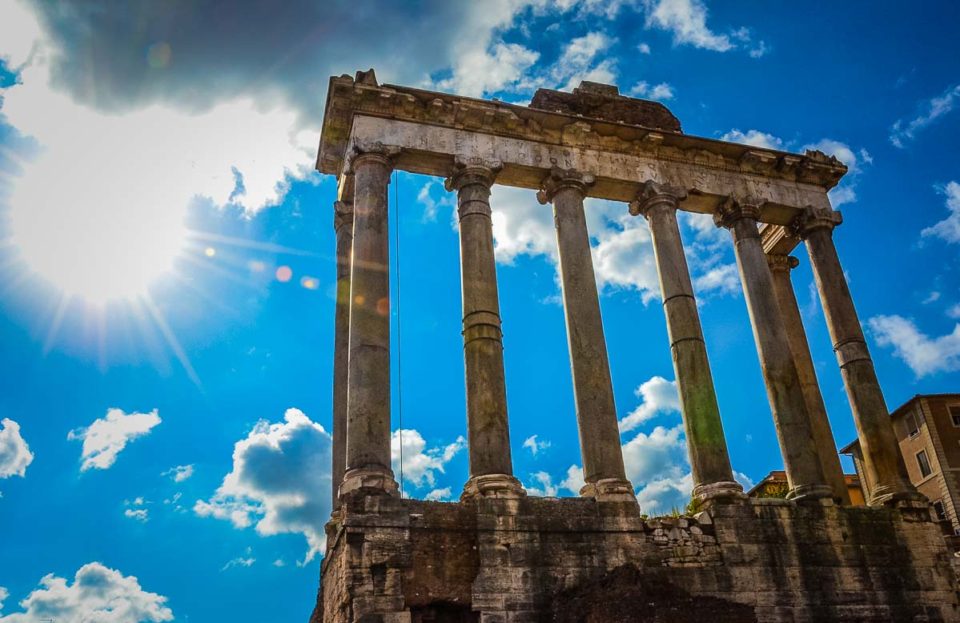
How many days should you spend in Rome?
How many days should you spend in Rome? That's the eternal question. And the real answer is that you'll never run out of things to see in Rome. So allow plenty of time. I spent three months in Rome studying Latin, and Kris and I have been back multiple times. And, there are things we still haven't done that we want to do. We're going back later this year in fact specifically to fill a couple holes in our experience. But, if you're a first timer in Rome, honestly, four or more packed days should do the trick.
For that four day itinerary, here are some suggestions: Day 1, the Vatican with St. Peters, the Vatican Museums, and the Sistine Chapel: Day 2, the Forum and the Palatine Hill, with the Colosseum, the arches of Constantine and Titus; Day 3, the Pantheon, Area Sacra, the Piazza Navona, and the churches in the neighborhood, the Jesu, St. Andrea, Santa Maria Sopra Minerva: Day 4, wander around Trastevere, eating local food while exploring the churches of Santa Cecilia and Santa Maria.
That will give you a basic taste of Rome. But don't stop there. Take more time, if you can. Here's a list of many more ideas to productively fill your visit.
When is the best time to visit Rome?
Another good question: when is the best time to visit Rome? Here's our suggestion: winter. In summer, Rome is absolutely packed with tourists and you'll sometimes end up waiting hours in the hot Roman sun to get into something you want to see. For us, the best months to visit Rome, and Europe in general, are December and January. Failing those months, the shoulder months of October and November are better than summer. Yes, you have to wear a coat, but that's so much better than wasting time in lines. Also, hotels tend to be cheaper in winter.
When you think of things to do in Rome, keep one main thing in mind. Rome is the capital city of Western Art.
Yes, there is great stuff in other European cities. Paris , Madrid , Barcelona , Florence , and Amsterdam , all have their attractions. But for quality and quantity, the Eternal City has no equal. If you wonder why that was, consider that Rome was the capital of the two greatest empires the Western world has ever known: the Roman Empire of the Caesars, and the Christian Church. Both entities were spectacularly wealthy, and their rulers aggrandized themselves constantly by commissioning art.
From the extraordinary Greek sculptures of the golden age of Athens, which were both hijacked and copied, to the Egyptian obelisks sprinkled around the city by the notorious Emperor Caligula, to the high Renaissance of Michelangelo, Rome's rich history has manifested itself the best on its streets, museums, and churches.
So, if you are going to spend three days in Rome and the Vatican City, or three months, here's a list of things you have to see in Rome if you want to see the best. (Obviously, if you're only spending three days in Rome, you'll have to do some choosing.)
Some of them are obvious, so I won't spend much time discussing them. The only caveat I would offer is that you do a little reading up before you go, or at least go with a guide who has done some. Otherwise, you'll miss stuff. And, Rome has, in the words of my former Latin teacher, lots of stuff.
My first suggestion if you're going to visit Rome is to get this book. Before you go, or after you get home, Rome: Art and Architecture is highly recommended. It's not cheap, but it's a fantastic, well illustrated compendium of the art of Rome that will serve as a reference and a remembrance of your trip stay in Rome.
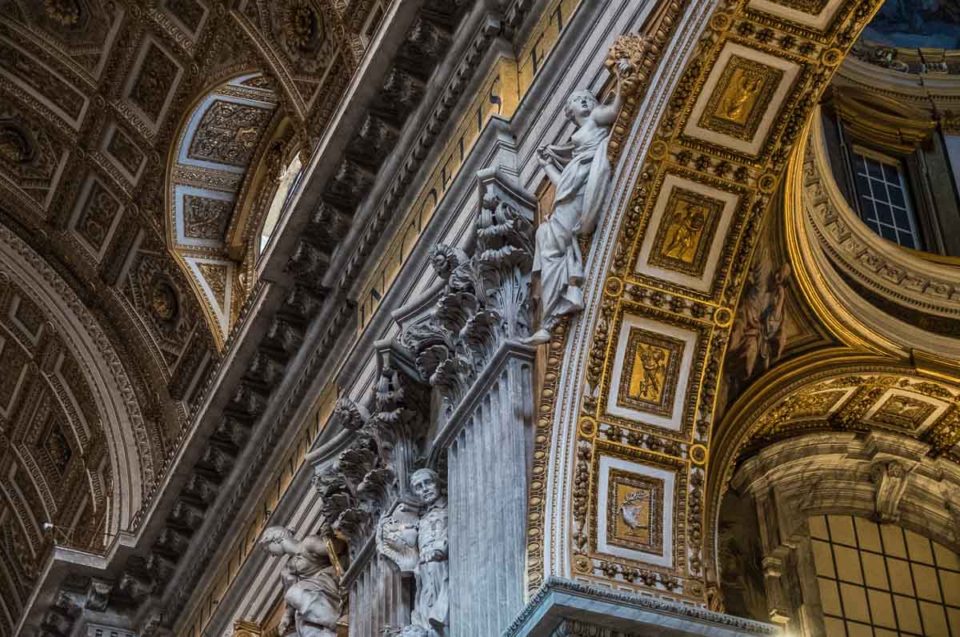
The Obvious Stuff You Have to See in Rome
If you're visiting Rome for the first time, or like us, for about the tenth time, there are sites that reward repeated visits. There is a reason they are among our favorite things to see in Rome. They are tourist attractions, yes, but so much more. Their importance among the plethora of the most iconic landmarks can't be over emphasized. They on the list of the best things to see in Rome for good reason.
The Basilica of St. Peter
Allow plenty of time to see St. Peter's Basilica. It is the biggest church in the world. There is a lot of spectacular sculpture in there, including of course, Michelangelo's early Pieta . Admission is free, but you'll have to stand in line. If you do the Vatican Museums with a guide you can get into St. Peter's too.
The Vatican Museums, including the Sistine Chapel
If you go on your own, you're going to stand in line for more than an hour, go through metal detectors (leave your day pack or purse at the hotel for this one – the Vatican is very picky about security) deal with people trying to butt in front of you, and get generally frustrated trying to get in. But, unlike so many other crowded attractions, these are worth the hassle. If waiting's not your thing, sign up for an early morning tour with Viator and get in ahead of the crowd before the museums open to the public. It costs a bit more, but it's really worth it.
I won't bother to tell you about the Sistine Chapel, because there's lots of information available. My best advice is to look out for a couple of things in the Vatican Museum itself: the painting over an archway by Raphael called The School of Athens, and the ancient statue of the Emperor Augustus. (Yes, there's lots of great ancient stuff in the Vatican Museums.) The guy pointing up in Raphael's painting is Plato, and Raphael's model for Plato was Leonardo da Vinci. By the way, don't take pictures in the Sistine. They ask you not to, not that most don't ignore that request. But, your little phone camera is never going to match the detail you'll get by just buying a book .
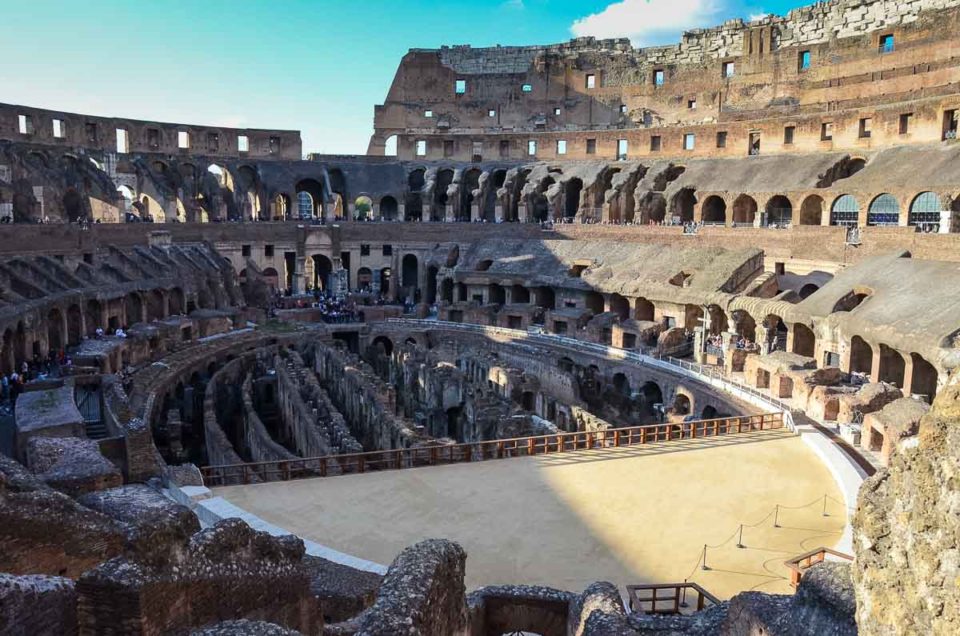
The Colosseum
Maybe the first thing to know is that it wasn't called that by the Romans. They called it the Flavian Amphitheater. It got its nickname from a huge statue of the Emperor Nero that was once near the site. If you're wondering what happened to the statue, pretty much everything to do with Nero, including his over-the-top palace, the Domus Aurea, was pulled down after his death., Anyway, getting into the Colosseum will be a similar experience to getting into the Vatican Museums. Long lines.
My advice, again, is hire a guide. You'll get to skip the lines, and you'll get to learn something on the side. A tip: entry to the Colosseum is on a combined ticket with the Roman Forum across the street. The lines for the Forum ticket booth are always much shorter. Get your ticket there, see the ancient ruins of the Forum and Palatine Hill, then go over to the Colosseum and skip the ticket line. Or, even better, get skip the line tickets to the Forum and Colosseum here.
While you're in Rome, have your photo taken in front of one of the Roman landmarks by a professional photographer. Check out Smiler.co to schedule your session.
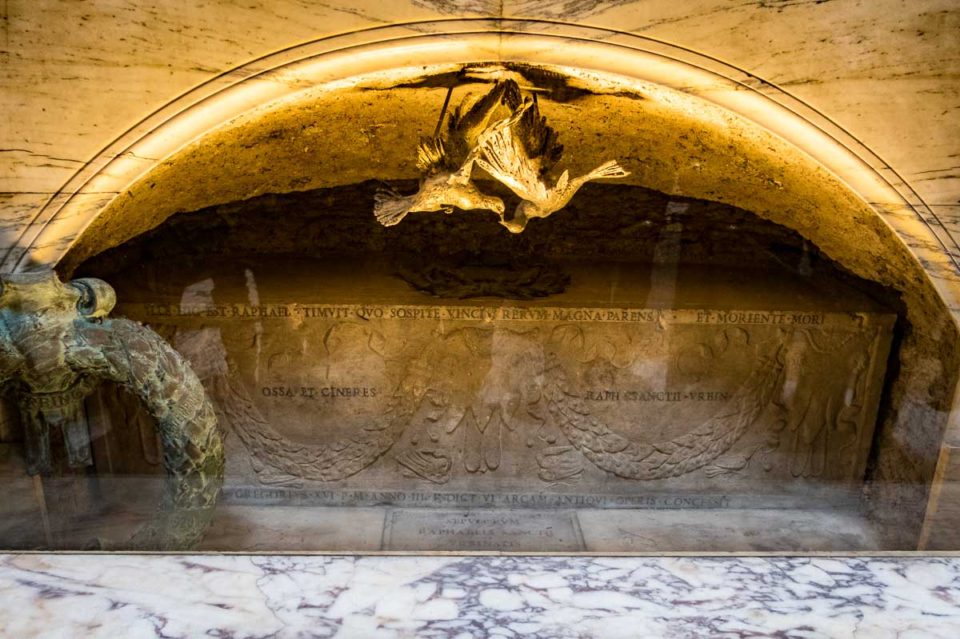
The Pantheon
This is my favorite building of ancient Rome. And not just because you can walk right into it. When you get there, look up at the dome and its open oculus and ask yourself, how the hell did the Romans make that dome across that span 2000 years ago? The interior was long since converted from a Roman homage to all their gods – Pantheon means “all the gods” in Greek, and no, I don't know why a Roman temple had a Greek name – but most of the stuff there now is pretty mundane. With one exception, the tomb of the painter Raphael.
The tomb is very simple, but the inscription above it is singularly poetic. In Latin, it's ILLE HIC EST RAPHAEL TIMUIT QUO SOSPITE VINCI RERUM MAGNA PARENS ET MORIENTE MORI . In my English: “Here lies Raphael. While he lived, Mother Nature feared she would be outdone. When he died, she feared she'd be undone.” I always stand in front of his tomb for several minutes on every trip to Rome. The inscription on the facade of the building, by the way, says “Marcus Agrippa, son of Lucius, when he was Consul for the third time, built this.” Romans used lots of abbreviations on their inscriptions.
Other attractions of Ancient Rome
The forum and palatine hill.
The Forum (on a combined ticket with the Colosseum) is downtown Ancient Rome. Temples of the Vestals, Saturn, the reconstructed Curia building, massive tumbled ancient ruins, the site where the funeral of Julius Caesar was held. They're all there. It's a lot to take in, and a guide is highly recommended or you'll miss a lot. Be sure to ask about the Cloaca Maxima, the big sewer, beneath your feet. The Romans had public plumbing and waste disposal more than 2000 years ago, which is more than you can say for the rest of Europe. Also, be sure to walk up the hill to the Palatine Hill and see the ruins of the home of Augustus and its wall paintings. It's mostly ruins, but some interesting bits are there. Walk to the edge of the hill, too, and survey the view over the enormous Circus Maximus. Think Ben Hur .
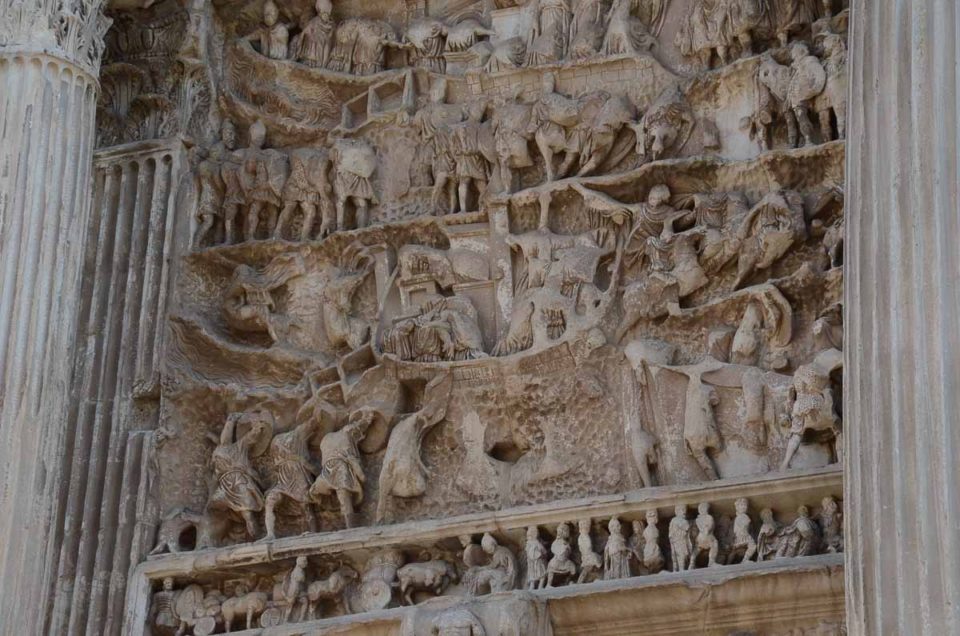
The Arches of Titus and Septimius Severus
The Arch of Titus, aside from being an impressive monument, has an interesting story. Titus was the general who sacked Jerusalem and there are graphics on his arch at the base of the Palatine Hill that show Roman soldiers carrying off the menorah and other spoils of the Temple of Jerusalem. The Arch of Septimius Severus, just next to the Temple of Saturn, has lots of scenes from that emperor's conquest of the pesky Parthians.
Arch of Constantine
Not too different in concept from the other two arches, but Constantine's arch, just across from the Colosseum, is notable for its size and for its architectural departure from the earlier styles. Constantine's arch also incorporates art from arches of other Roman emperors such as Hadrian. In that sense, it's a bit of a hodge-podge of reliefs. Again, it would be good to see this with a guide who can point out all the disparate elements. Probably worth noting, too, is that Constantine was the emperor who finally legalized Christianity in the Roman Empire.
Trajan's Column
Like the arches, Trajan's Column , which is up the road apiece from the Colosseum, is a commemoration and a propaganda piece for the Emperor Trajan and his victories over the Dacians. (Is there anyone the Romans wouldn't fight?) Of particular interest is the spiral construct up the column which graphically tells the story of Trajan's accomplishments.
The Ara Pacis
You have to like the Ara Pacis , the Altar of Peace, built by the Emperor Augustus, because it, in contrast to the other monuments erected by his successors noted above, celebrates the Pax Romana, the Roman Peace. It's a beautiful work, almost completely preserved, and now enclosed in a building and under glass. You can get up very close and see the iconography of Augustus both as a political leader and as a high priest offering sacrifices to the gods. Perhaps the finest example of the power of images used by the emperors to get their message across to a mostly illiterate population. (If that sort of stuff interests you, you should get the book The Power of Images in the Age of Augustus . Art as propaganda. Fascinating.)
The Circus Maximus
You have to use your imagination when you look at the Circus Maximus today, because nothing is left of the structure. But the area is still open and you can certainly make out the track that once hosted the famous chariot races. Today, the track is mostly used as a running course for fit Romans. As you go by the north side, you can look up past the enormous arches that support the Palatine Hill and imagine the Roman nobles peering down at the races.
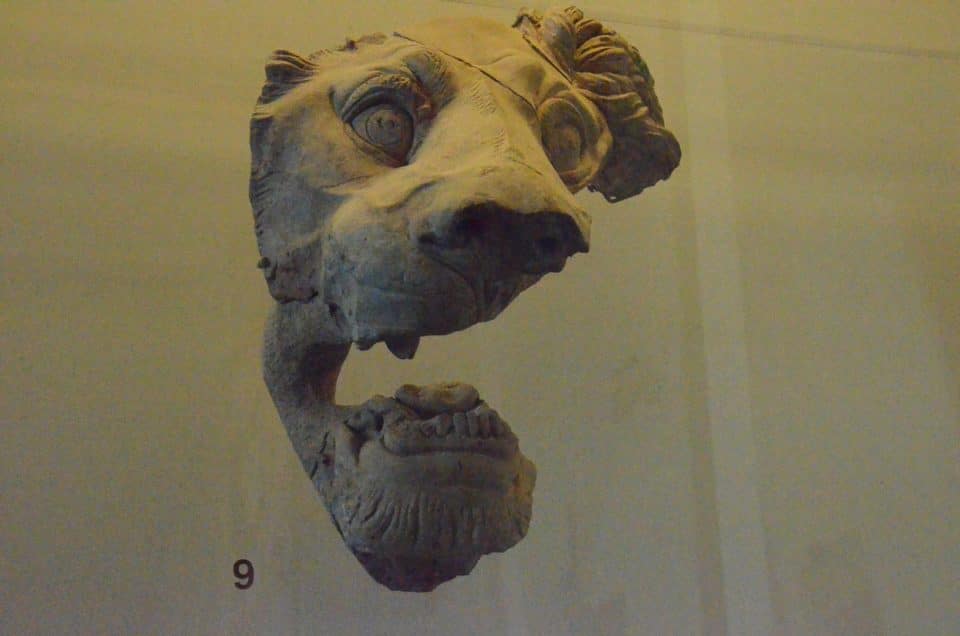
The Capitoline Museums
If you're interested in the art of the ancient Romans, you can't skip this museum on the Capitoline Hill above the Forum. It's relatively small museum just up the hill at the end of the Forum, and holds mostly decorative arts that would have been in Roman home in ancient times. Reliefs, busts, statues, frescoes, and mosaics. They're all there.
The Area Sacra at Largo Argentina
Just about two blocks from the Pantheon is one of the most recently discovered areas of ancient Roman ruins. There are four ancient temples in a row in a large square at the intersection of two busy Roman streets. The temples are in a state of ongoing exploration and restoration. And, you can often stand behind the barricades on the border that surrounds the site and actually watch the archeologists go about their business. The area, oddly, is also a sanctuary for stray Roman cats. The cats have been rounded up and neutered, and then released again into the site.
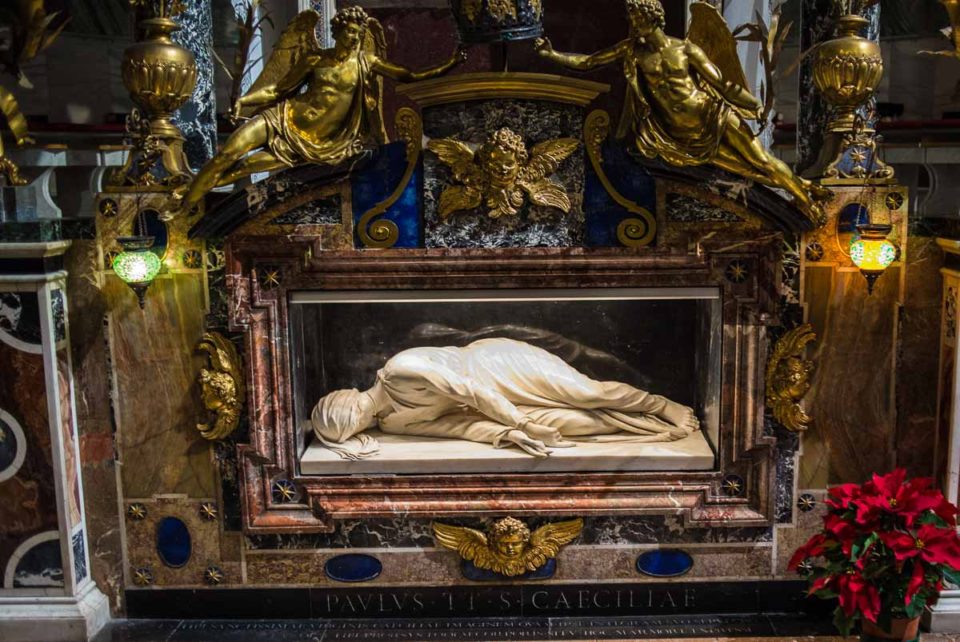
The Churches of Rome you should see
Santa cecilia in trastevere.
Santa Cecilia in Trastevere was a lucky discovery for me. I had no idea it was there, but when I wandered in, I discovered what's come to be my favorite sculpture in Rome. Saint Cecilia was a young Roman noble woman who was martyred because she became a Christian. As the story goes, it took three blows of a Roman sword to sever her neck. The sculpture depicts her lying serenely in death, her head turned away, but the slice on her throat visible upon close inspection.
Santa Maria in Trastevere
Santa Maria in Trastevere is one of the oldest churches in Rome. It anchors the main square of the Trastevere neighborhood, and overlooks lots of charming side streets with lots of traditional family restaurants and cafes where you can spend your time after wandering around the church and gazing lovingly at the spectacular mosaics.
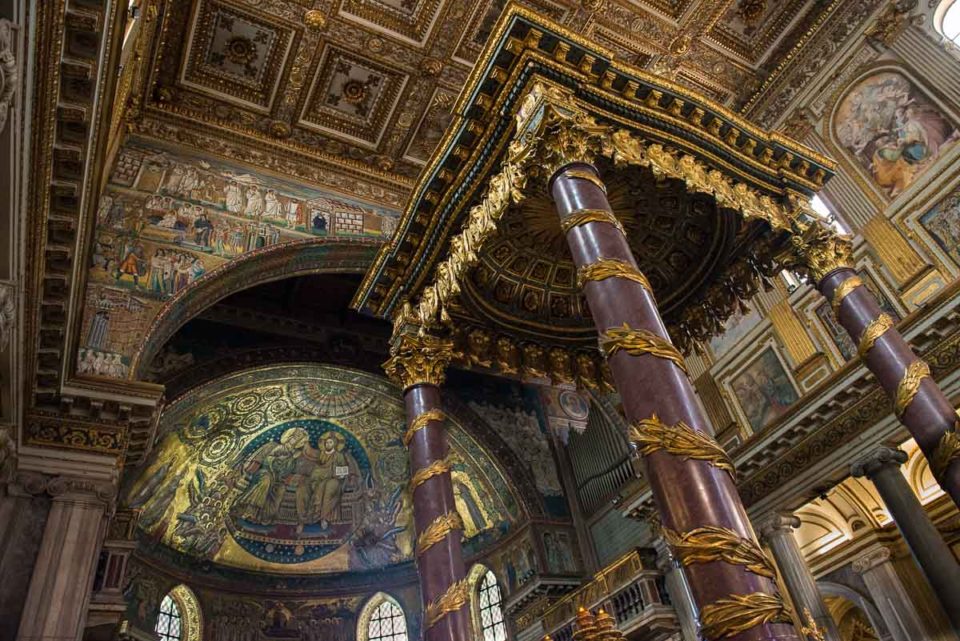
Santa Maria Maggiore
One of the Vatican churches “outside the walls” of the actual Vatican territory, it is the largest church dedicated to Mary in Rome–hence the name. It was built originally in the 5th Century A.D. which also makes it one of the oldest churches in Rome. Since then it's been expanded and redecorated, but like so many of the older churches in Rome, the original Byzantine altar mosaics have been preserved.
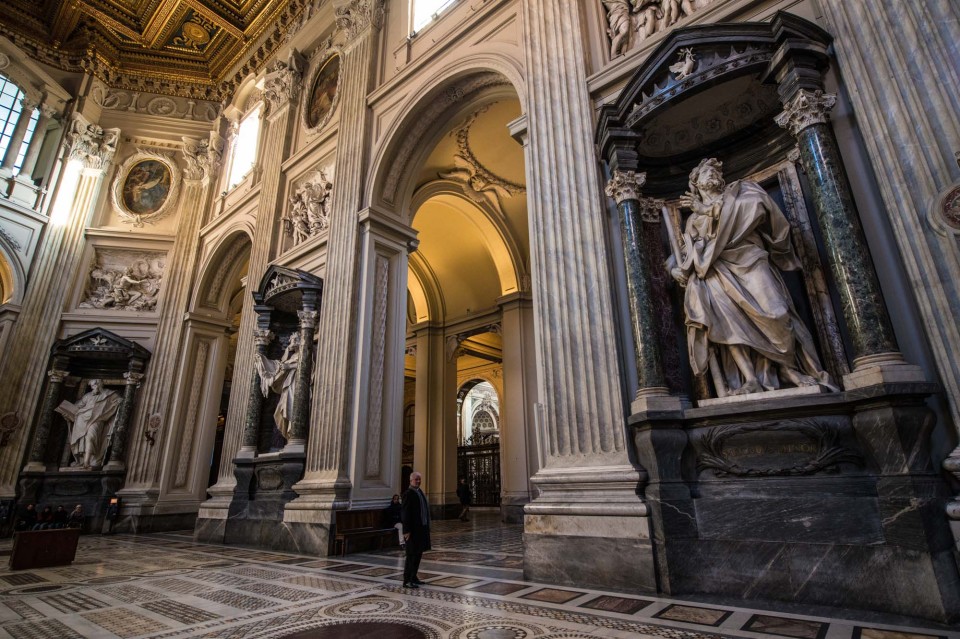
Saint John Lateran
Saint John Lateran, another of the Vatican churches outside Vatican City, is the actual Papal church. It contains the seat of the Pope in a separate hall. It is the oldest church site in Rome and was originally built in the 5th Century. But after a disastrous fire and an earthquake or two is now an 18th Century Baroque masterpiece. It is among the largest churches in Rome. Of particular note is the massive nave, lined with huge statues of the 12 Apostles, plus Saint Paul. Awesome, in the true sense.
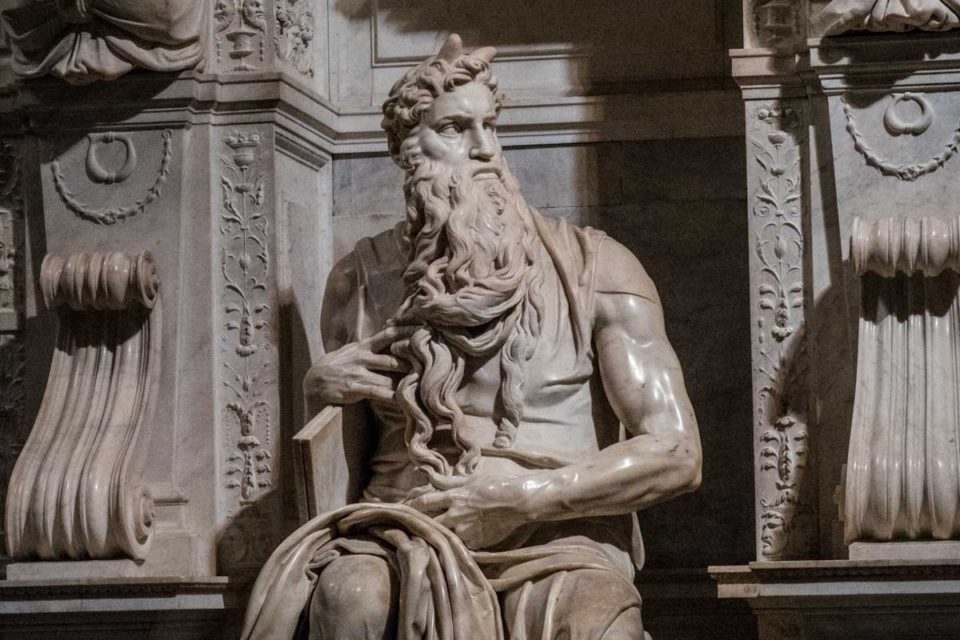
Saint Peter in Chains
There's a lot of history behind this church, but the main reason to go there is it's the home of Michelangelo's famous statue of Moses–the one with the horns coming out of his head, which is the result of one of the classic translation mistakes of history. It seems Saint Jerome, who translated the Bible from Hebrew to Latin, confused the words for radiated light with horns. So, Michelangelo took his cue from the Bible, and you have an incredible Moses–with horns.
Santa Maria Sopra Minerva
There are three reasons to make note of this church, which is very near the Pantheon. It got its name “on top of Minerva” because it was built on top of a Roman temple to the Egyptian goddess Isis. And the Church guys got it wrong and thought is was a temple of Minerva. Or so say the archeologists. It has a statue by Michelangelo of the risen Christ next to the altar, and a Michelangelo always makes a church worth a visit. And third, just outside the front door is a charming elephant, designed by Bernini, with an Egyptian obelisk on his back. On the base of the elephant's perch is an inscription that I rather like. Another bit of Latin poetry that translates as “You, whoever you are, sees that figures of wise Egypt sculpted on the obelisk are being carried by an elephant, the strongest of beasts, and understand that it is a symbol of a strong mind sustaining solid wisdom.”
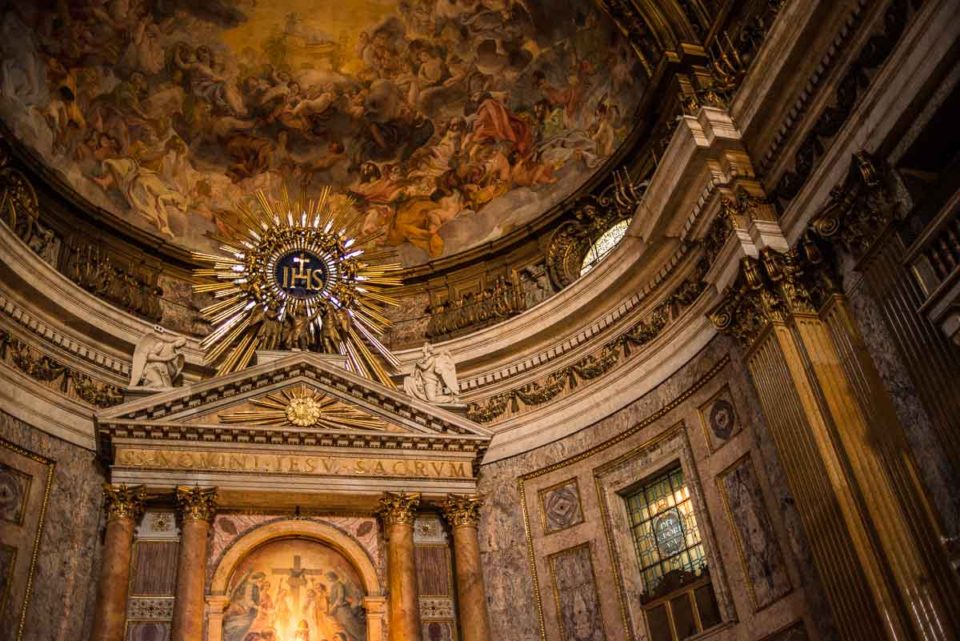
Saint Andrew and the Jesu
The churches of Saint Andrew (Sant Andrea) and the Jesu (Holy Name of Jesus–the Jesuit order's church) are right next to each other and are both among the best examples of what the pure Baroque style combined with very wealthy donors have wrought in Rome.
The Galleries, Public Art, and other stuff you should see in Rome
The borghese gallery.
The Borghese Gallery is one of the most famous art galleries in the world. It is housed in the former Villa Borghese Pinciana. The gallery houses a considerable part of the paintings, sculpture and antiquities collected by Cardinal Scipione Borghese, the nephew of Pope Paul V, who reigned at the beginning of the 17th Century. The Galleria Borghese features paintings by Caravaggio, Raphael, Titian, Perugino, among others. Sculpture in the gallery includes works by Bernini and Canova. What I like about the Borghese is that admission is restricted, so it's never too crowded. Be sure to buy your tickets in advance.
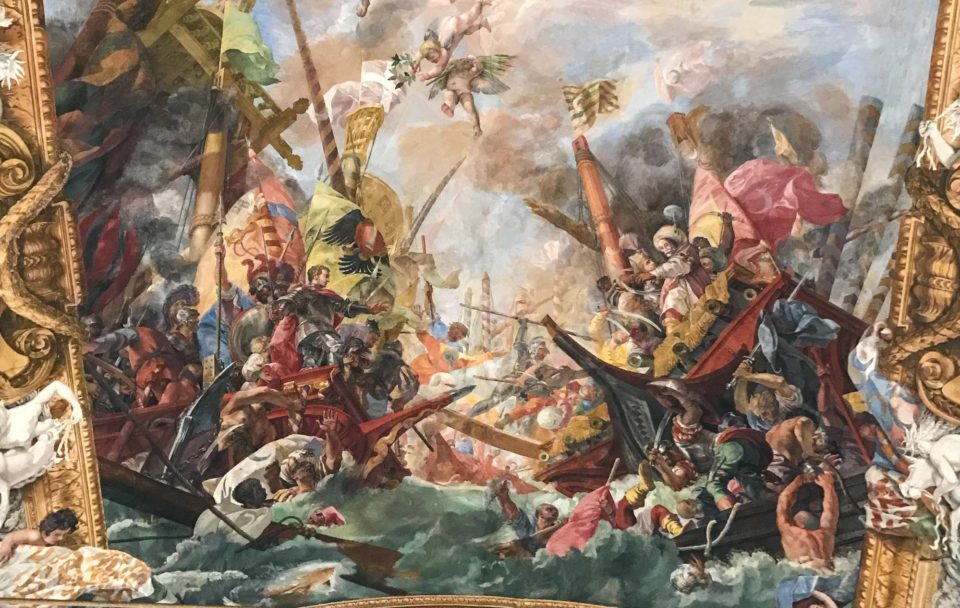
The Colonna Palace
The Palazzo Colonna is a baroque masterpiece and the home is a work of art in itself. The grounds of the Palazzo are right near Piazza Venezia at the top of the Roman Forum, opposite the Colosseum. Palazzo Colonna stands out from almost every other historic Roman church, museum, or palace, because it is still a residence. It's also a museum with limited visiting hours, but four Colonna brothers and their families currently live in the palace. So when it comes to guided tours of Rome, this is an exceptional one. You will need to book in advance on the Palace's website or with Get Your Guide .
The Trevi Fountain
This fountain ( Fontana di Trevi ) was the subject of a sappy 1950s movie, Three Coins in a Fountain , yes, but also figured in Federico Fellini's masterpiece La Dolce Vita . It's pretty, and it's the largest fountain in Rome. It's been completely scrubbed and restored in the last few years, so worth a look. Hey, you may not think its the best, but it is good. And, the €3000 per day tossed into the fountain subsidizes food for the poor of Rome.
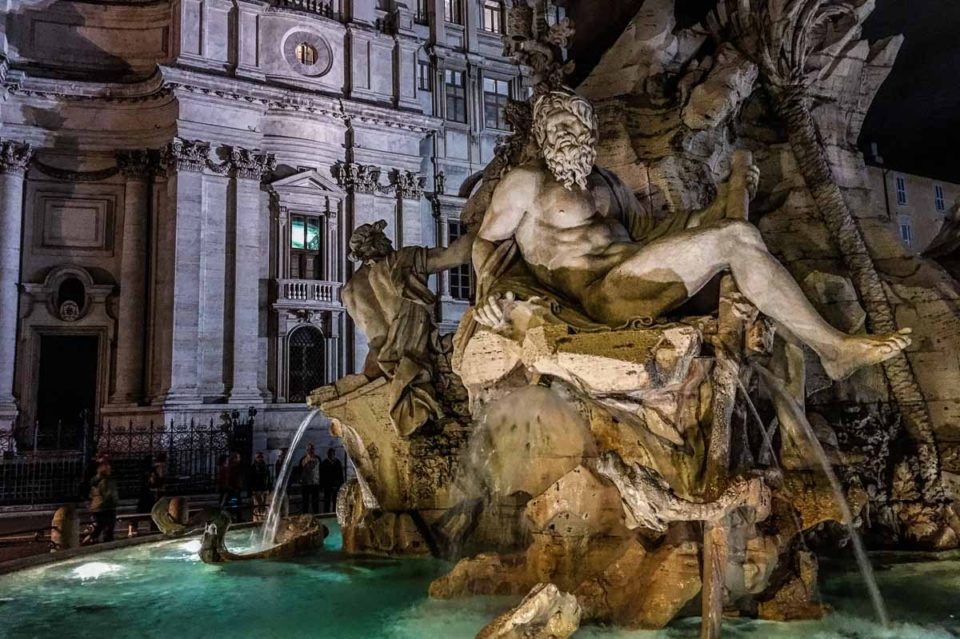
Piazza Navona with fountain and palace and church
My real favorite fountain in Rome is the Fountain of the Four Rivers ( Fontana dei Quattro FIumi ) by the great sculptor Gian Lorenzo Bernini in Piazza Navona. This fountain also was featured in a movie, Angels and Demons. But don't hold that crappy movie against it. The Piazza was built on the foundations of the stadium of the Roman Emperor Domitian, which you can see from its shape. It's sort of a smaller Circus Maximus. The Piazza also has two other smaller fountains and the Church of Saint Agnes in Agony and the Pamphili Palace, which is now the Embassy of Brazil.
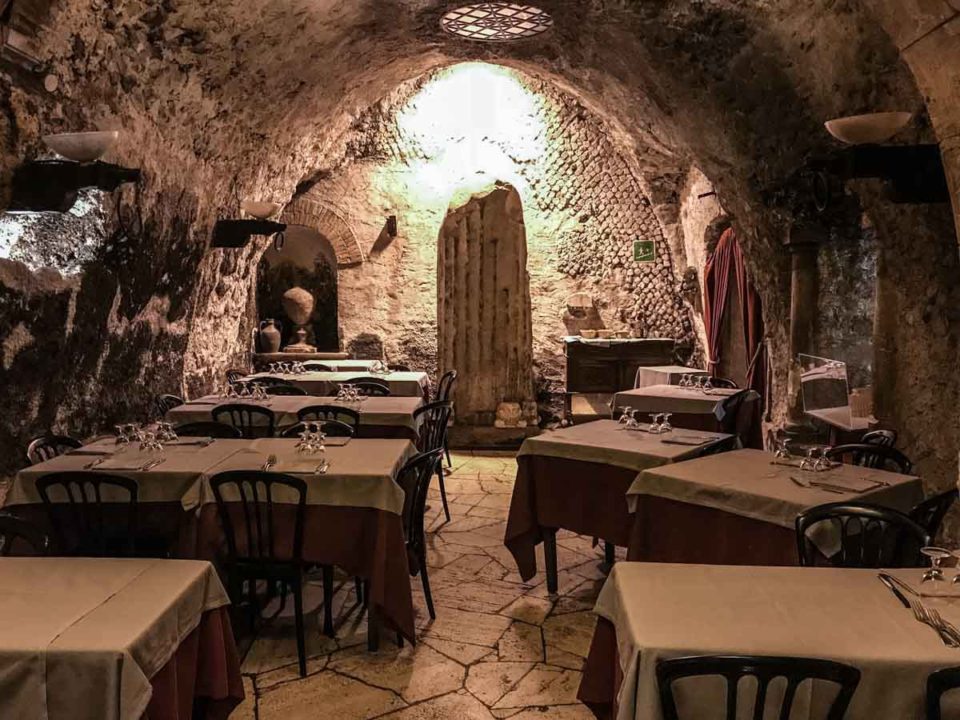
Campo de' Fiori
A former meadow, thus the name which means “field of flowers” the Campo hosts a daily flea market, which really is the best reason for a visit. But, even cooler among the historic sites of Rome, is the Ristorante da Pancrazio, just off the plaza. The Pancrazio, aside from having the best fiori de zucca (fried zucchini flowers) I've ever eaten, sits atop the ancient Theater of Pompey, which is where Julius Caesar was assassinated. The owners of the restaurant have taken it upon themselves to excavate the theater under their restaurant, and if asked, will gladly show it to you.
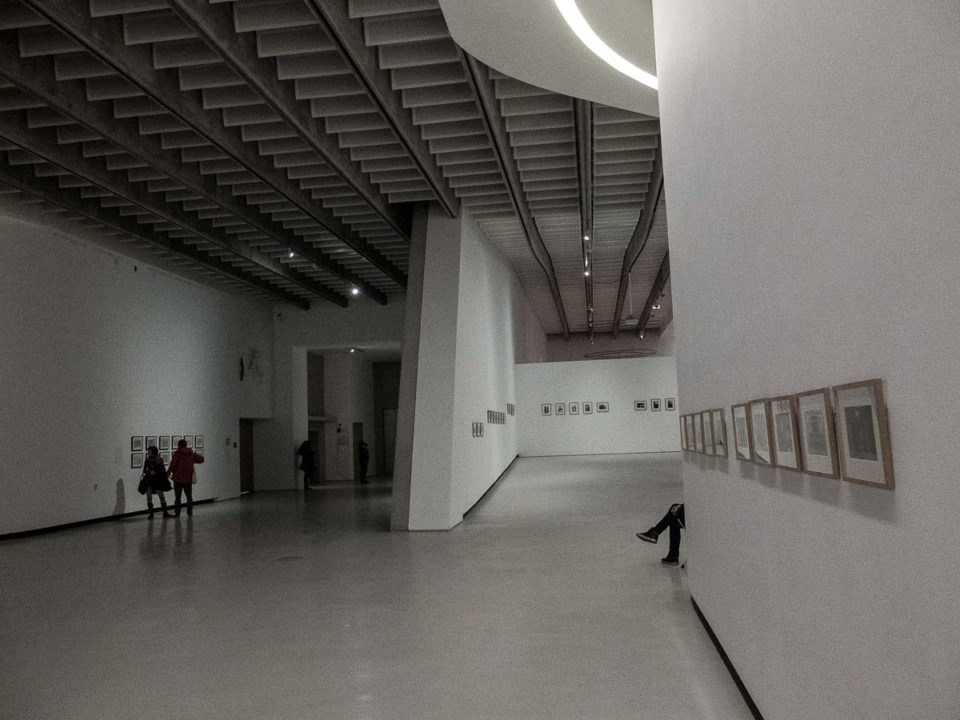
MAXXI Museum and surrounding architecture
North of the Piazza del Popolo, the upper reaches of classic Rome, is the so called “modern” part of Rome . That's the area that hosted the 1960 Summer Olympics and now sports the modern music complex and the extraordinary MAXXI Museum of modern art and design. If all that ancient and church stuff begins to be too much, this is the place to retreat.
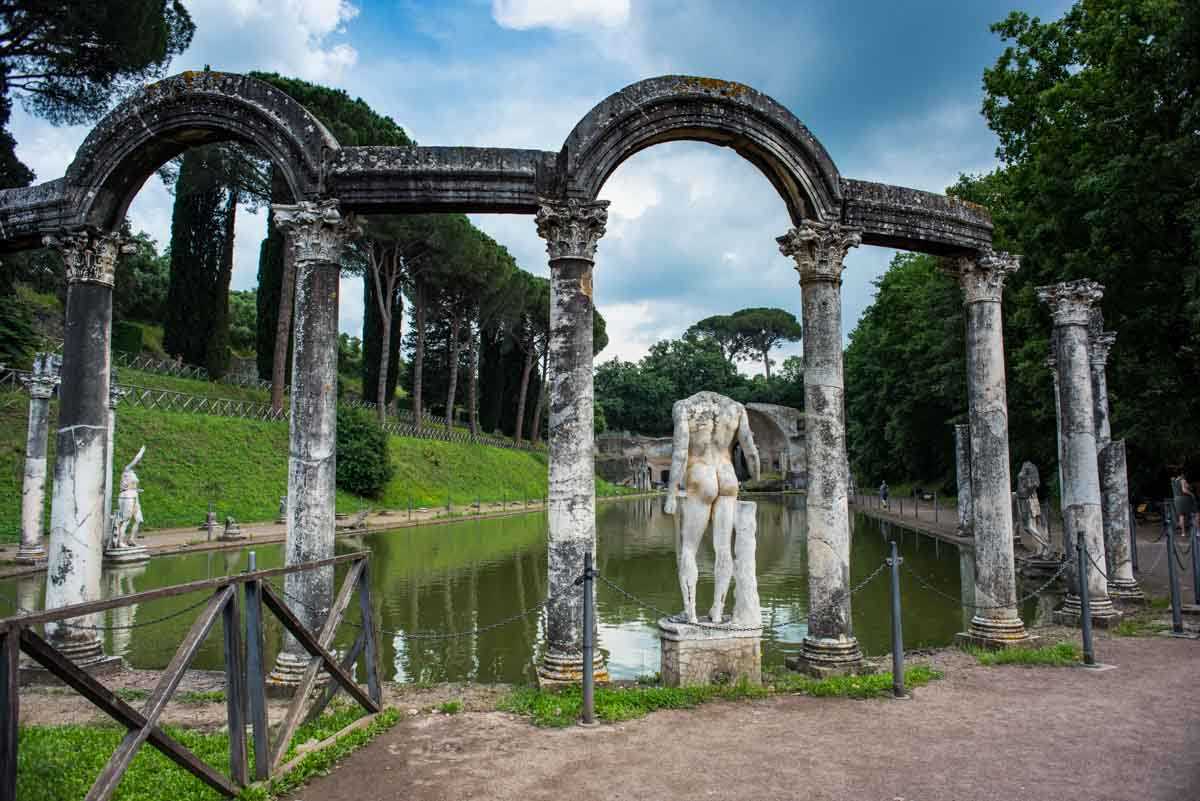
Day trips from Rome
Tivoli gardens and hadrian's villa.
Take the train out to Tivoli from the Tiburtina Station. They leave about every hour and, last I looked, cost about €6 round trip. Start with the gardens at the Villa d'Este, which were originally a private retreat and are now a State museum. You can take a tour of the expansive gardens, with their fountains, or just wander around on your own. But leave time for Hadrian's Villa . The Emperor Hadrian reigned during the 2nd Century and presided over the greatest land expanse of the Roman Empire. Like so many Romans before and after him, he sought refuge from the heat of Rome in the hills of Tivoli. The Villa is about 5 kilometers from the Gardens, so take a taxi. You can arrange a tour of Hadrian's Villa and the Tivoli Gardens here .
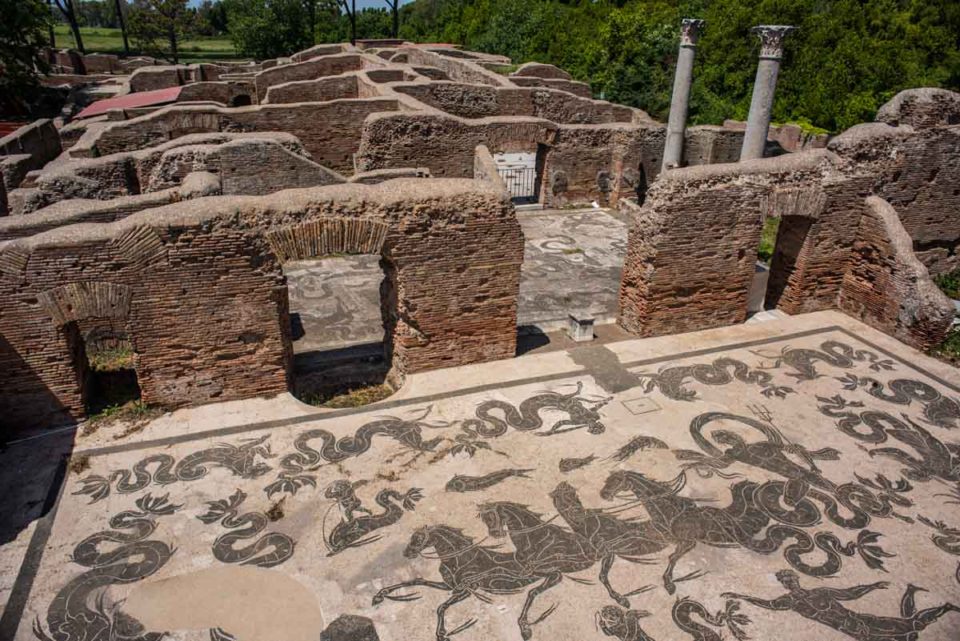
Ostia Antica
Ostia was the port of ancient Rome, and the visit again involves a short train trip. Ostia is very well preserved and will probably give you a much better idea of what a Roman town looked and functioned like than all your wandering about the city of Rome would ever do. Be sure to note the shops, which often have floor mosaics depicting the business. The attached museum has a trove of sculptures from the city and adjacent necropolis. Your entry ticket (€12) gets you in there, too.
The best way to get to get to Ostia Antica is to take the TrenItalia train from Tiburtina (or any other intermediate stop such as San Pietro or Trastevere) to the Ostiense stop. (You can also take the Metro to Porta San Paulo, if that's easier for you.) From the Ostiense train stop, you can walk right over to the adjacent Metro station (Porta San Paulo) and take the Metro train to Ostia Antica. From the Ostia Antica station, it's about a 500 meter walk to the entry of the ancient city. Look for the signs that say Scavi , which is Italian for excavations. The train tickets are a couple of euros, and the Metro tickets are €1.50 each way. You can buy both at machines in the stations. The journey will take about half an hour.
Best walks in Rome
Centro storico.
This is your landmark tour of the old city center and will encompass many of the archaeological sites named above. Piazza Navona, the Pantheon, Santa Maria Sopra Minerva, the Area Sacra, the Campo de' Fiori, the Tiber Island, the Ara Pacis, and more. Also there are many churches that I haven't picked out for particular notice above. But they're worth seeing, and you'll miss them unless you walk. The Chiesa Nuova and Saint Augustine are worth including on your amble.
The thing about walking around Trastevere is not to hit all the landmarks, (other than Santa Maria and Santa Cecilia.) But just get lost, wander into the shops, including the best English language bookstore in Rome on Via del Moro, and just enjoy the ambiance. Stop on the street and have a coffee. And don't have a cappuccino unless it's breakfast. (Also, don't order a latte unless you want a glass of milk.) I suppose I should also mention that the word Trastevere means “across the Tiber,” just in case you were wondering.

From Trastevere over the Janiculum Hill to the Vatican
If you want to get the best views of all of Rome from above, walk up to the top of the Janiculum Hill on the west side of the Tiber River. You can just sort of meander north from Trastevere, keep going up, and you'll eventually get to the top of the hill and the monument to Garibaldi, who united the city states of Italy in the 19th Century. Keep going down the north side of the hill and you'll find you're at the back side of the colonnade that fronts Saint Peter's Basilica. You used to be able to walk right into the square, but now, because of security, you'll have to walk around to your right to the main entrance and go through the hordes of tourists, like everyone else.
What to eat in Rome
You can eat some very expensive meals in Rome, but if you avoid the obvious tourist locations, you can do much better, and for less. Here are my three general recommendations of where to find your real Roman food.
Pasta and salad in any of the small family owned restaurants on the Via dei Pastini just off the Pantheon plaza. There's also a great ice cream store at the end of the block.
Pizza in any small pizzeria in Trastevere. Look for the lines. It's usually cheap and good. Have the wine. Alternatively, take the Devour Tours food tour of Trastevere . You won't be disappointed.
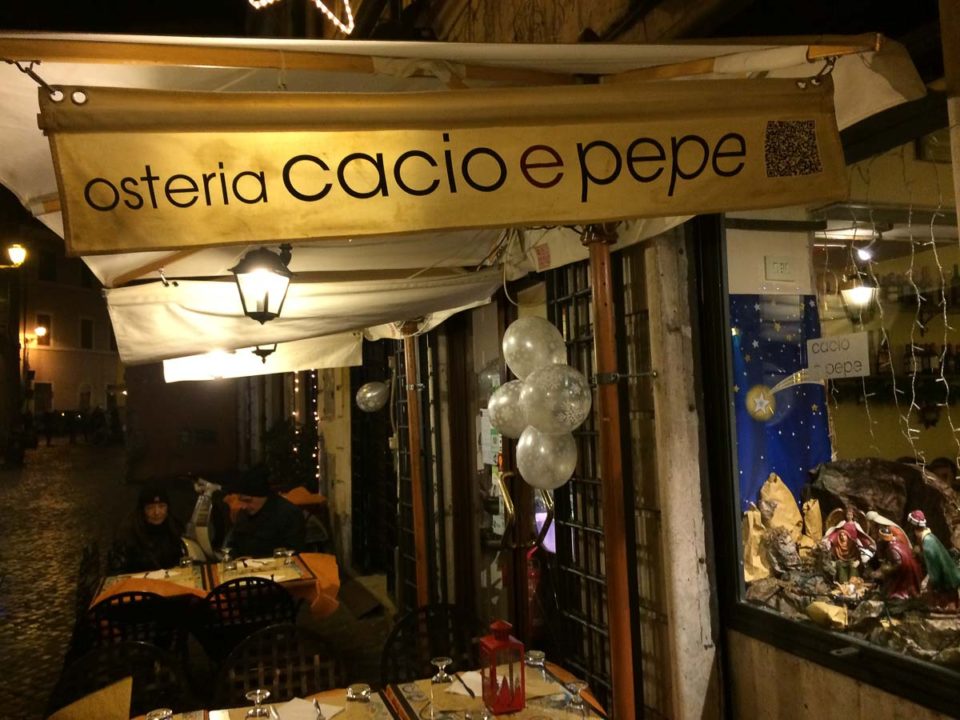
Cacio e pepe , (literally cheese and pepper,) the most traditional Roman pasta dish, at Osteria Cacio e Pepe in Trastevere. Have the tart white wine with the cheesy pasta. Trust me on this.
Many of the list of things to see and do in Rome are UNESCO World Heritage sites in Italy . Click the link to see a full list of Italian World Heritage sites with links to the ones we've visited.
Where to stay in Rome
We like to stay in one of three areas in Rome: the Historic District around the Pantheon and Piazza Navona, the area north of the Vatican, which has several nice family-owned small hotels, and, our favorite, Trastevere. They all have their advantages, mostly centering around what you're planning on visiting. I should also add, that the area around the main train station, Termini, has cheaper accommodations than the others I've mentioned, but the neighborhood is a little more business and a bit noisier than the other's I've mentioned. Of course, all Rome is noisy, but what big city isn't?
Get a Rome hotel from Booking.com
Tours in Rome
If you're not a lifelong student of Roman art, culture, and history, like we are, (or even if you are) you'd do well to take a guided tour of some of the things that interest you.
Also, here are some Rome tours from Get Your Guide, with some links to tours into some attractions that will hook you up with a tour guide and let you skip the lines. That alone is worth the price of admission.
Context Travel offers tours that are led by PhD level historians and art historians. If you are interested in getting into the deep background of Rome, a Context Travel tour of Rome is probably for you .
Up Your Travel Skills
14 thoughts on “30 things to do and see in rome”.
Thanks for sharing this article on Rome. Our daughter has visited on multiple occasions, but doesn’t like taking a camera. While she walks away with plenty of memories, we can only try to picture what she describes. Now we see it for ourselves.
Speaking as someone who has a camera on hand pretty much every time I go out the door I find that a little silly. But then I’m sort of a nerd that way. I’d suggest getting her a small camera for her next birthday, and telling her she’s out of the will unless she sends you at least one shot per day.
We’re getting to do a return trip to Rome next month, but it’s with a small group tour about which I’m having a bad attitude. We took our then teenage boys there in 2004. We did two Scala Reale private tours (now Context Travel), one of the Vatican Museum and one of the Colosseum and Roman Forum. They were each 4 hours and shockingly, our sons were reasonably engaged the entire time. Tom, as always, your photos are even better than the real thing.
As always, Suzanne, you’re too kind. We’ve done a couple of Context Travel tours, in Rome, too. They’re always great. On the last one, we had our four-month-old grandson with us. He was bored to death. My favorite memory of that tour was when my son changed his diaper in a corner of one of the salons of the Colonna Palace. The guard was horrified…but what can you do?
Your photos are lovely, Tom. Especially the opening one! I must say, though, that I think I’d be disappointed by the starkness of the MAXXI Museum in contrast to all the glory and grandeur of the ancient art of Rome.
You can only take so much Baroque, so MAXXI is a welcome break of something different. Also, there’s no Christian imagery to be found either. So that’s a break, too.
Amazing images! Love them. It was fun reading all about Rome and nodding at some of the things you mentioned. We did eat at the Osteria and yes, the food was really good. I also have to take not of the place with the best fried zucchini flowers so we can try it the next time. It better be good because l think my MIL makes the best ones in Rome. In fact, I think we will bring her to try them :-).
Kemkem, I’m sure the zucchini flowers probably aren’t as good as your mother in law’s version, but to be sure, why don’t you give me her address? I’ll be in Roma again in May and probably should stop in and do the taste test.
Haha!!! She would totally enjoy that :-)
Just want to say, I had the fiori de zucca at Pancrazio last night. Spiced up with a little bit of anchovy. Pretty darn good.
I’m glad you mentioned cacio e pepe – one of my favourite dishes and almost a reason to go to Rome in itself! You managed to find some churches I haven’t been to, and I haven’t seen the “modern” quarter either.
Cacio e Pepe is a great reason to go to Rome all by itself. The pizza in Trastevere is right up there, too. Thin crust with prosciutto e funghi.
This bike tour of Rome is great for a first-day introduction to the city. It covers all the basics and includes a delicious outdoor lunch. Zip around the city on e-bikes without riding a bus. Our extremely knowledgeable guide was a Dutch teacher in Rome. They have tours in a variety of languages as well. https://www.topbikerental.com/nuovosito/eng/tour-rome/rome-one-day.php
If you ask me, biking in Roman traffic would be terrifying. I think I’ll stick to the footpaths.
Leave a Comment Cancel reply
Save my name, email, and website in this browser for the next time I comment.

IMAGES
VIDEO
COMMENTS
You can take a vehicle from Provence to Roma Termini via Chateau Arnoux St Auban, Briancon, Cesana Torinese - Piazza Vittorio Amedeo Ii, Oulx - Stazione Ferroviaria, and Oulx-Cesana-Clav.-S. in around 11h 25m. Alternatively, you can take a vehicle from Provence to Roma, Autostazione Tiburtina via Bd des Tilleuls, Gare SNCF, and Marseille, Gare ...
You can take a train from Roma Termini to Provence via Bardonecchia, Bardonecchia Station, Campo Smith Bardonecchia, Briancon, and Chateau Arnoux St Auban in around 11h 25m. Alternatively, you can take a bus from Roma, Autostazione Tiburtina to Provence via Marseille, Gare de Marseille-Saint-Charles, Gare SNCF, and Bd des Tilleuls in around 16h ...
You can take a train from Aix En Provence to Roma Termini via Marseille St Charles, Nice Ville, Ventimiglia, and Milan Centrale in around 13h 35m. Alternatively, BlaBlaCar Bus operates a bus from Marseille, Gare de Marseille-Saint-Charles to Roma, Autostazione Tiburtina 4 times a week. Tickets cost $60-90 and the journey takes 12h 30m.
The fastest trains from Aix-en-Provence to Rome take around 11 hours and 49 minutes, covering a distance of approximately 602 kilometres. On weekdays, the first train leaving Aix-en-Provence is scheduled to depart at around 05:48. The last departure is usually at around 19:17. On Saturdays and Sundays, trains leave Aix-en-Provence at around 05: ...
While you can explore some of Provence's towns and cities, such as Aix-en-Provence, in just 1-3 days, the best way to see this varied region is by taking 5-7 days to discover more of the natural beauty and hidden villages. With 5 days in Provence, you can explore some of the region's main attractions, tour the famous lavender fields and ...
Top cities between Aix-en-Provence and Rome. The top cities between Aix-en-Provence and Rome are Florence, Nice, Genoa, Bologna, Pisa, Siena, Assisi, Lucca, Orvieto, and Parma. Florence is the most popular city on the route. It's 6 hours from Aix-en-Provence and 3 hours from Rome. Show only these on map.
Trains from Aix-en-Provence to Rome cover the 373 miles (602 km) long route taking on average 18 h 40 min with our travel partners like SNCF (3). Normally, there is 1 train operating per day. You can get the cheapest train tickets for this route for as low as $194 (€164), but the average price of train tickets is $194 (€164).
Flights from Aix-en-Provence to Rome. Use Google Flights to plan your next trip and find cheap one way or round trip flights from Aix-en-Provence to Rome.
Tickets are valid for all forms of public transportation in Rome (bus, metro, tram and local train). 8. Take your bus ticket straight to the beach. Speaking of public transportation, your €1.50 ...
Aix-en-Provence TGV to Rome by train. It takes an average of 16h 29m to travel from Aix-en-Provence TGV to Rome by train, over a distance of around 380 miles (611 km). There are normally 12 trains per day travelling from Aix-en-Provence TGV to Rome and tickets for this journey start from £75.58 when you book in advance. First train.
How to Get There. Most visitors fly into Rome's Leonardo da Vinci/Fiumicino Airport (FCO). From there, you can take a 30-minute non-stop train to Termini, the central station, and take a taxi ...
In fact, many of the best restaurants won't open until at least 7:30 p.m. Lunch: 12:30 pm - 2:30 pm. Dinner: 7:30 pm - 11 pm. To avoid eating in an empty restaurant and to really make the most of your evenings in Rome, try and fit in with them and eat a bit later. Around 8 pm is a good time to sit down.
There are 6 ways to get from Aix-en-Provence to Rome Rome by plane, train, bus, night bus, or car. Select an option below to see step-by-step directions and to compare ticket prices and travel times in Rome2rio's travel planner. Recommended option. Fly • 4h 44m
Avignon to Cassis by train - typical journey time 1h 30m. Change trains at Marseille. Cassis is the quintessential Provençal portside town. Overlooked by towering cliffs and the Château de Cassis, and blessed with beautiful beaches, it is a relaxing and picturesque base for travelling around Provence by rail.
Encounter glorious monuments and ancient ruins dating as far back as at least the 3rd century B.C. Marvel at the stunning Romanesque- and Gothic-style architecture, medieval churches, picturesque squares, Baroque fountains, and world-class museums.Besides having an almost unlimited number of sights and attractions to see, Rome is famous for its traditional Roman food and wine and its vibrant ...
The first thing to try is this: (your city) to Paris one-way. Rome to (your city) one-way. Compare that to this: (your city) to Paris round-trip. (your city) to Rome round-trip. If the two one-way flights are within US$150 or so of either round-trip, then they are your best option.
West of Avignon, a huge stone structure — part bridge and part aqueduct — heralding the greatness of ancient Rome. Rock-top village sitting in the shadow of its ruined medieval citadel. History-rich city, famous for its medieval bridge and Gothic Palace of Popes. Leafy café-lined streets and the best-preserved Roman theater in existence.
Europe - Transportation between Rome and Provence - My DH and I are taking our granddaughter on a graduation trip to Rome and Paris, with a visit to Provence (specifically Avignon, Arles, St. Remy ...
Let's jump right into the details so you can spend less time worrying and more time enjoying everything this gorgeous city has to offer. Table of Contents. 15+ Rome Travel Tips. 1. When to visit the Vatican City. 3. Be prepared to have a late dinner. 4. Wear modest clothes in church.
Provence and the French Riviera in particular are so treasure-filled that you may barely do more than skim the surface in a week. So relax and savor Avignon, Aix-en-Provence, St-Tropez, or Cannes—among other alluring destinations—saving the rest for another day. ... Travel times can be cut considerably thanks to France's excellent road ...
10 Days In Italy Itinerary Day 1: Rome. Begin in Rome, the magnificent Eternal City.. Since you will be in the city for 3 days you may want to invest in the Omnia Rome and Vatican Pass, which gives you skip the access to several museums and free public transport.. Rome is a breathtaking concentration of history, art, and charm — every corner could fill your eyes, your camera, and your ...
Travel inspiration and top planning tips for getting around Italy. Read the travel guide 5 delightfully under-the-radar French towns you need to visit. Go beyond Paris, the Alps, the Loire chateaux and the French Riviera. Read the travel guide Getting to Rome from the airport. Get the details in Rome2Rio's airport-to-city travel guide
Traveling by high-speed train. The fastest and most comfortable way to travel from Paris to Rome is by taking the TGV high-speed train. This modern train will whisk you directly to Milan, where a second high-speed train, the Italian Le Frecce, will take you the rest of the way to Rome. For actual travel times, check out our timetable.
The Arches of Titus and Septimius Severus. The Arch of Titus, aside from being an impressive monument, has an interesting story. Titus was the general who sacked Jerusalem and there are graphics on his arch at the base of the Palatine Hill that show Roman soldiers carrying off the menorah and other spoils of the Temple of Jerusalem.